Program for International Student Assessment (PISA 2018) Main Study
Program for International Student Assessment 2018 (PISA 2018) Main Study
Appendix A - PISA 2018 Main Study Recruitment Materials
Program for International Student Assessment (PISA 2018) Main Study
OMB: 1850-0755
PROGRAM FOR INTERNATIONAL STUDENT ASSESSMENT 2018
(PISA 2018) recruitment for Main Study
OMB# 1850-0755 v.21
Carried over from the Approved Appendix A-2 (OMB# 1850-0755 v.20)
with additional student and school coordinator materials and respondent reminders added on pages 44-118
APPENDIX A
RECRUITMENT MATERIALS
February 2018
revised March 2018
TABLE OF CONTENTS
School PISA Letter – Public Schools 5
PISA 2018 Brochure – Public Schools 7
PISA 2018 FAQ for school administrators – Public Schools - Front Page 9
PISA 2018 FAQ for Teachers – Public Schools 11
PISA 2018 FAQ for Students – Public Schools 13
PISA for Public Schools Information Sheet 15
PISA 2018 Timeline of Activities – Public and Private Schools 17
Teacher Invite Email – Public Schools 18
School PISA Letter – Private Schools 19
PISA 2018 Brochure – Private Schools 21
PISA 2018 FAQ for school administrators – Private Schools – Front Page 23
PISA 2018 FAQ for Teachers – Private Schools 25
PISA 2018 FAQ for Students – Private Schools 27
PISA for Private Schools Information Sheet 29
Teacher Invite Email – Private Schools 31
School Coordinator Email announcing E-Filing for Main Study 32
Instructions for School Coordinators to E-file student and teacher lists 33
Step 1: Identify ALL students at your school who meet the eligibility criteria 34
Step 2: List each of the eligible students along with their demographic information 34
Submitting the PISA Electronic Student File (E-File) 35
Step 3: Match Values to PISA Codes. 35
Step 4: Verify your E-file. 36
Preparing the PISA Electronic Teacher File (E-File) 40
Step 2: List each of the eligible teachers. 40
Submitting the PISA Electronic Teacher File (E-File) 41
Step 3: Match Values to PISA Codes 41
Step 4: Verify your E-file. 42
Online Teacher Data Checks. 43
PISA E-file reminder email to School Coordinator 44
Email to School Coordinator when student and teacher samples are complete and Student Tracking, Teacher Tracking Form/School Logon Forms/Teacher Logon Invitations have been posted to MyPISA.us 45
PISA 2018 – Teacher Questionnaire Invitation 46
PISA2018– Principal Questionnaire Invitation 47
PISA Questionnaire Login Pages - School 48
PISA Questionnaire Login Page - Teacher 49
PISA 2018– Principal Reminder 1 50
PISA 2018–Teacher Reminder 1 51
PISA 2018– Principal Reminder 2 52
PISA 2018–Teacher Reminder 2 53
PISA 2018–Teacher Reminder 3 54
PISA 2018–Teacher Final Reminder 55
PISA School Coordinator Manual Cover Letter 56
PISA 2018 School Coordinator Handbook 57
MyPISA project website for School Coordinators and schools 109
PISA 2018 Student Presentation Video 118
[Date]

State PISA Letter
[Title] [Name First] [Name Last]
[Title/Department]
[State]
[Address 1]
[Address 2]
[City], [State] [Zip code]
Dear [Title] [Name Last]:
The United States is participating in the 2018 Program for International Student Assessment (PISA). As the largest international education study in the world, PISA measures the reading, mathematics, and science literacy of students nearing the end of compulsory education. PISA results are used by researchers and policymakers to chart national progress against international standards and the educational progress of our global economic peers and competitors. The United States and more than 70 other countries and education systems will participate in the next round of PISA. Some schools in your state have been randomly selected to participate in PISA in fall 2018, and I am writing to ask your agency to support the participation of those schools.
PISA provides comparative information on the performance of U.S. students in reading, mathematics, and science with their peers in other countries. In 2018, PISA will also include an assessment of students’ financial literacy.
PISA is described in more detail in the enclosed materials. PISA is conducted in the United States by the National Center for Education Statistics (NCES) in the U.S. Department of Education and is administered by Westat, a firm in Rockville, Maryland. The U.S. Office of Management and Budget (OMB) has approved the data collection under OMB# 1850-0755. For information on the confidentiality of the data collected, please see the enclosed FAQ. While participation in this study is voluntary, we ask your agency to support participation in your state so that the United States has a sample of schools that is representative of the entire country.
Within the next few weeks, a representative of Westat will contact sampled school districts and schools to discuss participating in PISA. We are in contact with your state assessment director and NAEP State Coordinator to try to ensure that we are not conflicting with other state efforts and to help districts and schools understand how PISA fits in with other data collections conducted by NCES. The administration of PISA is also coordinated with NAEP and other NCES data collection activities to minimize burden and duplication. In the meantime, if you have questions about the study, please do not hesitate to call David Kastberg at 1-301-294-3811 or send an email to [email protected]. You may also get more information by contacting Patrick Gonzales at NCES at 415-920-9229 or [email protected], or by visiting the PISA website at http://nces.ed.gov/surveys/pisa.
Thank you for your time and support.
Sincerely,
Peggy Carr, Ph.D.
Acting Commissioner
cc: [State assessment coordinator name]
Enclosures
The National Center for Education Statistics (NCES), within the U.S. Department of Education, conducts the Program for International Student Assessment (PISA) in the United States as authorized by the Education Sciences Reform Act of 2002 (ESRA 2002, 20 U.S.C. §9543). All of the information provided by school staff and students may be used only for statistical purposes and may not be disclosed, or used, in identifiable form for any other purpose except as required by law (20 U.S.C. §9573 and 6 U.S.C. §151). The U.S. Office of Management and Budget has approved this data collection under OMB# 1850-0755.

School District PISA Letter
[Date]
[Title] [Name First] [Name Last], [Title/Department]
[School District]
[Address 1]
[City], [State] [Zip code]
Dear [Title] [Name Last]:
The United States is participating in the 2018 Program for International Student Assessment (PISA). As the largest international education study in the world, PISA measures the reading, mathematics, and science literacy of students nearing the end of compulsory education. The United States and more than 70 other countries and education systems will participate in the next round of data collection. PISA results are used by researchers and policymakers to chart national progress against international standards and the educational progress of our global economic peers and competitors. Some schools in your district have been randomly selected to participate in PISA in fall 2018, and I am writing to ask your agency to support the participation of those schools.
PISA provides comparative information on the performance of U.S. students in reading, mathematics, and science with their peers in other countries. In 2018, PISA will also include an assessment of students’ financial literacy.
Schools participating in PISA will receive $250, and each school’s PISA school coordinator (a school staff person designated to liaise with PISA staff) will receive $200 as a thank you for the coordinator’s time and effort. Selected teachers will receive $25 for completing a questionnaire. Each student who participates will be eligible to receive $25 and a volunteer service certificate of 4 hours from the U.S. Department of Education.
PISA is conducted in the United States by the National Center for Education Statistics (NCES) in the U.S. Department of Education and is administered by Westat, a firm in Rockville, Maryland. The U.S. Office of Management and Budget has approved the data collection under OMB# 1850-0755. For information on the confidentiality of the data collected, please see the enclosed FAQ. While participation in this study is voluntary, we ask your agency to support participation in your district so that the United States has a sample of schools that is representative of the entire country.
Within the next few days, a representative of Westat will contact the following school(s) in your district that have been selected for the main study data collection: [LIST SAMPLED SCHOOLS HERE…]. Please include the PISA assessment window (October 1 to November 23, 2018) on your district test calendar.
If you have any questions, please do not hesitate to call 1-888-638-2597 or send an email to [email protected]. You may also get more information about this study by contacting Patrick Gonzales at NCES at 415-920-9229 or [email protected], or by visiting the PISA website at http://nces.ed.gov/surveys/pisa.
Thank you for your time and support.
Sincerely,
Peggy Carr, Ph.D.
Acting Commissioner
Enclosures
The National Center for Education Statistics (NCES), within the U.S. Department of Education, conducts the Program for International Student Assessment (PISA) in the United States as authorized by the Education Sciences Reform Act of 2002 (ESRA 2002, 20 U.S.C. §9543). All of the information provided by school staff and students may be used only for statistical purposes and may not be disclosed, or used, in identifiable form for any other purpose except as required by law (20 U.S.C. §9573 and 6 U.S.C. §151). The U.S. Office of Management and Budget has approved this data collection under OMB# 1850-0755.

School PISA Letter – Public Schools
[Date]
[Title] [Name First] [Name Last], [Title/Department]
[School District]
[Address 1]
[City], [State] [Zip code]
Dear [Title] [Name Last]:
The United States is participating in the 2018 Program for International Student Assessment (PISA). As the largest international education study in the world, PISA measures the reading, mathematics, and science literacy of students nearing the end of compulsory education. The United States and more than 70 other countries and education systems will participate in the next round. PISA results are used by researchers and policymakers to chart national progress against international standards and the educational progress of our global economic peers and competitors. Your school is one of about 250 across the United States that has been randomly selected to take part in the PISA in fall 2018.
Beyond providing comparative information on the performance of students, PISA fosters international engagement across education systems, allowing teachers, education professionals, and policy experts to compare shared experiences in the global learning community. In addition to reading, mathematics, and science literacy, PISA 2018 includes an assessment of students’ financial literacy, and will provide a range of contextual data that offer insight into students’ school and home environments, socioeconomic advantages and disadvantages, sense of well-being, and use of time outside of school.
Schools participating in PISA will receive $250, and each school’s PISA school coordinator (a school staff person designated to liaise with PISA staff) will receive $200 as a thank you for their time and effort. Selected teachers will receive $25 for completing a questionnaire. Each student who participates will be eligible to receive $25 and a volunteer service certificate of 4 hours from the U.S. Department of Education. NCES will also sponsor a delegate from your school to attend a PISA training workshop in Washington, D.C. during the summer of 2018. In addition, when the national results of the 2018 assessment are released, your school may also receive a school-level report highlighting the performance of students in your school compared to their peers in other schools like yours, U.S. schools, and high-performing OECD countries (pending sample size and response rate requirements).
The PISA assessment experience and the benefits of participating are described in more detail in the enclosed materials, which I invite you to review. PISA is conducted in the United States by the National Center for Education Statistics (NCES) in the U.S. Department of Education and is administered by Westat, a firm in Rockville, Maryland. The U.S. Office of Management and Budget (OMB) has approved the data collection under OMB# 1850-0755. For information on the confidentiality of the data collected, please see the enclosed FAQ. While participation in this study is voluntary, each school plays an important role in ensuring that the U.S. sample is representative of the knowledge and skills of all students in our country’s education system.
The PISA assessment window is from October 1 through November 23, 2018. Within the next few days, a representative of Westat will contact you to discuss your school’s participation. If you have any questions, please do not hesitate to call 1-888-638-2597 or send an email to [email protected]. You may also get more information about this study by contacting Patrick Gonzales at NCES at 415-920-9229 or [email protected], or by visiting the PISA website at http://nces.ed.gov/surveys/pisa.
Your school’s participation in PISA 2018 is vital to the overall success of the study in the United States. Thank you for your time and for supporting this important international education study.
Sincerely,
Peggy Carr, Ph.D.
Acting Commissioner
Enclosures
The National Center for Education Statistics (NCES), within the U.S. Department of Education, conducts the Program for International Student Assessment (PISA) in the United States as authorized by the Education Sciences Reform Act of 2002 (ESRA 2002, 20 U.S.C. §9543). All of the information provided by school staff and students may be used only for statistical purposes and may not be disclosed, or used, in identifiable form for any other purpose except as required by law (20 U.S.C. §9573 and 6 U.S.C. §151). The U.S. Office of Management and Budget has approved this data collection under OMB# 1850-0755.
PISA
2018 Brochure – Public Schools - Front Cover
What is PISA?
The Program for International Student Assessment (PISA) is an international assessment of students nearing the end of compulsory education that measures how well students apply their knowledge and skills in reading, mathematics, and science to problems set in real-life contexts. Conducted every 3 years since 2000, the next round of PISA in 2018 will include students from more than 70 countries and education systems around the world, including the United States. PISA is coordinated by the Organization for Economic Cooperation and Development (OECD) and conducted in the United States by the National Center for Education Statistics (NCES) within the U.S. Department of Education.
Why is PISA important and what are the benefits of participating?
PISA provides a unique opportunity for the United States to understand how well students nearing the end of compulsory education are prepared to enter the workforce or post-secondary education in comparison to their peers from more than 70 countries. Through participating in PISA, schools, teachers, and students contribute to ongoing efforts to improve education in our country. PISA helps identify U.S. students’ strengths and weaknesses in the domains of reading, mathematics, and science and offers insights into successful policies and practices in other countries.
Each school and student that participates in PISA plays a vital role in representing other schools and students that are similar. It is essential that sampled schools contribute to this important measurement of educational progress to ensure the U.S. sample reflects the knowledge and skills of all students across the country.
In addition to receiving a U.S. national report with PISA 2018 results, schools may also receive a school-level report (pending sample size and response rate requirements). The school report, provided only to your school, presents comparisons of your school’s average scores with the average scores of participating education systems, including the United States, and can serve as a benchmark for your students’ performance among other similar U.S. schools based on specific school-level characteristics.
As a token of appreciation for participating, schools will receive $250, the school coordinator will receive $200, students who participate will each receive $25 as well as 4 hours of volunteer service time, and teachers who complete an online questionnaire will each receive $25. NCES also sponsors one delegate from each school to attend a summer training workshop in Washington, D.C. to learn about PISA.
What will schools, students, and teachers be asked to do in PISA 2018?
PISA 2018 has four primary components: (1) a computer-based student assessment, (2) a computer-based student questionnaire (3) an online school questionnaire, and (4) an online teacher questionnaire.
Up to 52 students in each school will be selected to participate in the PISA assessment, which takes about 3 hours, including instructions, breaks, and a questionnaire. Students will answer questions in various combinations of reading, mathematics, science, and financial literacy.
The principal of each school will be asked to appoint a staff member to act as the PISA school coordinator. The school coordinator will work with Westat staff to coordinate the assessment and submit student and teacher lists for sampling. The principal of each school will also be asked to complete a 45-minute online questionnaire about school and student body characteristics and policies.
Up to 25 teachers in each school will be asked to complete a 30-minute online teacher questionnaire about their background, education, and teaching experiences. Participation is voluntary but important for ensuring that the sample is representative of schools and students across the country.
PISA
2018 Brochure – Public Schools (Continued Inside Cover)
How is PISA developed?
PISA is developed through an international collaborative process involving input from U.S. and international experts in science, reading, mathematics, financial literacy, and educational measurement. The PISA assessment materials are thoroughly reviewed by within-country experts to make sure the materials are appropriate for each country’s students. Finally, the final assessment materials are endorsed by all participating countries.
What do PISA questions look like?
PISA includes a mix of item types: some items require students to select from among possible responses, while others require students solve problems and provide written answers. Examples of PISA assessment questions are available at http://nces.ed.gov/surveys/pisa/educators.asp and https://www.oecd.org/pisa/pisaproducts/pisa-test-questions.htm.
Which countries are participating in PISA 2018?*
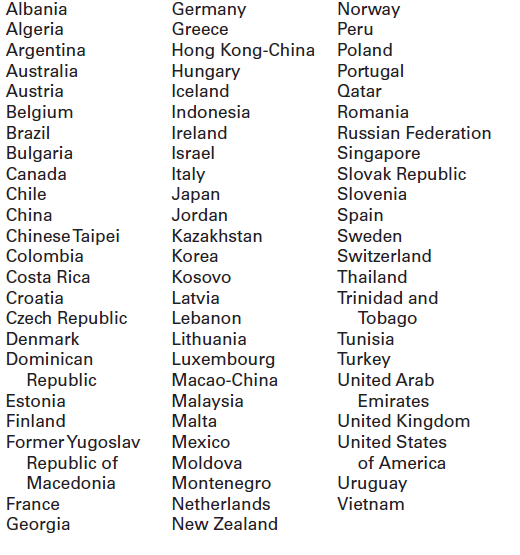
*As of April 2016.
Where do I find more information?
Visit the PISA website at http://nces.ed.gov/surveys/pisa.
For additional questions about PISA 2018, contact the PISA U.S. home office at 1-888-638-2597 or email [email protected].
The National Center for Education Statistics (NCES), within the U.S. Department of Education, conducts the Program for International Student Assessment (PISA) in the United States as authorized by the Education Sciences Reform Act of 2002 (ESRA 2002, 20 U.S.C. §9543). All of the information provided by school staff and students may be used only for statistical purposes and may not be disclosed, or used, in identifiable form for any other purpose except as required by law (20 U.S.C. §9573 and 6 U.S.C. §151). The U.S. Office of Management and Budget has approved this data collection under OMB# 1850-0755.

PISA 2018 FAQ for
school administrators – Public Schools - Front Page
Program for International Student Assessment
FREQUENTLY ASKED QUESTIONS
PISA 2018 (Fall 2018)
Information for Schools
PISA is an international assessment of students nearing the end of compulsory education that measures how well students apply their knowledge and skills to solve problems related to science, reading, and mathematics in real-life contexts. In PISA 2018, students will be assessed in reading, mathematics, science, financial literacy, or some combination of these subjects.
What does participating in PISA entail?
Each school is asked to designate a school coordinator to work with Westat and to submit a list of all students born on or between July 1, 2002 and June 30, 2003 and a list of teachers eligible to teach 10th grade (the modal grade of PISA-eligible students). Up to 52 students in each school will be sampled to participate in the core PISA assessment, which takes about 3 hours of total time, including instructions, breaks, and a questionnaire. Up to 25 teachers in each school will be asked to complete a 30-minute online teacher questionnaire about their background, education, and teaching experiences. The principal of each school will also be asked to complete a 45-minute online questionnaire about school and student body characteristics and policies.
Why should my school and students participate?
The participation of selected schools in the United States is vital to ensuring an accurate representation of the overall population of students nearing the end of compulsory education across the country—including U.S. public and private schools. Although the assessment is voluntary, we rely on school and student participation to ensure the results are complete and accurate. We cannot do that without the support of schools like yours.
PISA is administered worldwide in order to help participating school systems and countries understand their strengths and areas for improvement, with the ultimate goal of increasing both the quality and equity of education worldwide. As such, PISA fosters engagement among international education systems, allowing teachers, education professionals, and policy experts to compare shared experiences in the global learning community. By taking part in PISA, your school will have the unique opportunity to impact the bigger picture of education in the United States and across the world.
What are the benefits to participating?
In addition to receiving a U.S. national report with PISA 2018 results, schools may also receive a school-level report (pending sample size and response rate requirements). The school report presents comparisons of your school’s average scores with the average scores of participating education systems including the United States. The report also provides comparisons of your school with other similar U.S. schools based on specific school-level characteristics. The school report is provided only to your school and any published reports from PISA 2018 will not identify participating schools.
As a token of appreciation for participating, schools will receive $250, the school coordinator will receive $200, students who participate will each receive $25 as well as 4 hours of volunteer service time, and teachers who complete an online questionnaire will each receive $25.
Will all of our students be asked to participate?
Probably not. In each school, all students born between July 1, 2002 and June 30, 2003 and enrolled in grade 7 or higher will have an equal chance of selection. Up to 52 students in each school will be selected to participate. Only in very small schools will the school sample likely include all eligible students. In addition, some students with disabilities or limited English proficiency may be offered a limited set of accommodations to enable their participation; otherwise, they may be excused from the assessment.
PISA 2018 FAQ for school
administrators – Public Schools - Back Page
Who conducts the PISA assessment?
The National Center for Education Statistics (NCES), within the U.S. Department of Education, conducts this study as authorized by the Education Sciences Reform Act of 2002 (ESRA 2002, 20 U.S.C. §9543) and with the approval of the U.S. Office of Management and Budget under OMB# 1850-0755. The assessment process will be undertaken by trained staff from Westat, a research organization under contract to NCES. In compliance with standard protocols, Westat field staff undergoes FBI background checks.
How are teacher and school questionnaires administered?
The teacher and school questionnaires are both administered online from a secure website. The online teacher questionnaire takes approximately 30 minutes to complete and asks about teachers’ education and teaching experience. The school questionnaire, which looks at school characteristics such as enrollment and school practices, is also online and takes about 45 minutes to complete.
Will all of our teachers be asked to participate?
From a listing of teachers in the school eligible to teach grade 10 students, up to 25 teachers (10 English or English/language arts and 15 non-English subject areas) will be asked to participate in the online teacher questionnaire.
Do teachers or other school staff need to help administer the assessment?
No. Westat field staff will visit the school on the day of the assessment, bringing with them all the materials required, and will handle the entire administration of the assessment. Field staff will also bring all of the necessary computer equipment. There is no requirement for school resources such as school computers or access to the internet. All that is required is adequate space to set up the equipment and assess the students.
When will PISA be conducted?
PISA will be conducted between October 1 and November 23, 2018. Westat will work with schools to identify an assessment date convenient for the school in that time period.
How long does PISA take?
Students will take a computer-based assessment. This approximately 3-hour session includes time for instructions, the assessment, breaks, and a questionnaire that students complete about themselves. The assessment location will be used for about 5 hours total, including setup and breakdown by Westat staff. All assessment activities will take place in one day.
What will happen with the collected data?
The data collected for PISA will be used to report on students’ knowledge and skills as group descriptions at the national level. All of the information provided by school staff and students may be used only for statistical purposes and may not be disclosed, or used, in identifiable form for any other purpose except as required by law (20 U.S.C. §9573 and 6 U.S.C. §151). The U.S. Office of Management and Budget has approved this data collection under OMB# 1850-0755. Reports of the findings from PISA will not identify participating districts, schools, students, or individual staff. Individual responses will be combined with those from other participants to produce summary statistics and reports.
Where can I find more information?
Visit the PISA website at http://nces.ed.gov/surveys/pisa. For additional questions about PISA 2018, contact the PISA U.S. home office at 1-888-638-2597 or email [email protected].

PISA 2018 FAQ for Teachers – Public Schools
-
Program for International Student Assessment
FREQUENTLY ASKED QUESTIONS
Information for Teachers
What is PISA?
The Program for International Student Assessment (PISA) is an international assessment of students nearing the end of compulsory education, conducted every three years, that measures how well students apply their knowledge and skills in reading, mathematics, science, and financial literacy. Approximately 70 countries and education systems, including the United States, will participate in PISA 2018. PISA is coordinated by the Organization for Economic Cooperation and Development (OECD) and conducted in the United States by the National Center for Education Statistics (NCES) within the U.S. Department of Education.
Why is PISA important?
The OECD administers PISA in order to help participating school systems and countries understand their strengths and areas for improvement, with the ultimate goal of increasing both the quality and equity of education worldwide. As such, PISA fosters engagement among international education systems, allowing teachers, education professionals, and policy experts to compare shared experiences in the global learning community. Participation in PISA has even led to substantive education policy changes for several countries around the world. Both Germany and Brazil, for example, have raised their standards and made their education systems more inclusive to students from every background as a direct result of their PISA results.
PISA provides a unique opportunity for the United States to understand its educational standing in comparison to other nations. Through participating in PISA, schools, teachers, and students contribute to the improvement of education. PISA can help us identify U.S. students’ strengths and weaknesses in these subjects and help us learn about successful policies and practices in other countries.
What will PISA tell us?
Beyond providing comparative information on the performance of U.S. students in reading mathematics, science, and financial literacy with their peers in other countries. The assessment will provide a range of contextual data that offer insight into students’ school and home environments, socioeconomic advantages and disadvantages, sense of well-being, use of time outside of school, and other factors that might impact their performance.
What role do teachers have in PISA?
Teachers are asked to complete an online questionnaire. This gives teachers an opportunity to provide information that is critical to understanding student performance as well as to voice perspectives on teaching and learning at your school. The teacher questionnaire asks about your background and teaching experience, the student body, and your views on school policies and evaluation.
Why should I participate?
Each school, student, and teacher who participates plays an important role in representing others similar to them. It is vital that teachers in every kind of education system and environment—including public and private schools—are able to contribute to PISA to ensure the U.S. sample is an accurate reflection of educational progress across the country.
How was I selected to take the PISA teacher questionnaire?
The PISA school coordinator in your school (the person designated by your school principal to communicate with PISA staff) provided a list of all teachers eligible to teach tenth-grade students in your school (whether or not they currently do; this is the modal grade of PISA-eligible students). You are one of about 25 teachers from your school who were selected to participate from this list. Your participation in PISA is vital to reaching a high response rate.
How long will it take to complete the PISA teacher questionnaire?
The teacher questionnaire will take approximately 30 minutes to complete online from any location with internet access, and you do not have to complete it all in a single session. The online software automatically saves your responses to each question as you navigate through the questionnaire so that if you wish to complete the questionnaire later, you may pick up right where you left off. Each teacher will be offered $25 for completing the online questionnaire.
How can I access the PISA teacher questionnaire?
To access the teacher questionnaire (https://portal.mypisa.us/TeacherQuestionnaire), you will need to have an internet connection, a suitable internet browser (see list below), and your login credentials. You will be emailed a unique hyperlink that you can click on to access the questionnaire directly. The PISA staff is ready to work with you to make access and completion of the teacher questionnaire as easy and efficient as possible.
The following browsers are supported by PISA and can be downloaded for free if you do not already have them installed on the computer:
• Firefox: Version 19 and above
• Internet Explorer: Version 8 and above
• Google Chrome: Version 25 and above
• Safari (Mac version): versions 6 and above
What is done with the information you collect from me?
Your responses to the PISA teacher questionnaire will be combined with those from other participating teachers across the United States to produce summary statistics and reports. All of the information you provide may be used only for statistical purposes and may not be disclosed, or used, in identifiable form for any other purpose except as required by law (20 U.S.C. §9573 and 6 U.S.C. §151). The U.S. Office of Management and Budget has approved this data collection under OMB# 1850-0755. Reports of the findings will not identify participating districts, students, or individual staff. For a recent example of how PISA data are reported, please visit http://nces.ed.gov/pubs2014/2014024rev.pdf.
Where can I go for help or technical support?
If you have any questions or experience any difficulties, please contact the PISA U.S. home office at 1-888-638-2597 or email [email protected].
For more information on PISA, including results from previous data collections, please visit http://nces.ed.gov/surveys/pisa.

PISA 2018 FAQ for Students – Public Schools
Program for International Student Assessment
FREQUENTLY ASKED QUESTIONS
Information for Students
What is PISA?
The Program for International Student Assessment (PISA) is an international assessment of students nearing the end of compulsory education that measures how well students apply their knowledge and skills in solving problems in reading, mathematics, science, and financial literacy. Conducted every three years, PISA presents problems that students are likely to encounter in the real world. This fall, students like you from more than 70 countries and education systems, including the United States, will participate in PISA.
Why should I participate in PISA?
You are one of up to 52 students in your school who have been selected to participate in PISA. Participation in PISA is voluntary, but each student who participates plays a vital role in ensuring the U.S. results are representative of all types of schools and education environments across the country—including public and private schools. Plus, if you participate in PISA you will…
• Receive a certificate for 4-hours of volunteer service from the U.S. Department of Education.
• Represent students like you across the country.
Make an important contribution to this global measurement of educational progress by representing other students just like you across the United States.
Only 6,000 students will have the unique opportunity to participate in PISA across the United States. How often do you get the chance to represent your country? Participating in PISA is a national service. You can have an impact on the bigger picture of education in the United States and around the world.
What subjects are assessed in PISA?
Each student participating in PISA will be assessed in various combinations of the following subjects: reading, mathematics, science, and financial literacy.
How long does PISA take?
The PISA assessment takes approximately 3 hours to complete. This includes time for instructions, the assessment, breaks, and a survey about you.
How did my school get selected to take PISA?
The schools that participate in PISA in the United States are randomly selected from a list of all schools in the country that enroll age-eligible students. This is done to ensure that U.S. participants accurately represent the entire population of students nearing the end of compulsory education and not just particular types of schools or groups of students.
How did I get selected to take PISA?
The only criteria for being eligible to be selected for PISA are a birth date on or between July 1, 2002 and June 30, 2003, and being enrolled in grade 7 or higher. From a list of all eligible students provided by your school, up to 52 students were randomly selected to participate. Every eligible student enrolled in a PISA selected school has an equal chance of being selected. Students in other countries are selected in the same way to make sure each country is fairly represented and no country is advantaged or disadvantaged because of the types of schools or groups of students selected.
What types of questions will I see on PISA?
PISA questions assess the knowledge and skills students have learned, both in and out of school, based on situations you may encounter in real life. Some PISA questions require that you select from a set of provided answers; other PISA questions require that you write out your response. PISA is administered on computer and many of the items are interactive, where you manipulate different pieces of information. To try PISA items on your own, please visit http://www.oecd.org/pisa/test/.
What is done with the information you collect from me?
PISA is not designed to produce individual test scores and your individual performance is not shared with your teachers, school, or district in any way. Student responses are combined with other student responses and are only used for statistical purposes. The data collected for PISA will be used to report on students’ knowledge and skills as group descriptions at the national level. All of the information you provide may be used only for statistical purposes and may not be disclosed, or used, in identifiable form for any other purpose except as required by law (20 U.S.C. §9573 and 6 U.S.C. §151). The U.S. Office of Management and Budget has approved this data collection under OMB# 1850-0755.
Where can I find more information?
Visit the PISA website at http://nces.ed.gov/surveys/pisa. For additional questions about PISA, contact the PISA U.S. home office at 1-888-638-2597 or email [email protected].

PISA for Public Schools Information Sheet
ISA
for Private Schools brochure
PISA: Measuring Global Educational Progress
The Program for International Student Assessment, or PISA, is an international literacy assessment of 15-year-old students developed by the Organization for Economic Cooperation and Development (OECD) and conducted in the United States by the National Center for Education Statistics, U.S. Department of Education. Since 2000, PISA has assessed students’ performance in reading, mathematics, and science, every three years to measure how well they are prepared to meet the challenges of today’s global economy and workforce.
PISA offers a window into the classrooms of countries around the world, allowing all of us to better understand how students perform in subjects like reading, science, and mathematics, as well as other factors that impact student achievement, like school and home environments, socioeconomic advantages and disadvantages, access to technology, and how students use their time outside of school. The results can drive real policy changes—as they have in countries like Germany, Brazil, and Poland—and foster collaboration across borders between educators, administrators, and policy experts.
Why PISA Needs Schools Like Yours
Participating in PISA presents a unique opportunity for individual schools, students, and teachers to contribute to a global conversation about how well students in different education systems can apply what they’ve learned in school to real-world contexts. It’s a chance to take part in a vital measurement of the United States’ educational progress and our position among economic peers, competitors, and other high performing countries.
Most importantly, schools like yours are a critical component of the American education system. For PISA to accurately reflect the proficiency of all U.S. students in reading, mathematics, and science literacy, it must include a representative sample of both public and private school students.
What You Get Back
There are concrete benefits for schools, students, and teachers that volunteer to take part, including access to critical school-wide data, incentives, and service time.
Following the release of the assessment results in 2019, participating schools may receive a detailed school-level report, explaining how students’ performance compares to students in other schools like yours, the U.S. at large, and international education systems (pending sample and response rate requirements).
The goal of schooling is to provide students with an education that helps to teach them critical life skills and prepares them for postsecondary education and beyond. But are they able to take what they learn and apply it outside of the classroom? Will they be competitive in the global workforce? How do they stack up against 15-year-olds in Singapore, Finland, or the U.K.? The PISA school-level report helps administrators answer questions like these.
Sections of the school-level report include:
An explanation of what students at your school know and can do in reading, mathematics, and science.
Contextual data that sheds light on students’ reading habits, attitudes to mathematics, and self-belief and interest in science, and if/how these data relate to students’ performance.
Insights into student perceptions of other environmental factors, such as their school’s disciplinary climate and teacher-student relations.
The school report would be provided only to your school and any published reports from PISA 2018 will not identify participating schools.
Additionally, participation in PISA provides professional development opportunities for educators and administrators through the online community at PISA4U.org, including:
Opportunities for collaboration with top-performing classrooms from around the world.
The chance to learn from international education experts.
Resources that can help improve teaching and solve real problems educators face in their daily work.
Where We Are Now: PISA 2015 at a Glance
The last round of PISA was conducted in 2015, with more than half a million students participating from 72 education systems, including the United States. PISA’s unique design allows participating education systems to track their performance over time, as well as compare their relative performance to other international education systems. The OECD developed PISA with one underlying directive: to promote policy recommendations designed to increase both the quality and equity of education systems.
In 2015, PISA results indicated the following:
The United States’ reading and science literacy scores were not measurably different from the international OECD average.
Nine percent of U.S. students scored at the top proficiency level in science, while 10 percent of students scored at the top proficiency level in reading. These percentages were not measurably different than the OECD average of 8 percent for both science and reading.
U.S. mathematics scores were below the OECD average.
Six percent of U.S. students scored at the top proficiency level in mathematics, which was lower than the OECD average of 11 percent. Twenty-nine percent of U.S. students scored at the lowest proficiency levels in mathematics, which is higher than the OECD average of 23 percent.
The U.S. placed among the top half of participating countries in reading and science, and 38 out of 69 participating education systems in mathematics.
There were measurable gender gaps in all three subjects. U.S. male students scored higher on average in math and science than female students, while U.S. female students scored higher on average in reading.
For more information about PISA in the United States, international data and trends, and collaborative resources, visit:
PISA U.S. Website: https://nces.ed.gov/surveys/pisa/
OECD PISA Website: http://www.oecd.org/pisa/
OECD Education Twitter: https://twitter.com/OECDEduSkills
A Catalyst for
Reform and a Benchmark for Progress: The
Role of PISA in Education Policy When
results from the 2000 assessment were released, Germany found that
more than 1-in-5 of its students were not proficient in reading,
and that performance disparities among its poorest and wealthiest
students were some of the highest in the OECD. As a result, the
country raised its education standards and increased school hours.
During the past 15 years, Germany has seen its reading scores
increase relative to other OECD countries. In
Brazil, more than half of students scored at the lowest proficiency
levels in the 2003 mathematics assessment. The country prioritized
reaching average OECD score levels by 2021, and measures its
progress based on PISA benchmarks. By 2015, the countries lowest
performers had increased their math scores by 34 points. Prior
to 2000, Poland had one of the lowest levels of college attainment
among OECD countries, and its eight-year secondary education
program wasn’t adequately preparing students for the real
world. The country worked to overhaul its education system, adding
an additional year of secondary schooling, and raising education
standards, quality, and equity. Poland’s average reading
score increased 21 points between 2000 and 2009. By 2015, the
country had raised its performance to levels similar to the United
States and Norway.

PISA Learning Community Facebook Page: https://www.facebook.com/OECDPISA
PISA
2018 Timeline of Activities – Public and Private Schools
|
March-August 2018 |
August-October 2018 Pre-assessment Contact |
September-November, 2018 Assessment Visit |
Benefits |
|
Principal and Teachers |
|
|
|
|
|
School Coordinator |
|
|
|
|
|
Students |
|
|
|
|
|
PISA Staff |
|
|
|
|
|
Find Out More |
|||||

Teacher Invite Email – Public Schools
Dear [Teacher Name]:
Your school is one of about 250 schools across the United States that are taking part in the Program for International Student Assessment (PISA) 2018. You’ve been selected to participate by completing an online teacher questionnaire about the courses you teach, your teacher training and education, and your views on teaching.
PISA is administered worldwide in order to help participating school systems and countries understand their strengths and areas for improvement, with the ultimate goal of increasing both the quality and equity of education worldwide. As such, PISA fosters engagement among international education systems, allowing teachers, education professionals, and policy experts to compare shared experiences in the global learning community. Participating in PISA presents a unique opportunity to contribute to this vital measurement of U.S. educational progress and collaboration with our economic peers and competitors. If you have any questions about how you were selected for this survey, please contact your PISA school coordinator, «SC_FNAME» «SC_LNAME».
The questionnaire takes about 30 minutes to complete. This information, combined with responses from school principals and students, helps to provide a more complete understanding of student achievement and contexts for learning. Your responses are not linked to student achievement and will not be shared with the school or district.
 You
will receive $25 for completing the questionnaire, if allowed by your
school’s or district’s policy.
Use the provided link and unique account information below to
complete your questionnaire.
You
will receive $25 for completing the questionnaire, if allowed by your
school’s or district’s policy.
Use the provided link and unique account information below to
complete your questionnaire.
Link:
https://portal.mypisa.us/TeacherQuestionnaire
Username:
«KQID»
Password:
«TEACHPWD»
PISA is conducted in the United States by the National Center for Education Statistics (NCES) in the U.S. Department of Education and is administered by Westat, a firm in Rockville, Maryland. The U.S. Office of Management and Budget has approved the data collection under OMB# 1850-0755.
If you have any questions, please do not hesitate to call 1-888-638-2597 or send an email to [email protected]. You may also get more information about this study by visiting the PISA website at http://nces.ed.gov/surveys/pisa.
Thank you for your time and for supporting this important international study.
Sincerely,
The PISA USA Team
The National Center for Education Statistics (NCES), within the U.S. Department of Education, conducts the Program for International Student Assessment (PISA) in the United States as authorized by the Education Sciences Reform Act of 2002 (ESRA 2002, 20 U.S.C. §9543). All of the information provided by school staff and students may be used only for statistical purposes and may not be disclosed, or used, in identifiable form for any other purpose except as required by law (20 U.S.C. §9573 and 6 U.S.C. §151). The U.S. Office of Management and Budget has approved this data collection under OMB# 1850-0755.

School PISA Letter – Private Schools
[Date]
[Title] [Name First] [Name Last], [Title/Department]
[School District]
[Address 1]
[City], [State] [Zip code]
Dear [Title] [Name Last]:
The United States is participating in the 2018 Program for International Student Assessment (PISA). As the largest international education study in the world, PISA measures the reading, mathematics, and science literacy of students nearing the end of compulsory education. The United States and more than 70 other countries and education systems will participate in the next round. PISA results are used by researchers and policymakers to chart national progress against international standards and the educational progress of our global economic peers and competitors. Your school is one of about 250 across the United States that has been randomly selected to take part in the PISA in fall 2018.
Beyond providing comparative information on the performance of students, PISA fosters international engagement across education systems, allowing teachers, education professionals, and policy experts to compare shared experiences in the global learning community. In addition to reading, mathematics, and science literacy, PISA 2018 includes an assessment of students’ financial literacy, and will provide a range of contextual data that offer insight into students’ school and home environments, socioeconomic advantages and disadvantages, sense of well-being, and use of time outside of school.
Schools participating in PISA will receive $250, and each school’s PISA school coordinator (a school staff person designated to liaise with PISA staff) will receive $200 as a thank you for their time and effort. Selected teachers will receive $25 for completing a questionnaire. Each student who participates will be eligible to receive $25 and a volunteer service certificate of 4 hours from the U.S. Department of Education. NCES will also sponsor a delegate from your school to attend a PISA training workshop in Washington, D.C. during the summer of 2018. In addition, when the national results of the 2018 assessment are released, your school may also receive a school-level report highlighting the performance of students in your school compared to their peers in other private schools, U.S. schools, and high-performing OECD countries (pending sample size and response rate requirements).
The PISA assessment experience and the benefits of participating are described in more detail in the enclosed materials, which I invite you to review. PISA is conducted in the United States by the National Center for Education Statistics (NCES) in the U.S. Department of Education and is administered by Westat, a firm in Rockville, Maryland. The U.S. Office of Management and Budget (OMB) has approved the data collection under OMB# 1850-0755. For information on the confidentiality of the data collected, please see the enclosed FAQ. While participation in this study is voluntary, each school plays an important role in ensuring that the U.S. sample is representative of the knowledge and skills of all students in our country’s education system.
The PISA assessment window is from October 1 through November 23, 2018. Within the next few days, a representative of Westat will contact you to discuss your school’s participation. If you have any questions, please do not hesitate to call 1-888-638-2597 or send an email to [email protected]. You may also get more information about this study by contacting Patrick Gonzales at NCES at 415-920-9229 or [email protected], or by visiting the PISA website at http://nces.ed.gov/surveys/pisa.
Your school’s participation in PISA 2018 is vital to the overall success of the study in the United States. Thank you for your time and for supporting this important international education study.
Sincerely,
Peggy Carr, Ph.D.
Acting Commissioner
Enclosures
The National Center for Education Statistics (NCES), within the U.S. Department of Education, conducts the Program for International Student Assessment (PISA) in the United States as authorized by the Education Sciences Reform Act of 2002 (ESRA 2002, 20 U.S.C. §9543). All of the information provided by school staff and students may be used only for statistical purposes and may not be disclosed, or used, in identifiable form for any other purpose except as required by law (20 U.S.C. §9573 and 6 U.S.C. §151). The U.S. Office of Management and Budget has approved this data collection under OMB# 1850-0755.
PISA
2018 Brochure – Private Schools - Front Cover
What is PISA?
The Program for International Student Assessment (PISA) is an international assessment of students nearing the end of compulsory education that measures how well students apply their knowledge and skills in reading, mathematics, and science to problems set in real-life contexts. Conducted every 3 years since 2000, the next round of PISA in 2018 will include students from more than 70 countries and education systems around the world, including the United States. PISA is coordinated by the Organization for Economic Cooperation and Development (OECD) and conducted in the United States by the National Center for Education Statistics (NCES) within the U.S. Department of Education.
Why is PISA important?
PISA provides a unique opportunity for the United States to understand how well students nearing the end of compulsory education are prepared to enter the workforce or post-secondary education in comparison to their peers from more than 70 countries. Through participating in PISA, schools, teachers, and students contribute to ongoing efforts to improve education in our country. PISA helps identify U.S. students’ strengths and weaknesses in the domains of reading, mathematics, and science and offers insights into successful policies and practices in other countries.
Why should private schools participate and what are the benefits?
Each school and student that participates in PISA plays a vital role in representing other schools and students that are similar. It is essential that private schools contribute to this important measurement of educational progress to ensure the U.S. sample reflects the knowledge and skills of all students across the country.
In addition to receiving a U.S. national report with PISA 2018 results, schools may also receive a school-level report (pending sample size and response rate requirements). The school report, provided only to your school, presents comparisons of your school’s average scores with the average scores of participating education systems, including the United States, and can serve as a benchmark for your students’ performance among other similar U.S. schools based on specific school-level characteristics.
As a token of appreciation for participating, schools will receive $250, the school coordinator will receive $200, students who participate will each receive $25 as well as 4 hours of volunteer service time, and teachers who complete an online questionnaire will each receive $25. NCES also sponsors one delegate from each school to attend a summer training workshop in Washington, D.C. to learn about PISA.
What will schools, students, and teachers be asked to do in PISA 2018?
PISA 2018 has four primary components: (1) a computer-based student assessment, (2) a computer-based student questionnaire (3) an online school questionnaire, and (4) an online teacher questionnaire.
Up to 52 students in each school will be selected to participate in the PISA assessment, which takes about 3 hours, including instructions, breaks, and a questionnaire. Students will answer questions in various combinations of reading, mathematics, science, and financial literacy.
The principal of each school will be asked to appoint a staff member to act as the PISA school coordinator. The school coordinator will work with Westat staff to coordinate the assessment and submit student and teacher lists for sampling. The principal of each school will also be asked to complete a 45-minute online questionnaire about school and student body characteristics and policies.
Up to 25 teachers in each school will be asked to complete a 30-minute online teacher questionnaire about their background, education, and teaching experiences. Participation is voluntary but important for ensuring that the sample is representative of schools and students across the country.
PISA 2018 Brochure –
Private Schools (Continued Inside Cover)
How is PISA developed?
PISA is developed through an international collaborative process involving input from U.S. and international experts in science, reading, mathematics, financial literacy, and educational measurement. The PISA assessment materials are thoroughly reviewed by within-country experts to make sure the materials are appropriate for each country’s students. Finally, the final assessment materials are endorsed by all participating countries.
What do PISA questions look like?
PISA includes a mix of item types: some items require students to select from among possible responses, while others require students solve problems and provide written answers. Examples of PISA assessment questions are available at http://nces.ed.gov/surveys/pisa/educators.asp and https://www.oecd.org/pisa/pisaproducts/pisa-test-questions.htm.
Which countries are participating in PISA 2018?*

*As of April 2016.
Where do I find more information?
Visit the PISA website at http://nces.ed.gov/surveys/pisa.
For additional questions about PISA 2018, contact the PISA U.S. home office at 1-888-638-2597 or email [email protected].
The National Center for Education Statistics (NCES), within the U.S. Department of Education, conducts the Program for International Student Assessment (PISA) in the United States as authorized by the Education Sciences Reform Act of 2002 (ESRA 2002, 20 U.S.C. §9543). All of the information provided by school staff and students may be used only for statistical purposes and may not be disclosed, or used, in identifiable form for any other purpose except as required by law (20 U.S.C. §9573 and 6 U.S.C. §151). The U.S. Office of Management and Budget has approved this data collection under OMB# 1850-0755.

PISA 2018 FAQ for
school administrators – Private Schools – Front Page
Program for International Student Assessment
FREQUENTLY ASKED QUESTIONS
PISA 2018 (Fall 2018)
Information for Schools
PISA is an international assessment of students nearing the end of compulsory education that measures how well students apply their knowledge and skills to solve problems related to science, reading, and mathematics in real-life contexts. In PISA 2018, students will be assessed in reading, mathematics, science, financial literacy, or some combination of these subjects.
What does participating in PISA entail?
Each school is asked to designate a school coordinator to work with Westat and to submit a list of all students born on or between July 1, 2002 and June 30, 2003 and a list of teachers eligible to teach 10th grade (the modal grade of PISA-eligible students). Up to 52 students in each school will be sampled to participate in the core PISA assessment, which takes about 3 hours of total time, including instructions, breaks, and a questionnaire. Up to 25 teachers in each school will be asked to complete a 30-minute online teacher questionnaire about their background, education, and teaching experiences. The principal of each school will also be asked to complete a 45-minute online questionnaire about school and student body characteristics and policies.
Why should my school and students participate?
The participation of selected schools in the United States is vital to ensuring an accurate representation of the overall population of students nearing the end of compulsory education across the country—including U.S. public and private schools. Although the assessment is voluntary, we rely on school and student participation to ensure the results are complete and accurate. We cannot do that without the support of schools like yours.
PISA is administered worldwide in order to help participating school systems and countries understand their strengths and areas for improvement, with the ultimate goal of increasing both the quality and equity of education worldwide. As such, PISA fosters engagement among international education systems, allowing teachers, education professionals, and policy experts to compare shared experiences in the global learning community. By taking part in PISA, your school will have the unique opportunity to impact the bigger picture of education in the United States and across the world.
What are the benefits to participating?
In addition to receiving a U.S. national report with PISA 2018 results, schools may also receive a school-level report (pending sample size and response rate requirements). The school report presents comparisons of your school’s average scores with the average scores of participating education systems including the United States. The report also provides comparisons of your school with other similar U.S. schools based on specific school-level characteristics. The school report is provided only to your school and any published reports from PISA 2018 will not identify participating schools.
As a token of appreciation for participating, schools will receive $250, the school coordinator will receive $200, students who participate will each receive $25 as well as 4 hours of volunteer service time, and teachers who complete an online questionnaire will each receive $25.
Will all of our students be asked to participate?
Probably not. In each school, all students born between July 1, 2002 and June 30, 2003 and enrolled in grade 7 or higher will have an equal chance of selection. Up to 52 students in each school will be selected to participate. Only in very small schools will the school sample likely include all eligible students. In addition, some students with disabilities or limited English proficiency may be offered a limited set of accommodations to enable their participation; otherwise, they may be excused from the assessment.
PISA 2018 FAQ for school
administrators- Private Schools - Back Page
Who conducts the PISA assessment?
The National Center for Education Statistics (NCES), within the U.S. Department of Education, conducts this study as authorized by the Education Sciences Reform Act of 2002 (ESRA 2002, 20 U.S.C. §9543) and with the approval of the U.S. Office of Management and Budget under OMB# 1850-0755. The assessment process will be undertaken by trained staff from Westat, a research organization under contract to NCES. In compliance with standard protocols, Westat field staff undergoes FBI background checks.
How are teacher and school questionnaires administered?
The teacher and school questionnaires are both administered online from a secure website. The online teacher questionnaire takes approximately 30 minutes to complete and asks about teachers’ education and teaching experience. The school questionnaire, which looks at school characteristics such as enrollment and school practices, is also online and takes about 45 minutes to complete.
Will all of our teachers be asked to participate?
From a listing of teachers in the school eligible to teach grade 10 students, up to 25 teachers (10 English or English/language arts and 15 non-English subject areas) will be asked to participate in the online teacher questionnaire.
Do teachers or other school staff need to help administer the assessment?
No. Westat field staff will visit the school on the day of the assessment, bringing with them all the materials required, and will handle the entire administration of the assessment. Field staff will also bring all of the necessary computer equipment. There is no requirement for school resources such as school computers or access to the internet. All that is required is adequate space to set up the equipment and assess the students.
When will PISA be conducted?
PISA will be conducted between October 1 and November 23, 2018. Westat will work with schools to identify an assessment date convenient for the school in that time period.
How long does PISA take?
Students will take a computer-based assessment. This approximately 3-hour session includes time for instructions, the assessment, breaks, and a questionnaire that students complete about themselves. The assessment location will be used for about 5 hours total, including setup and breakdown by Westat staff. All assessment activities will take place in one day.
What will happen with the collected data?
The data collected for PISA will be used to report on students’ knowledge and skills as group descriptions at the national level. All of the information provided by school staff and students may be used only for statistical purposes and may not be disclosed, or used, in identifiable form for any other purpose except as required by law (20 U.S.C. §9573 and 6 U.S.C. §151). The U.S. Office of Management and Budget has approved this data collection under OMB# 1850-0755. Reports of the findings from PISA will not identify participating districts, schools, students, or individual staff. Individual responses will be combined with those from other participants to produce summary statistics and reports.
Where can I find more information?
Visit the PISA website at http://nces.ed.gov/surveys/pisa. For additional questions about PISA 2018, contact the PISA U.S. home office at 1-888-638-2597 or email [email protected].

PISA 2018 FAQ for Teachers –Private Schools
Program for International Student Assessment
FREQUENTLY ASKED QUESTIONS
Information for Teachers
What is PISA?
The Program for International Student Assessment (PISA) is an international assessment of students nearing the end of compulsory education, conducted every three years, that measures how well students apply their knowledge and skills in reading, mathematics, science, and financial literacy. Approximately 70 countries and education systems, including the United States, will participate in PISA 2018. PISA is coordinated by the Organization for Economic Cooperation and Development (OECD) and conducted in the United States by the National Center for Education Statistics (NCES) within the U.S. Department of Education.
Why is PISA important?
The OECD administers PISA in order to help participating school systems and countries understand their strengths and areas for improvement, with the ultimate goal of increasing both the quality and equity of education worldwide. As such, PISA fosters engagement among international education systems, allowing teachers, education professionals, and policy experts to compare shared experiences in the global learning community. Participation in PISA has even led to substantive education policy changes for several countries around the world. Both Germany and Brazil, for example, have raised their standards and made their education systems more inclusive to students from every background as a direct result of their PISA results.
PISA provides a unique opportunity for the United States to understand its educational standing in comparison to other nations. Through participating in PISA, schools, teachers, and students contribute to the improvement of education. PISA can help us identify U.S. students’ strengths and weaknesses in these subjects and help us learn about successful policies and practices in other countries.
What will PISA tell us?
Beyond providing comparative information on the performance of U.S. students in reading mathematics, science, and financial literacy with their peers in other countries. The assessment will provide a range of contextual data that offer insight into students’ school and home environments, socioeconomic advantages and disadvantages, sense of well-being, use of time outside of school, and other factors that might impact their performance.
What role do teachers have in PISA?
Teachers are asked to complete an online questionnaire. This gives teachers an opportunity to provide information that is critical to understanding student performance as well as to voice perspectives on teaching and learning at your school. The teacher questionnaire asks about your background and teaching experience, the student body, and your views on school policies and evaluation.
Why should I participate?
Each school, student, and teacher who participates plays an important role in representing others similar to them. It is vital that teachers in every kind of education system and environment—including public and private schools—are able to contribute to PISA to ensure the U.S. sample is an accurate reflection of educational progress across the country.
How was I selected to take the PISA teacher questionnaire?
The PISA school coordinator in your school (the person designated by your school principal to communicate with PISA staff) provided a list of all teachers eligible to teach tenth-grade students in your school (whether or not they currently do; this is the modal grade of PISA-eligible students). You are one of about 25 teachers from your school who were selected to participate from this list. Your participation in PISA is vital to reaching a high response rate.
How long will it take to complete the PISA teacher questionnaire?
The teacher questionnaire will take approximately 30 minutes to complete online from any location with internet access, and you do not have to complete it all in a single session. The online software automatically saves your responses to each question as you navigate through the questionnaire so that if you wish to complete the questionnaire later, you may pick up right where you left off. Each teacher will be offered $25 for completing the online questionnaire.
How can I access the PISA teacher questionnaire?
To access the teacher questionnaire (https://portal.mypisa.us/TeacherQuestionnaire), you will need to have an internet connection, a suitable internet browser (see list below), and your login credentials. You will be emailed a unique hyperlink that you can click on to access the questionnaire directly. The PISA staff is ready to work with you to make access and completion of the teacher questionnaire as easy and efficient as possible.
The following browsers are supported by PISA and can be downloaded for free if you do not already have them installed on the computer:
• Firefox: Version 19 and above
• Internet Explorer: Version 8 and above
• Google Chrome: Version 25 and above
• Safari (Mac version): versions 6 and above
What is done with the information you collect from me?
Your responses to the PISA teacher questionnaire will be combined with those from other participating teachers across the United States to produce summary statistics and reports. All of the information you provide may be used only for statistical purposes and may not be disclosed, or used, in identifiable form for any other purpose except as required by law (20 U.S.C. §9573 and 6 U.S.C. §151). The U.S. Office of Management and Budget has approved this data collection under OMB# 1850-0755. Reports of the findings will not identify participating districts, students, or individual staff. For a recent example of how PISA data are reported, please visit http://nces.ed.gov/pubs2014/2014024rev.pdf.
Where can I go for help or technical support?
If you have any questions or experience any difficulties, please contact the PISA U.S. home office at 1-888-638-2597 or email [email protected].
For more information on PISA, including results from previous data collections, please visit http://nces.ed.gov/surveys/pisa.

PISA 2018 FAQ for Students – Private Schools
Program for International Student Assessment
FREQUENTLY ASKED QUESTIONS
Information for Students
What is PISA?
The Program for International Student Assessment (PISA) is an international assessment of students nearing the end of compulsory education that measures how well students apply their knowledge and skills in solving problems in reading, mathematics, science, and financial literacy. Conducted every three years, PISA presents problems that students are likely to encounter in the real world. This fall, students like you from more than 70 countries and education systems, including the United States, will participate in PISA.
Why should I participate in PISA?
You are one of up to 52 students in your school who have been selected to participate in PISA. Participation in PISA is voluntary, but each student who participates plays a vital role in ensuring the U.S. results are representative of all types of schools and education environments across the country—including public and private schools. Plus, if you participate in PISA you will…
• Receive a certificate for 4-hours of volunteer service from the U.S. Department of Education.
• Represent students like you across the country.
Make an important contribution to this global measurement of educational progress by representing other students just like you across the United States.
Only 6,000 students will have the unique opportunity to participate in PISA across the United States. How often do you get the chance to represent your country? Participating in PISA is a national service. You can have an impact on the bigger picture of education in the United States and around the world.
What subjects are assessed in PISA?
Each student participating in PISA will be assessed in various combinations of the following subjects: reading, mathematics, science, and financial literacy.
How long does PISA take?
The PISA assessment takes approximately 3 hours to complete. This includes time for instructions, the assessment, breaks, and a survey about you.
How did my school get selected to take PISA?
The schools that participate in PISA in the United States are randomly selected from a list of all schools in the country that enroll age-eligible students. This is done to ensure that U.S. participants accurately represent the entire population of students nearing the end of compulsory education and not just particular types of schools or groups of students.
How did I get selected to take PISA?
The only criteria for being eligible to be selected for PISA are a birth date on or between July 1, 2002 and June 30, 2003, and being enrolled in grade 7 or higher. From a list of all eligible students provided by your school, up to 52 students were randomly selected to participate. Every eligible student enrolled in a PISA selected school has an equal chance of being selected. Students in other countries are selected in the same way to make sure each country is fairly represented and no country is advantaged or disadvantaged because of the types of schools or groups of students selected.
What types of questions will I see on PISA?
PISA questions assess the knowledge and skills students have learned, both in and out of school, based on situations you may encounter in real life. Some PISA questions require that you select from a set of provided answers; other PISA questions require that you write out your response. PISA is administered on computer and many of the items are interactive, where you manipulate different pieces of information. To try PISA items on your own, please visit http://www.oecd.org/pisa/test/.
What is done with the information you collect from me?
PISA is not designed to produce individual test scores and your individual performance is not shared with your teachers, school, or district in any way. Student responses are combined with other student responses and are only used for statistical purposes. The data collected for PISA will be used to report on students’ knowledge and skills as group descriptions at the national level. All of the information you provide may be used only for statistical purposes and may not be disclosed, or used, in identifiable form for any other purpose except as required by law (20 U.S.C. §9573 and 6 U.S.C. §151). The U.S. Office of Management and Budget has approved this data collection under OMB# 1850-0755.
Where can I find more information?
Visit the PISA website at http://nces.ed.gov/surveys/pisa. For additional questions about PISA, contact the PISA U.S. home office at 1-888-638-2597 or email [email protected].

PISA for Private Schools Information Sheet
ISA
for Private Schools brochure
PISA: Measuring Global Educational Progress
The Program for International Student Assessment, or PISA, is an international literacy assessment of 15-year-old students developed by the Organization for Economic Cooperation and Development (OECD) and conducted in the United States by the National Center for Education Statistics, U.S. Department of Education. Since 2000, PISA has assessed students’ performance in reading, mathematics, and science, every three years to measure how well they are prepared to meet the challenges of today’s global economy and workforce.
PISA offers a window into the classrooms of countries around the world, allowing all of us to better understand how students perform in subjects like reading, science, and mathematics, as well as other factors that impact student achievement, like school and home environments, socioeconomic advantages and disadvantages, access to technology, and how students use their time outside of school. The results can drive real policy changes—as they have in countries like Germany, Brazil, and Poland—and foster collaboration across borders between educators, administrators, and policy experts.
Why PISA Needs Private Schools
Participating in PISA presents a unique opportunity for individual schools, students, and teachers to contribute to a global conversation about how well students in different education systems can apply what they’ve learned in school to real-world contexts. It’s a chance to take part in a vital measurement of the United States’ educational progress and our position among economic peers, competitors, and other high performing countries.
Most importantly, private schools are a critical component of the American education system. For PISA to accurately reflect the proficiency of all U.S. students in reading, mathematics, and science literacy, it must include a representative sample of both public and private school students.
What You Get Back
There are concrete benefits for schools, students, and teachers that volunteer to take part, including access to critical school-wide data, incentives, and service time.
Following the release of the assessment results in 2019, participating private schools may receive a detailed school-level report, explaining how students’ performance compares to students in other private schools, the U.S. at large, and international education systems (pending sample and response rate requirements).
Private schools across the U.S. provide students with an education that helps to teach them critical life skills and prepares them for postsecondary education and beyond. But are they able to take what they learn and apply it outside of the classroom? Will they be competitive in the global workforce? How do they stack up against 15-year-olds in Singapore, Finland, or the U.K.? The PISA school-level report helps administrators answer questions like these.
Sections of the school-level report include:
An explanation of what students at your school know and can do in reading, mathematics, and science.
Contextual data that sheds light on students’ reading habits, attitudes to mathematics, and self-belief and interest in science, and if/how these data relate to students’ performance.
Insights into student perceptions of other environmental factors, such as their school’s disciplinary climate and teacher-student relations.
The school report would be provided only to your school and any published reports from PISA 2018 will not identify participating schools.
Additionally, participation in PISA provides professional development opportunities for educators and administrators through the online community at PISA4U.org, including:
Opportunities for collaboration with top-performing classrooms from around the world.
The chance to learn from international education experts.
Resources that can help improve teaching and solve real problems educators face in their daily work.
Where We Are Now: PISA 2015 at a Glance
The last round of PISA was conducted in 2015, with more than half a million students participating from 72 education systems, including the United States. PISA’s unique design allows participating education systems to track their performance over time, as well as compare their relative performance to other international education systems. The OECD developed PISA with one underlying directive: to promote policy recommendations designed to increase both the quality and equity of education systems.
In 2015, PISA results indicated the following:
The United States’ reading and science literacy scores were not measurably different from the international OECD average.
Nine percent of U.S. students scored at the top proficiency level in science, while 10 percent of students scored at the top proficiency level in reading. These percentages were not measurably different than the OECD average of 8 percent for both science and reading.
U.S. mathematics scores were below the OECD average.
Six percent of U.S. students scored at the top proficiency level in mathematics, which was lower than the OECD average of 11 percent. Twenty-nine percent of U.S. students scored at the lowest proficiency levels in mathematics, which is higher than the OECD average of 23 percent.
The U.S. placed among the top half of participating countries in reading and science, and 38 out of 69 participating education systems in mathematics.
There were measurable gender gaps in all three subjects. U.S. male students scored higher on average in math and science than female students, while U.S. female students scored higher on average in reading.
For more information about PISA in the United States, international data and trends, and collaborative resources, visit:
PISA U.S. Website: https://nces.ed.gov/surveys/pisa/
OECD PISA Website: http://www.oecd.org/pisa/
OECD Education Twitter: https://twitter.com/OECDEduSkills
A Catalyst for
Reform and a Benchmark for Progress: The
Role of PISA in Education Policy When
results from the 2000 assessment were released, Germany found that
more than 1-in-5 of its students were not proficient in reading,
and that performance disparities among its poorest and wealthiest
students were some of the highest in the OECD. As a result, the
country raised its education standards and increased school hours.
During the past 15 years, Germany has seen its reading scores
increase relative to other OECD countries. In
Brazil, more than half of students scored at the lowest proficiency
levels in the 2003 mathematics assessment. The country prioritized
reaching average OECD score levels by 2021, and measures its
progress based on PISA benchmarks. By 2015, the countries lowest
performers had increased their math scores by 34 points. Prior
to 2000, Poland had one of the lowest levels of college attainment
among OECD countries, and its eight-year secondary education
program wasn’t adequately preparing students for the real
world. The country worked to overhaul its education system, adding
an additional year of secondary schooling, and raising education
standards, quality, and equity. Poland’s average reading
score increased 21 points between 2000 and 2009. By 2015, the
country had raised its performance to levels similar to the United
States and Norway.

PISA Learning Community Facebook Page: https://www.facebook.com/OECDPISA

Teacher Invite Email – Private Schools
Dear [Teacher Name]:
Your school is one of about 250 schools across the United States that are taking part in the Program for International Student Assessment (PISA) 2018. You’ve been selected to participate by completing an online teacher questionnaire about the courses you teach, your teacher training and education, and your views on teaching.
PISA is administered worldwide in order to help participating school systems and countries understand their strengths and areas for improvement, with the ultimate goal of increasing both the quality and equity of education worldwide. As such, PISA fosters engagement among international education systems, allowing teachers, education professionals, and policy experts to compare shared experiences in the global learning community. Participating in PISA presents a unique opportunity to contribute to this vital measurement of U.S. educational progress and collaboration with our economic peers and competitors. If you have any questions about how you were selected for this survey, please contact your PISA school coordinator, «SC_FNAME» «SC_LNAME».
The questionnaire takes about 30 minutes to complete. This information, combined with responses from school principals and students, helps to provide a more complete understanding of student achievement and contexts for learning. Your responses are not linked to student achievement and will not be shared with the school or district.
You will receive $25 for completing the questionnaire, if allowed by your school’s policy. Use the provided link and unique account information below to complete your questionnaire.
 Link:
https://portal.mypisa.us
/TeacherQuestionnaire
Link:
https://portal.mypisa.us
/TeacherQuestionnaire
Username:
«KQID»
Password:
«TEACHPWD»
PISA is conducted in the United States by the National Center for Education Statistics (NCES) in the U.S. Department of Education and is administered by Westat, a firm in Rockville, Maryland. The U.S. Office of Management and Budget has approved the data collection under OMB# 1850-0755.
If you have any questions, please do not hesitate to call 1-888-638-2597 or send an email to [email protected]. You may also get more information about this study by visiting the PISA website at http://nces.ed.gov/surveys/pisa.
Thank you for your time and for supporting this important international study.
Sincerely,
The PISA USA Team
The National Center for Education Statistics (NCES), within the U.S. Department of Education, conducts the Program for International Student Assessment (PISA) in the United States as authorized by the Education Sciences Reform Act of 2002 (ESRA 2002, 20 U.S.C. §9543). All of the information provided by school staff and students may be used only for statistical purposes and may not be disclosed, or used, in identifiable form for any other purpose except as required by law (20 U.S.C. §9573 and 6 U.S.C. §151). The U.S. Office of Management and Budget has approved this data collection under OMB# 1850-0755.

School Coordinator Email announcing E-Filing for Main Study
Subject: PISA E-Filing open
Attachment: PISA 2018 E-Filing Instructions
Dear,
Thank you for your time and effort working on PISA 2018!
We are pleased to announce that WWW.MYPISA.US is now ready to receive student and teacher electronic listing files (e-files).
The instructions for preparing and submitting your school’s student and teacher listing files are attached to this email. The PISA E-filing Instructions can also be accessed online from the website. Along with the instructions, we’ve prepared a formatted Excel template to make preparing the e-file more convenient.
If you have yet to register on WWW.MYPISA.US, please let us know so we can send you the registration ID for your school.
Reach out to the PISA help desk by phone between 8 a.m. and 8 p.m. Eastern Time at 1-855-545-1163 or email [email protected].
Thanks again for your support.
All the best,
The U.S. PISA Team

Instructions for School Coordinators to E-file student and teacher
lists
1. PREPARE ELECTRONIC STUDENT FILE (E-FILE)........................................................ 1
Steps for preparing an Electronic Student File (E-File)........................................................................ 1
Step 1: Identify ALL students at your school who meet the eligibility criteria...................................... 1
Step 2: List each of the eligible students................................................................................................ 1
Submitting your Electronic Student File............................................................................................ 2
Student E-File Step 1: Upload your file..................................................................................................... 3
Student E-File Step 2: Identify your column contents.............................................................................. 4
Student E-File Step 3: Match your values to PISA codes.......................................................................... 5
Student E-File Step 4: Verify your E-File............................................................................................... 6
E-File Complete!.................................................................................................................................... 7
2. PREPARE ELECTRONIC TEACHER FILE (E-FILE) ....................................................... 8
Steps for preparing an Electronic Teacher File (E-File)...................................................................... 8
Step 1: Identify ALL teachers at your school who are eligible to teach 10th grade.................................. 8
Step 2: List each of the eligible teachers................................................................................................. 8
Submitting your Electronic Teacher File............................................................................................ 9
Teacher E-File Step 1: Upload your file................................................................................................. 10
Teacher E-File Step 2: Identify your column contents................................................................................ 11
Teacher E-File Step 3: Match your values to PISA codes............................................................................ 12
Teacher E-File Step 4: Verify your E-File.................................................................................................... 13
E-File Complete!.................................................................................................................................... 14
The National Center for Education Statistics (NCES), within the U.S. Department of Education, conducts the Program for International Student Assessment (PISA) in the United States as authorized by the Education Sciences Reform Act of 2002 (ESRA 2002, 20 U.S.C. §9543). All of the information provided by school staff and students may be used only for statistical purposes and may not be disclosed, or used, in identifiable form for any other purpose except as required by law (20 U.S.C. §9573 and 6 U.S.C. §151).
According to the Paperwork Reduction Act of 1995, no persons are required to respond to a collection of information unless such collection displays a valid OMB control number. The valid OMB control number for this voluntary survey is 1850-0755. The time required to complete this survey is estimated to average no more than 60 minutes per response, including the time to review instructions, search existing data resources, gather the data needed, and complete and review the survey. If you have any comments concerning the accuracy of the time estimate, suggestions for improving this survey, or any comments or concerns regarding the status of your individual submission of this survey, please write to: Program for International Student Assessment (PISA), National Center for Education Statistics, Potomac Center Plaza, 550 12th Street, SW, Washington, DC 20202.
OMB No. 1850-0755, Approval Expires xx/xx/2019.
Preparing the PISA Electronic Student File (E-File)
Step 1: Identify ALL students at your school who meet the eligibility criteria
Criteria for PISA student eligibility are:
Enrolled in Grade 7 or higher, AND
Born on or between July 1, 2002, and June 30, 2003.
PISA needs accurate information about all students at your school who meet the above criteria for student eligibility. Include all eligible students, even those who typically may be excluded from other testing programs, such as students with IEPs or 504 plans (SD), English language learners (ELL), or students with limited English proficiency (LEP). If selected, their participation will be determined with the Test Administrator. Do not include on your list students who are known to be withdrawn. All other eligible students must be added to your list of students.
Step 2: List each of the eligible students along with their demographic information (see Figure 1 below for an example)
Using the Excel template provided on the MyPISA.us website (www.MyPISA.us), list students in your school who are eligible for PISA along with their demographic information.
Student first name
Student middle name (not required)
Student last name
Grade in school (Grade 7 – Grade 12 as applicable)
Month of birth (M or MM; must be submitted in numeric format, not text (7 or 07 for July; 6 or 06 for June))
Year of birth (YYYY: 2002, 2003)
Sex (numeric or text (1=Female, 2=Male))
Figure 1: Example of Electronic Student File
Student First Name |
Student Last Name |
Grade |
Month of Birth |
Year of Birth |
Sex |
Ted |
Brooks |
10 |
12 |
2002 |
2 |
Jeffrey |
Jenkins |
9 |
11 |
2002 |
2 |
Rose |
Matthews |
10 |
12 |
2002 |
1 |
Jennifer |
Trader |
12 |
5 |
2003 |
1 |
Jose’ |
Rodriguez |
10 |
5 |
2003 |
2 |
Roy |
Zastrow |
9 |
11 |
2002 |
2 |
Sam |
Walker |
10 |
7 |
2002 |
2 |
Julie |
Walters |
9 |
6 |
2003 |
1 |
Submitting the PISA Electronic Student File (E-File)
Step 1: Upload file. After you have created and saved your student E-File, proceed to www.MyPISA.us. Once you have logged in, click the ‘Submit Student List’ link on the left side of the page (Box 1 below). Then click the “Browse” button to locate your file (box 2 below). Once you’ve located the file and clicked ok, click “Upload” (box 3 below).
Exhibit 1. Submit Student List - initial screen

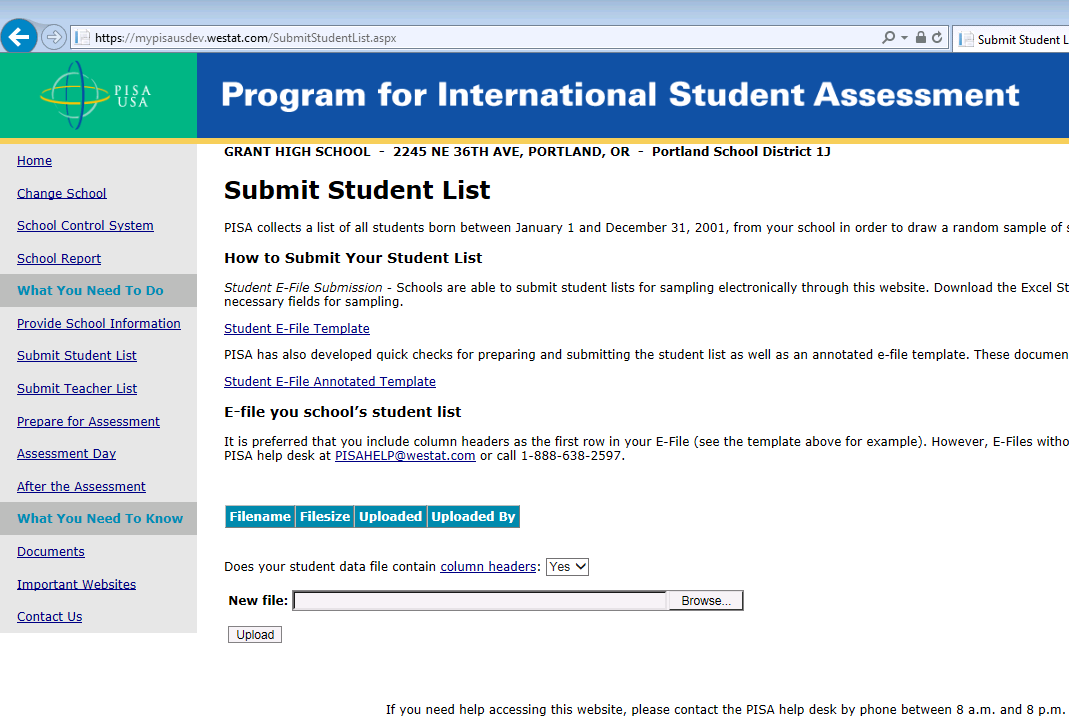
Step 2: Map Columns. The column headings in your file are shown in rows on the left side of the page. In each row, for each heading on the left, click on the down arrow next to the words in the table that read "Column Contains..." on the right. If there is no appropriate description in the drop-down list for your column heading, select N/A.
Exhibit 2. Submit Student List – Identify Your Columns



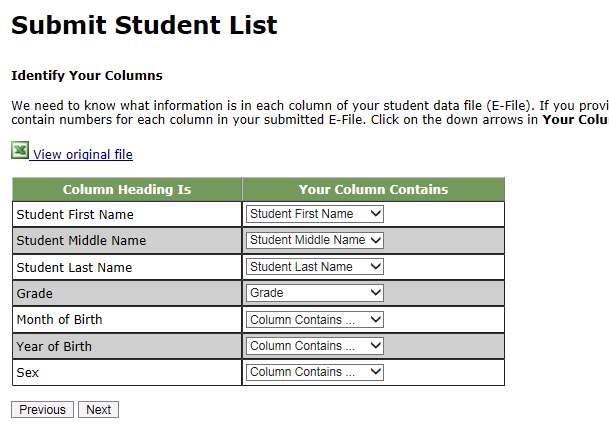
Step 3: Match Values to PISA Codes. The next step is matching the values on your file to PISA codes. The values in your columns will again be displayed on the left. Select the corresponding PISA code from the drop down list on the right (see exhibit 3). If there is no appropriate description in the drop-down list for your column heading, select N/A. When you are finished matching your values to PISA codes, click next. Repeat the above instructions to assign male/female codes and click next (see exhibit 4).
Exhibit 3. Submit Student List - Match your Values to PISA Codes (grade mapping)

Exhibit 4. Submit Student List - Match your Values to PISA Codes
(sex mapping)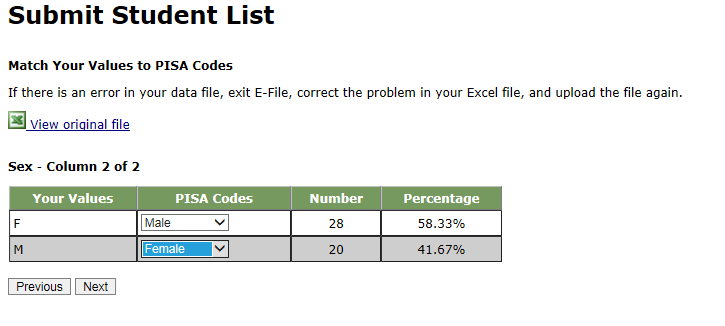
Step 4: Verify your E-file. The final step is to verify that the information is correct and submit your file. Check that the distribution of students by grade and sex match the total number of students you submitted. Indicate whether this information is correct and click “Submit.” If the information is incorrect click “Incorrect” and then click on the “Submit Student List” link on the left side of the screen. This will save your progress and exit the current e-file. You can access this file again or upload a new corrected file and start over using the same file upload process described in Step 1.
Exhibit 5. Submit Student List –Verify your E-file
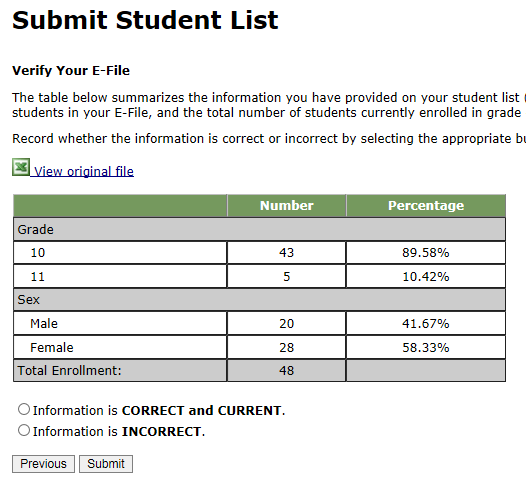
Online Student Data Checks - After you click “Submit” a number of online data validation checks are performed by our programs. These checks include checking the number of listed students against statistical estimates, making sure there is an accurate distribution of students by grade based on statistical estimates, checking that all students included are birth-year eligible (born on or between July 1, 2002 and June 30, 2003), and checking for any missing data. If the data fail these online checks, you will be presented with a screen that describes the issue, the location of the row(s) in your file that contains the errant data, and will need to correct the file and upload a new version. Exhibit 6 (below) provides an example of a file with missing data. Notice that the affected row is provided for each instance where the check failed. This is designed to help you efficiently locate and ameliorate any issues. Exhibit 7 provides an example of a file where ineligible students were included.
Exhibit 6. Online data check – missing data
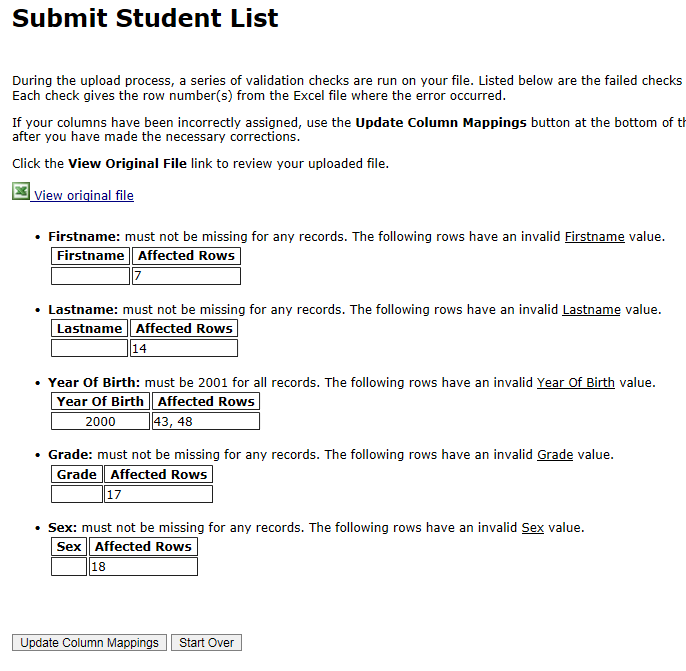
Exhibit 7. Online data check – ineligible birth year
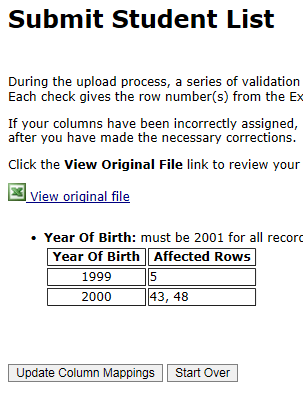
Along with the file validation checks, the total number of students is compared to the statistical estimate of eligible students. If there is a 10% or more difference in enrollment, which is typical for most every school, international standards for data collection require that we ask school coordinators for a possible reason. Typical reasons include redistricting, the schools being located within a growing or shrinking community, or near an army base. Exhibit 8 provides a screen shot of the enrollment verification check and comment box. This check does not prohibit you from completing your e-file. Simply provide a comment in the box and continue.
Exhibit 8. Online data check – enrollment verification
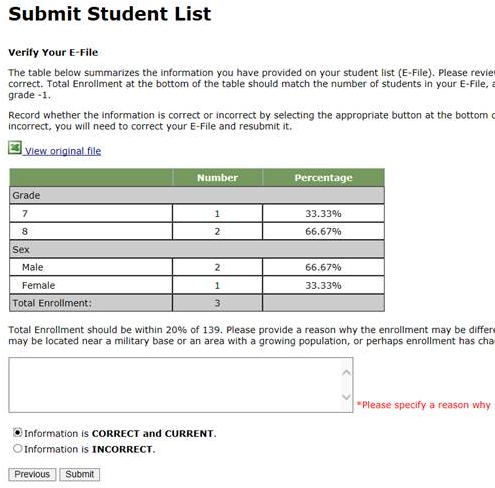
If at any time you realize that every eligible student was not listed, you can exit e-filing, correct the file, and upload a new one. If you have any questions or would like to talk with someone about e-filing, please reach out to the PISA help desk by phone between 8 a.m. and 8 p.m. Eastern Time at 1-888-638-2597 or email [email protected].
Note that neither students nor teachers can be sampled until your student and teacher lists are both submitted.
Preparing the PISA Electronic Teacher File (E-File)
Step 1: Identify ALL teachers at your school who are eligible to teach 10th grade students whether or not they currently do.
Criteria for PISA teacher eligibility are:
All teachers regardless of content specialty qualified to teach 10th grade students whether or not they currently do.
Teacher-aides, assistants, and other school staff who are not certified to autonomously teach 10th grade students are not eligible.
PISA needs accurate information about all teachers at your school who are eligible to teach 10th grade students. In addition to listing all teachers who are eligible to teach 10th grade students, PISA needs you to identify which ones are currently teaching 10th grade students and which ones are currently teaching English/language arts.
Teachers who currently teach any 10th grade students should be indicated as “Yes, teaches 10th grade” (see exhibit 10 below).
Teachers who currently teach any level of English/language arts (e.g., writing, composition, language and literature, AP English) should be indicated as “Yes, teaches ELA.”
Step 2: List each of the eligible teachers.
Using the electronic listing form template provided on the MyPISA.us website (www.MyPISA.us), list teachers in your school who are eligible for PISA along with their other necessary information.
Teacher first name
Teacher middle name (not required)
Teacher last name
Whether or not they currently teach 10th grade (20 indicates yes, they teach 10th grade; 30 indicates they do not)
Whether or not they currently teach an English/language arts course (4 indicates yes, they currently teach English/language arts; 5 indicates they do not)
Email address (this is needed to deliver their log in credentials electronically)
Exhibit 10. Example Teacher listing Form
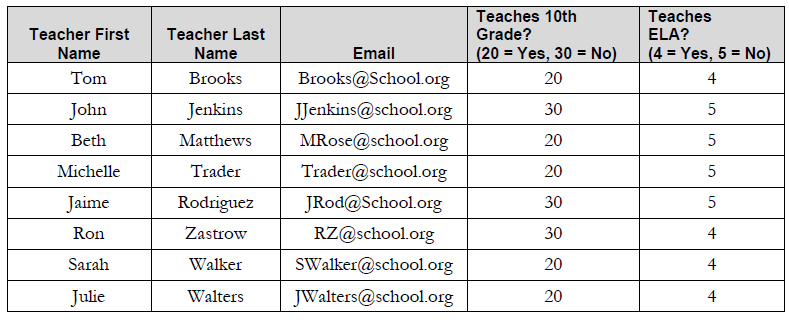
Submitting the PISA Electronic Teacher File (E-File)
Step 1: Upload file. After you have created and saved your teacher E-File, proceed to www.MyPISA.us. Once you have logged in, click the ‘Submit Teacher List’ link on the left side of the page (box 1 below) underneath the “Submit Student Link.” Then click the “Browse” button to locate your file (box 2 below). Once you’ve located the file and clicked ok, click “Upload” (box 3 below).
Exhibit 11. Submit Teacher List - initial screen
3
1
2





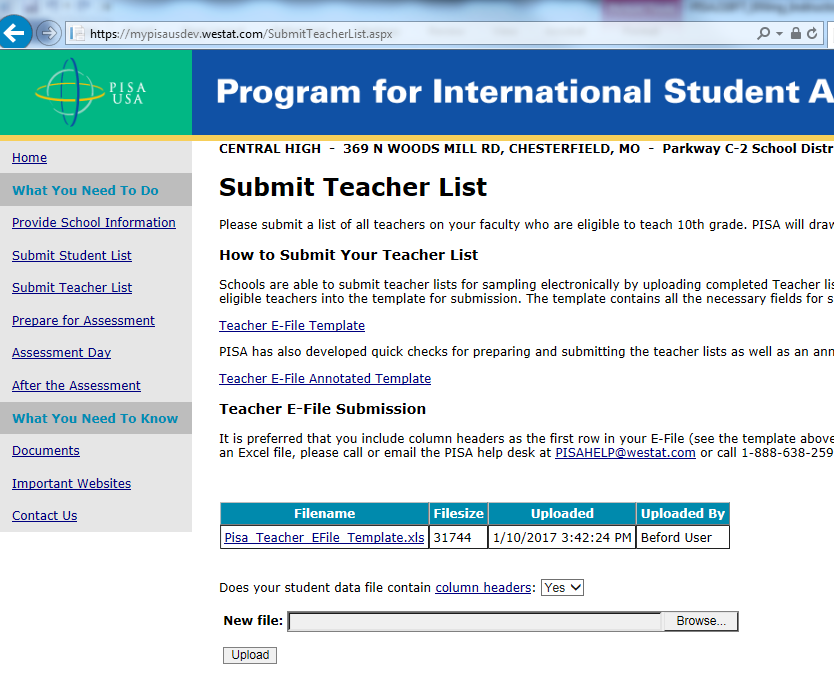
Step 2: Map Columns. The column headings in your file are shown in rows on the left side of the page. In each row, for each heading on the left, click on the down arrow next to the words in the table that read "Column Contains..." on the right. If there is no appropriate description in the drop-down list for your column heading, select N/A.



Exhibit 12. Submit Teacher List – Identify Your Columns
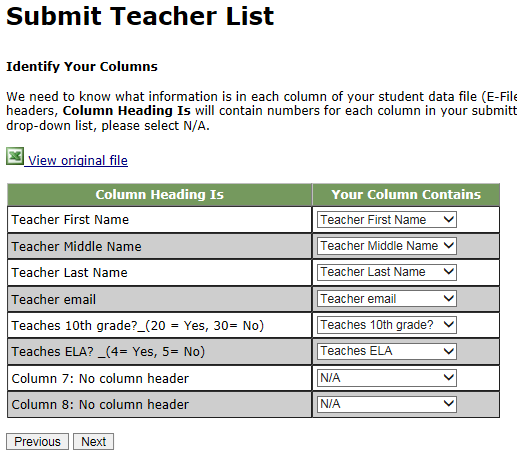
Step 3: Match Values to PISA Codes. The next step is matching the values on your file to PISA codes. The values in your column will again be displayed on the left. Select the corresponding PISA code from the drop down list (see exhibit 13). If there is no appropriate description in the drop-down list for your column heading, select N/A. When you are finished matching your values to PISA codes, click next. Repeat the above instructions to assign ELA codes and click next (see exhibit 14).
Exhibit 13. Submit Teacher List - Match your Values to PISA Codes (Teaches grade 10? mapping)
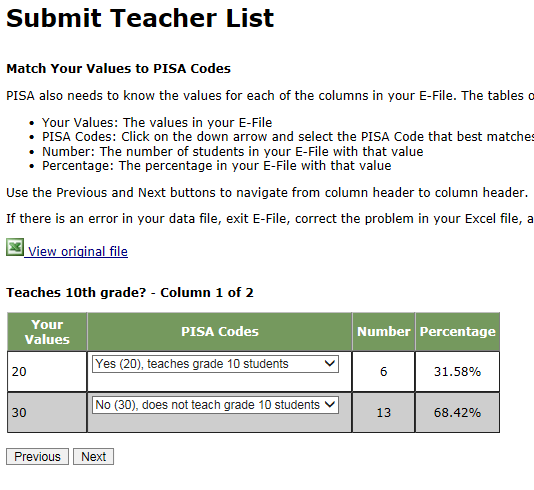
Exhibit 14. Submit Teacher List - Match your Values to PISA Codes (ELA mapping)
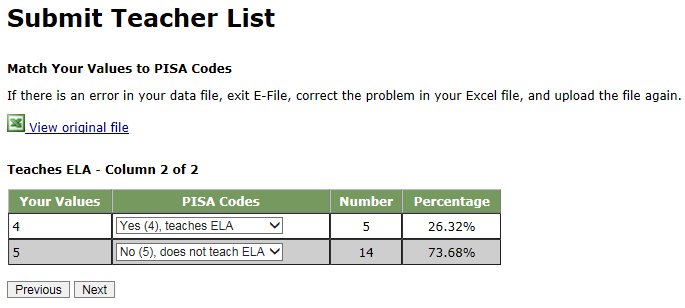
Step 4: Verify your E-file. The final step is to verify that the information is correct and submit your file. Check that the distribution of teachers by “ELA” status and “Teaches grade 10?” status match the total number of teachers you submitted. Indicate whether this information is correct and click “Submit.” If the information is incorrect click “Incorrect” and then click on the “Submit Teacher List” link on the left side of the screen. This will save your progress and exit the current e-file. You can access this file again or upload a new corrected file and start over using the same file upload process described in Step 1.
Exhibit 15. Submit Teacher List –Verify your E-file
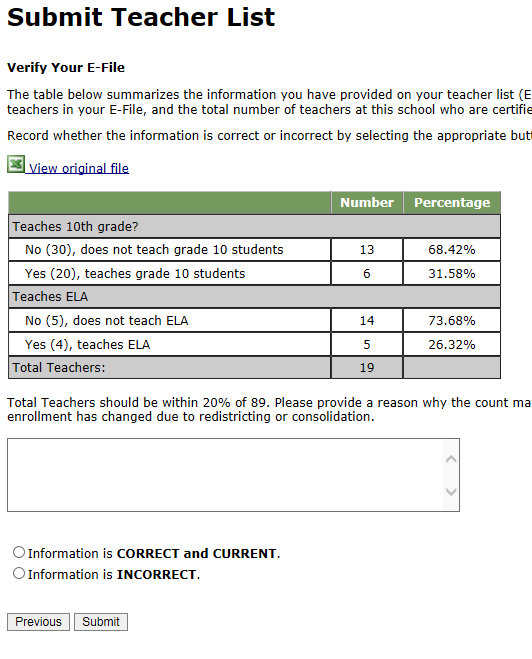
Online Teacher Data Checks. Similar to the student data, validation checks are run on the teacher data and the screens are almost identical to the student data check screens. Refer to Exhibits 6 and 7 for pictures of how the checks are displayed on the screen. If there is a difference of 20% or more between the number of teachers provided and the number of teacher expected, international standards for data collection require that we ask school coordinators for a possible reason. Typical reasons include redistricting, the schools being located within a growing or shrinking community or near an army base, budgetary reasons, or school reorganization. Exhibit 15 (above) provides a screen shot of the teacher verification check and comment box. This check does not prohibit you from completing your e-file. Simply provide a comment in the box and continue by indicating that the information is correct and clicking “Submit.”
If at any time you realize that every eligible teacher was not listed, you can exit e-filing, correct the file, and upload a new one by clicking on the “Submit Teacher List” link and uploading a new file. If you have any questions or would like to talk with someone about e-filing, please reach out to the PISA help desk by phone between 8 a.m. and 8 p.m. Eastern Time at 1-888-638-2597 or email [email protected].
PISA E-file reminder email to School Coordinator
Subject: PISA E-File Reminder
Attachment: PISA 2018 E-Filing Instructions
Dear School Coordinator:
Welcome and thank you for your efforts as the school coordinator for the Program for International Student Assessment (PISA) 2018 at your school!
We are nearing the deadline for your student and teacher lists to be submitted for sampling (September 7, 2018). Please upload your school’s list as soon as possible so that sampled students and teachers can be notified about the study.
Detailed instructions for submitting your lists to PISA are included in the enclosed document titled PISA 2018 E-Filing Instructions.
If you have any questions about the instructions, please contact the PISA Help Desk 1-888-638-2597, or send an email to [email protected]. The e-filing instructions are also posted on the MyPISA.us website (www.mypisa.us).
Sincerely,
The PISA USA Team
The National Center for Education Statistics (NCES), within the U.S. Department of Education, conducts the Program for International Student Assessment (PISA) in the United States as authorized by the Education Sciences Reform Act of 2002 (ESRA 2002, 20 U.S.C. §9543). All of the information you provide may be used only for statistical purposes and may not be disclosed, or used, in identifiable form for any other purpose except as required by law (20 U.S.C. §9573 and 6 U.S.C. §151).
Email to School Coordinator when student and teacher samples are complete and Student Tracking, Teacher Tracking Form/School Logon Forms/Teacher Logon Invitations have been posted to MyPISA.us
Subject: PISA Teacher Sampling Complete
Hello!
We have processed the list of students and teachers from your school and selected a sample of students for the assessment and teachers for the Teacher Questionnaire. The following materials are now available on www.MyPISA.us:
• Student Tracking Form
• Teacher Tracking Form
• School Questionnaire Logon Form
• Teacher Questionnaire Logon Forms
To access the files:
1. Log into www.MyPISA.us with your username/password.
2. Click the Documents link in the "What you Need to Know" section.
4. Click on the link in the upper center of the page under "Download Your School's materials here:"
To open the files, use the password 1x2y3z45a6
Please review and update the Student Tracking Form following the steps provided in chapter 3, section 3.3 of your School Coordinator Handbook.
Please distribute the School and Teacher Questionnaire Logon Forms and update the Teacher Tracking Form following the steps provided in chapter 3, sections 3.5 - 3.7 of your School Coordinator Handbook.
Your PISA Test Administrator will be in contact with you to plan for the assessment. He or she can assist you in answering any questions you may have.
If you have any further questions, please feel free to call the PISA Help Desk at 1-888-638-2597, or send an email to [email protected]
Thank you again!
The PISA Team
The National Center for Education Statistics (NCES), within the U.S. Department of Education, conducts the Program for International Student Assessment (PISA) in the United States as authorized by the Education Sciences Reform Act of 2002 (ESRA 2002, 20 U.S.C. §9543). All of the information you provide may be used only for statistical purposes and may not be disclosed, or used, in identifiable form for any other purpose except as required by law (20 U.S.C. §9573 and 6 U.S.C. §151).
PISA 2018 Respondent Communications
PISA 2018 – Teacher Questionnaire Invitation
Dear «teacherFirstLast»:
Your school is one of 200 schools across the United States that has accepted an invitation from NCES to participate in PISA 2018. You’ve been sampled to participate by completing an online teacher questionnaire about the courses you teach, your teacher training and education, and your views on teaching. If you have any questions about how you were selected for this survey, please contact your PISA school coordinator, «SC_FNAME» «SC_LNAME».
The questionnaire takes about 30 minutes to complete. This information, combined with responses from school principals and students, helps to provide a more complete understanding of student achievement and contexts for learning.
You will receive $25 for completing the questionnaire, if allowed by your school’s policy. Use the provided link and unique account information below to complete your questionnaire.
Link:
https://portal.mypisa.us/TeacherQuestionnaire
Username:
«KQID»
Password:
«TEACHPWD»
PISA is conducted in the United States by the National Center for Education Statistics (NCES), within the U.S. Department of Education, and is administered by Westat, a firm in Rockville, Maryland. The U.S. Office of Management and Budget has approved the data collection under OMB #1850-0755.
If you have any questions, please do not hesitate to call 1-888-638-2597 or send an email to [email protected]
You may also get more information about this study by visiting the PISA website at http://nces.ed.gov/surveys/pisa
Thank you for your time and for supporting this important international study.
Sincerely,
The PISA USA Team
The National Center for Education Statistics (NCES), within the U.S. Department of Education, conducts the Program for International Student Assessment (PISA) in the United States as authorized by the Education Sciences Reform Act of 2002 (ESRA 2002, 20 U.S.C. §9543). All of the information you provide may be used only for statistical purposes and may not be disclosed, or used, in identifiable form for any other purpose except as required by law (20 U.S.C. §9573 and 6 U.S.C. §151).
PISA2018– Principal Questionnaire Invitation
Dear «principal»:
The United States is participating in an important international study: the Program for International Student Assessment (PISA). PISA is the largest international assessment of education in the world, with more than 80 countries and education systems participating in each cycle. It provides comparative information on the performance of U.S. 15-year-old students in science, reading, and mathematics with 15-year-old students in other countries.
Your school is one of 200 schools across the United States that are taking part in PISA 2018. Part of the study is an online school questionnaire that the principals of the selected schools complete. The questionnaire takes about 45 minutes to complete. This information, combined with responses from teachers and students, helps to provide a more complete understanding of student achievement and contexts for learning.
Use the provided link and unique account information below to complete your questionnaire.

Link: https://portal.mypisa.us/SchoolQuestionnaire
Username:840-00-99-001
Password:
1234567
PISA is conducted in the United States by the National Center for Education Statistics (NCES), within the U.S. Department of Education, and is administered by Westat, a firm in Rockville, Maryland. The U.S. Office of Management and Budget has approved the data collection under OMB #1850-0755.
If you have any questions, please do not hesitate to call 1-888-638-2597 or send an email to [email protected]
You may also get more information about this study by visiting the PISA website at http://nces.ed.gov/surveys/pisa
Thank you for your time and for supporting this important international study.
Sincerely,
The PISA USA Team
The National Center for Education Statistics (NCES), within the U.S. Department of Education, conducts the Program for International Student Assessment (PISA) in the United States as authorized by the Education Sciences Reform Act of 2002 (ESRA 2002, 20 U.S.C. §9543). All of the information you provide may be used only for statistical purposes and may not be disclosed, or used, in identifiable form for any other purpose except as required by law (20 U.S.C. §9573 and 6 U.S.C. §151).
PISA Questionnaire Login Pages – School
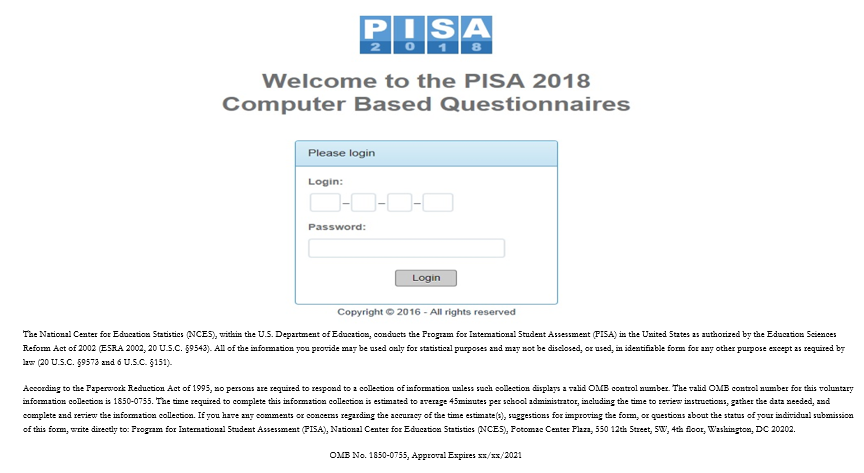
School questionnaire login page text for main study
The National Center for Education Statistics (NCES), within the U.S. Department of Education, conducts the Program for International Student Assessment (PISA) in the United States as authorized by the Education Sciences Reform Act of 2002 (ESRA 2002, 20 U.S.C. §9543). All of the information you provide may be used only for statistical purposes and may not be disclosed, or used, in identifiable form for any other purpose except as required by law (20 U.S.C. §9573 and 6 U.S.C. §151).
According to the Paperwork Reduction Act of 1995, no persons are required to respond to a collection of information unless such collection displays a valid OMB control number. The valid OMB control number for this voluntary information collection is 1850-0755. The time required to complete this information collection is estimated to average 45 minutes per school administrator, including the time to review instructions, gather the data needed, and complete and review the information collection. If you have any comments or concerns regarding the accuracy of the time estimate(s), suggestions for improving the form, or questions about the status of your individual submission of this form, write directly to: Program for International Student Assessment (PISA), National Center for Education Statistics (NCES), Potomac Center Plaza, 550 12th Street, SW, 4th floor, Washington, DC 20202.
OMB No. 1850-0755, Approval Expires xx/xx/2021
PISA Questionnaire Login Page – Teacher

Teacher questionnaire login page text for main study
The National Center for Education Statistics (NCES), within the U.S. Department of Education, conducts the Program for International Student Assessment (PISA) in the United States as authorized by the Education Sciences Reform Act of 2002 (ESRA 2002, 20 U.S.C. §9543). All of the information you provide may be used only for statistical purposes and may not be disclosed, or used, in identifiable form for any other purpose except as required by law (20 U.S.C. §9573 and 6 U.S.C. §151).
According to the Paperwork Reduction Act of 1995, no persons are required to respond to a collection of information unless such collection displays a valid OMB control number. The valid OMB control number for this voluntary information collection is 1850-0755. The time required to complete this information collection is estimated to average 30 minutes per teacher, including the time to review instructions, gather the data needed, and complete and review the information collection. If you have any comments or concerns regarding the accuracy of the time estimate(s), suggestions for improving the form, or questions about the status of your individual submission of this form, write directly to: Program for International Student Assessment (PISA), National Center for Education Statistics (NCES), Potomac Center Plaza, 550 12th Street, SW, 4th floor, Washington, DC 20202.
OMB No. 1850-0755, Approval Expires xx/xx/2021
PISA 2018– Principal Reminder 1
Dear Principal:
Thank you, your students, and colleagues for participating in PISA!
The data collection window is more than half way through, and closes on November 23. We are reaching out to remind you (or a designee) to complete the school questionnaire for your school prior to November 23.
Use the provided link and unique account information below to access the questionnaire for your school.
Link: https://portal.mypisa.us/SchoolQuestionnaire
Username:«KQID»
Password:
«TEACHPWD»
PISA is conducted in the United States by the National Center for Education Statistics (NCES), within the U.S. Department of Education, and is administered by Westat, a firm in Rockville, Maryland. The U.S. Office of Management and Budget has approved the data collection under OMB #1850-0755.
If you have any questions, please do not hesitate to call 1-888-638-2597 or send an email to [email protected]
You may also get more information about this study by visiting the PISA website at http://nces.ed.gov/surveys/pisa
Thank you for your time and for supporting this important international study.
Sincerely,
The PISA USA Team
The National Center for Education Statistics (NCES), within the U.S. Department of Education, conducts the Program for International Student Assessment (PISA) in the United States as authorized by the Education Sciences Reform Act of 2002 (ESRA 2002, 20 U.S.C. §9543). All of the information you provide may be used only for statistical purposes and may not be disclosed, or used, in identifiable form for any other purpose except as required by law (20 U.S.C. §9573 and 6 U.S.C. §151).
PISA 2018–Teacher Reminder 1
Dear «NAME»:
This is a reminder that you’ve been sampled to participate in the PISA Teacher Questionnaire.
The questionnaire takes about 30 minutes to complete. Information you provide, combined with responses from school principals and students, helps achieve a more complete understanding of student achievement and contexts for learning. If you have any questions about how you were selected for this survey, please contact your PISA school coordinator, «SC_FNAME» «SC_LNAME».
You will receive $25 for completing the questionnaire, if allowed by your school’s policy. Use the provided link and unique account information below to complete your questionnaire.
Link:https://portal.mypisa.us/TeacherQuestionnaire
Username:«KQID»
Password:
«TEACHPWD»
PISA is conducted in the United States by the National Center for Education Statistics (NCES), within the U.S. Department of Education, and is administered by Westat, a firm in Rockville, Maryland. The U.S. Office of Management and Budget has approved the data collection under OMB #1850-0755.
If you have any questions, please do not hesitate to call 1-888-638-2597 or send an email to [email protected]
You may also get more information about this study by visiting the PISA website at http://nces.ed.gov/surveys/pisa
Thank you for your time and for supporting this important international study.
Sincerely,
The PISA USA Team
The National Center for Education Statistics (NCES), within the U.S. Department of Education, conducts the Program for International Student Assessment (PISA) in the United States as authorized by the Education Sciences Reform Act of 2002 (ESRA 2002, 20 U.S.C. §9543). All of the information you provide may be used only for statistical purposes and may not be disclosed, or used, in identifiable form for any other purpose except as required by law (20 U.S.C. §9573 and 6 U.S.C. §151).
PISA 2018– Principal Reminder 2
Dear Principal:
Thank you, your students, and colleagues for participating in PISA!
The data collection window is more than half way through, and closes on November 23. We are reaching out to remind you (or a designee) to complete the school questionnaire for your school prior to November 23.
Use the provided link and unique account information below to access the questionnaire for your school.
Link: https://portal.mypisa.us/SchoolQuestionnaire
Username:«KQID»
Password:
«TEACHPWD»
PISA is conducted in the United States by the National Center for Education Statistics (NCES), within the U.S. Department of Education, and is administered by Westat, a firm in Rockville, Maryland. The U.S. Office of Management and Budget has approved the data collection under OMB #1850-0755.
If you have any questions, please do not hesitate to call 1-888-638-2597 or send an email to [email protected]
You may also get more information about this study by visiting the PISA website at http://nces.ed.gov/surveys/pisa
Thank you for your time and for supporting this important international study.
Sincerely,
The PISA USA Team
The National Center for Education Statistics (NCES), within the U.S. Department of Education, conducts the Program for International Student Assessment (PISA) in the United States as authorized by the Education Sciences Reform Act of 2002 (ESRA 2002, 20 U.S.C. §9543). All of the information you provide may be used only for statistical purposes and may not be disclosed, or used, in identifiable form for any other purpose except as required by law (20 U.S.C. §9573 and 6 U.S.C. §151).
PISA 2018–Teacher Reminder 2
Dear «NAME»:
Thank you, your students, and colleagues for participating in the PISA!
The data collection window is more than half way through, and closes on November 23. We are reaching out to remind you to login to the PISA teacher questionnaire prior to November 23 to receive $25.00 for participating.
If you have any questions about how you were selected for this survey, please contact your PISA school coordinator, «SC_FNAME» «SC_LNAME».
Use the provided link and unique account information below to access your questionnaire.
Link: https://portal.mypisa.us/TeacherQuestionnaire
Username:«KQID»
Password:
«TEACHPWD»
The questionnaire takes about 30 minutes to complete. Information you provide, combined with responses from other teachers, school principals, and students, helps develop an understanding of student achievement and contexts for learning.
PISA is conducted in the United States by the National Center for Education Statistics (NCES), within the U.S. Department of Education, and is administered by Westat, a firm in Rockville, Maryland. The U.S. Office of Management and Budget has approved the data collection under OMB #1850-0755.
If you have any questions, please do not hesitate to call 1-888-638-2597 or send an email to [email protected]
You may also get more information about this study by visiting the PISA website at http://nces.ed.gov/surveys/pisa
Thank you for your time and for supporting this important international study.
Sincerely,
The PISA USA Team
The National Center for Education Statistics (NCES), within the U.S. Department of Education, conducts the Program for International Student Assessment (PISA) in the United States as authorized by the Education Sciences Reform Act of 2002 (ESRA 2002, 20 U.S.C. §9543). All of the information you provide may be used only for statistical purposes and may not be disclosed, or used, in identifiable form for any other purpose except as required by law (20 U.S.C. §9573 and 6 U.S.C. §151).
PISA 2018–Teacher Reminder 3
Dear «NAME»:
We are reaching out to remind you to complete the PISA online questionnaire for which you’ve been sampled. If you have any questions about how you were selected for this survey, please contact your PISA school coordinator, «SC_FNAME» «SC_LNAME».
Login to the PISA teacher questionnaire prior to November 23 to receive $25.00 for participating. Use the provided link and unique account information below to access your questionnaire.
Link: https://portal.mypisa.us/TeacherQuestionnaire
Username:«KQID»
Password:
«TEACHPWD»
Information you provide, combined with responses from other teachers, school principals, and students, helps develop an understanding of student achievement and contexts for learning. The questionnaire takes about 30 minutes to complete and can be completed in one or multiple sessions.
We’ll send a reminder closer to the deadline. If you do not want to receive these messages, please inform your PISA school coordinator, «SC_FNAME» «SC_LNAME» that you do not want to participate in PISA.
PISA is conducted in the United States by the National Center for Education Statistics (NCES), within the U.S. Department of Education, and is administered by Westat, a firm in Rockville, Maryland. The U.S. Office of Management and Budget has approved the data collection under OMB #1850-0755.
If you have any questions, please do not hesitate to call 1-888-638-2597 or send an email to [email protected]
You may also get more information about this study by visiting the PISA website at http://nces.ed.gov/surveys/pisa
Thank you for your time and for supporting this important international study.
Sincerely,
The PISA USA Team
The National Center for Education Statistics (NCES), within the U.S. Department of Education, conducts the Program for International Student Assessment (PISA) in the United States as authorized by the Education Sciences Reform Act of 2002 (ESRA 2002, 20 U.S.C. §9543). All of the information you provide may be used only for statistical purposes and may not be disclosed, or used, in identifiable form for any other purpose except as required by law (20 U.S.C. §9573 and 6 U.S.C. §151).
PISA 2018–Teacher Final Reminder
Dear «NAME»:
Thank you, your students, and colleagues for participating in the PISA!
The data collection window for PISA ends tomorrow November 23. We are reaching out a final time to remind you to login to the PISA teacher questionnaire by tomorrow night to receive $25.00 for participating.
If you have any questions about how you were selected for this survey, please contact your PISA school coordinator, «SC_FNAME» «SC_LNAME».
Use the provided link and unique account information below to access your questionnaire.
Link: https://portal.mypisa.us/TeacherQuestionnaire
Username:«KQID»
Password:
«TEACHPWD»
The questionnaire takes about 30 minutes to complete. Information you provide, combined with responses from other teachers, school principals, and students, helps develop an understanding of student achievement and contexts for learning.
PISA is conducted in the United States by the National Center for Education Statistics (NCES), within the U.S. Department of Education, and is administered by Westat, a firm in Rockville, Maryland. The U.S. Office of Management and Budget has approved the data collection under OMB #1850-0755.
If you have any questions, please do not hesitate to call 1-888-638-2597 or send an email to [email protected]
You may also get more information about this study by visiting the PISA website at http://nces.ed.gov/surveys/pisa
Thank you for your time and for supporting this important international study.
Sincerely,
The PISA USA Team
The National Center for Education Statistics (NCES), within the U.S. Department of Education, conducts the Program for International Student Assessment (PISA) in the United States as authorized by the Education Sciences Reform Act of 2002 (ESRA 2002, 20 U.S.C. §9543). All of the information you provide may be used only for statistical purposes and may not be disclosed, or used, in identifiable form for any other purpose except as required by law (20 U.S.C. §9573 and 6 U.S.C. §151).
PISA School Coordinator Manual Cover Letter
Dear School Coordinator:
Welcome and thank you for your efforts as the school coordinator for Program for International Student Assessment (PISA) 2018 at your school. In PISA 2018, the United States will participate along with more than 80 other countries and education systems in a study that produces important international benchmarks in reading, mathematics, science, and financial literacy of 15-year-old students. Your assistance is critical to the success of the study.
If you have not already done so, the first step is to generate an electronic student list of all 15-year-old students and all teachers who are eligible to teach the 10th grade in your school and to submit it to PISA via the MyPISA.us secure website. Detailed instructions for how to submit student and teacher lists to PISA are included in a document titled PISA 2018 E-Filing Instructions that was emailed to you. These instructions can also be found in Appendix C of the enclosed School Coordinator Handbook. If you would like that document emailed to you again, please contact the PISA Help Desk at [email protected] or by calling 1-888-638-2597. The e-filing instructions are also posted on the MyPISA.us website (www.mypisa.us) .
After submitting your student and teacher lists for e-filing, you will receive an email notifying you that your school’s tracking forms, which list the selected students and teachers, are ready for you to download from MyPISA.us. Once downloaded, please review and update the information as necessary. The enclosed document, PISA 2018 School Coordinator Handbook, describes what you should do with each form you downloaded.
Your PISA representative will contact you in approximately 2 weeks to review the PISA materials with you, answer any questions you may have, and set up a pre-assessment visit at your school to:
* identify students with special needs who may need accommodations to be tested, or may not be able to participate in the assessment;
* identify other students listed who cannot participate (withdrawn or ineligible for other reasons);
* confirm the date, time, and location for the assessment sessions;
* meet with selected students to introduce them to PISA and motivate them to participate and do their best; and
* review parent/guardian notification.
Thank you for your time and support of this important international study. We look forward to working with you to make PISA a positive experience for your school.
Sincerely,
The PISA USA Team


PISA
2018
SCHOOL COORDINATOR’S HANDBOOK
The National Center for Education Statistics (NCES), within the U.S. Department of Education, conducts the Program for International Student Assessment (PISA) in the United States as authorized by the Education Sciences Reform Act of 2002 (ESRA 2002, 20 U.S.C. §9543). All of the information you provide may be used only for statistical purposes and may not be disclosed, or used, in identifiable form for any other purpose except as required by law (20 U.S.C. §9573 and 6 U.S.C. §151).
OMB
No. 1850-0755, Approval Expires xx/xx/2021
If you have any questions, please contact us at: PISA Help Desk Phone: 1-888-638-2597 Fax: 240-314-2334 Email: [email protected] For more information about PISA, visit the PISA website: http://nces.ed/gov/surveys/pisa |
1.3. Role of the school coordinator 2
1.3.1. Key activities for the school coordinator 2
CHAPTER 2: PRELIMINARY TASKS 6
2.1. Confirm date and location for the assessment sessions 6
CHAPTER 3: BEFORE THE ASSESSMENT DAy 8
3.1. Receive and check PISA materials 8
3.2. Notify school staff, students, and parents of the assessment 8
3.3. Review and update the Student Tracking Form 9
3.3.1. Steps for reviewing and completing the Student Tracking Form 9
3.3.2. Summary of non-participant codes 16
3.3.3. Students to be assessed in PISA 18
3.5. Distribute School Questionnaire Logon Form to appropriate person at your school 19
3.6. Distribute Teacher Questionnaire Logon Forms to sampled teachers 19
3.7. Confirm School and Teacher Questionnaire completion 19
4.1. Meet with the test administrator before the assessment 22
4.2. Arrange for support staff to be present throughout each session (if possible) 22
4.3. Meet with the test administrator after the assessment 23
Appendix A. PISA Forms
Appendix B. School Questionnaire Questions
Appendix C. PISA 2018 E-Filing Instructions
Thank you for agreeing to be a school coordinator for PISA 2018. As your school has been selected to represent the United States in this large-scale international assessment program, you will play a very important role in making sure that the assessment is carried out smoothly and in a standard way. In doing so, you will contribute significantly to the PISA objectives of improving the quality of schooling for students in the United States. This manual provides instructions on the tasks you will need to complete for implementing PISA in your school.
1.1. What is PISA?
PISA stands for the Program for International Student Assessment, sponsored by the Organization for Economic Cooperation and Development (OECD). PISA has been conducted every 3 years since 2000 and involves more than 80 participating countries. The PISA 2018 will be conducted in fall of 2018.
PISA has the following characteristics:
The world’s largest international survey in education
Surveys students aged about 15 years
Assesses students’ preparedness for adult life
Measures students’ literacy in reading, science, mathematics, and financial matters
Collects contextual information about educational practices in participating countries
Undertaking PISA is important because the results of the assessment can be used to
indicate how well prepared students in the United States are for learning once they leave school;
identify areas for improvement over time by schools, education systems, and governments;
allow a comparison of student performance and the learning environment between different countries.
For more details about PISA, refer to the OECD website at https://www.oecd.org/pisa.
Note on Confidentiality All of the information provided by you, other school staff, and students may be used only for statistical purposes and may not be disclosed, or used, in identifiable form for any other purpose except as required by law (20 U.S.C. §9573 and 6 U.S.C. §151).. No participating individual or school will be identified in any report released by the assessment program. |
1.2. Components of PISA
The following describes the assessment and the different types of questionnaires.
1.2.1. PISA assessment day
Up to 52 students from your school will be randomly sampled to complete a 2-hour computer-based assessment consisting of combinations of questions in reading, mathematics, and science. They then return after a break (preferably lunch) and complete about a 1-hour Student Questionnaire, which consists of questions that examine students’ attitudes towards learning, their experience with money matters in and outside of school, and their activities and familiarity with information/communication technology.
1.2.2. PISA questionnaires
Questionnaires are an important part of PISA and provide valuable information that expands the assessment results. As school coordinator, you are tasked with overseeing the School and Teacher Questionnaires and monitoring the completion on www.MyPISA.us
The School Questionnaire collects information about how education systems work within and between countries. The School Questionnaire should be completed online by the school’s head administrator using a school-specific login and password. The questionnaire takes about 45 minutes to complete.
The Teacher Questionnaire provides key information on classroom instruction and gives insight into teachers’ educational backgrounds, training, and teaching experiences. The Teacher Questionnaires will be completed online and should take about 30 minutes to complete.
1.3. Role of the school coordinator
As a school coordinator, you act as the liaison between your school and the PISA test administrator. The actual assessment will be conducted by the test administrator.
1.3.1. Key activities for the school coordinator
The school coordinator will assist the test administrator with preparations before and on assessment day.
PISA has provided a website, www.MyPISA.us to facilitate the communication between your school and the study. One of the key activities as school coordinator is providing an electronic file of students (student E-File) and an electronic file of teachers (teacher E-File) that lists all eligible students and all eligible teachers. If you have yet to submit these files, instructions for preparing and submitting the files can be found in the “Documents” section on www.MyPISA.us or see appendix C. Alternatively, send an email to [email protected] and we will be glad to send them to you directly. Once your student and teacher lists have been processed and sampled, download your school’s PISA forms from the “Documents” section on www.MyPISA.us. PISA will provide you with the following:
The Student Tracking Form (lists the students selected for the PISA assessment).
The Session Attendance Form (provides the location and date/time of the assessment we have on record). You may use this form when notifying school staff and students of the date, time, and location of the assessment session.
Instructions for handling the School Questionnaire and the Teacher Questionnaires along with other informational materials.
It is essential that the procedures described in this manual are followed carefully to ensure that the PISA sessions are administered the same way in all participating countries. Failure to do so might invalidate the results of the study.
A summary of the key activities for the school coordinator is presented in exhibit 1.1.
Exhibit 1.1. Key activities for PISA school coordinators
Stage |
Date |
Activity |
Page number |
Preliminary tasks |
3-6 weeks prior to the assessment day |
Confirm assessment date and location for the assessment sessions |
|
Before the assessment |
1-2 weeks prior to the assessment day |
Receive and check PISA materials |
|
|
|
Notify school staff, students, and parents of the assessment |
|
|
|
Review and update the Student Tracking Form |
|
|
1-2 weeks prior to assessment |
Organize and confirm assessment plans with school staff, students, parents, and test administrator |
|
|
|
Hold pre-assessment call and visit with the test administrator |
16 |
|
|
Distribute School Questionnaire Logon Form to appropriate person at your school |
|
|
A few days prior to the assessment |
Distribute Teacher Questionnaire Logon Forms to sampled teachers |
|
|
|
Confirm School and Teacher Questionnaire completion |
|
During and after the assessment |
Assessment day |
Meet with the test administrator(s) before the assessment |
|
|
|
Arrange for support staff to be present throughout each session |
|
|
|
Meet with the test administrator(s) after the assessment |
|
|
Same week as the main session (if possible) |
Arrange for a follow-up session, if needed |
|
|
|
Store PISA forms |
If you have any questions, please contact us at: PISA Help Desk Phone: 1-888-638-2597 Fax: 240-314-2334 Email: [email protected] For more information about PISA, visit the PISA website: http://nces.ed/gov/surveys/pisa |
1.3.2. PISA forms
Exhibit 1.2 lists the important forms with which you should be familiar. It is critical that you fill out these forms accurately and completely so that student performance and questionnaire responses can be validly and reliably linked to student demographics. Templates of these forms can be found in appendix A.
Exhibit 1.2. Purpose of forms
Form |
Purpose |
Completed by |
Student List (student E-File) |
Used to list all students eligible for PISA. |
School coordinator, submitted via MyPISA.us |
Teacher List (teacher E-File) |
Used to list all teachers eligible for PISA. |
School coordinator, submitted via MyPISA.us |
Student Tracking Form |
To indicate all students sampled from the school participating in PISA and to record demographic information about these students. |
PISA home office, downloaded and updated by school coordinator and test administrator |
Session Attendance Form |
To document assessment date, time, and location and student participation on assessment day |
PISA home office, test administrator |
Teacher Tracking Form |
Lists all teachers sampled to participate in PISA. |
PISA home office, downloaded and updated by school coordinator |
Teacher Questionnaire Logon Form |
To give to teachers to log onto the online Teacher Questionnaire. |
PISA home office, downloaded by school coordinator |
School Questionnaire Logon Form |
To give to the head administrator to log onto the online School Questionnaire. |
PISA home office, downloaded by school coordinator |
2.1. Confirm date and location for the assessment sessions
PISA will take place between October 1 and November 23, 2018. It is important when confirming the scheduled assessment date with the test administrator to check that there are no other events (e.g., pep rallies, college fairs, school dances) taking place at your school that could interfere with the assessment session or with the attendance of the selected students. You will then set the location and time of the assessment with the test administrator.
Information needed to plan locations and times is presented below.
Exhibit 2.1 presents the assessment timings that you should consider when reserving space for the assessment session. This includes time needed for the PISA team to set up the space before students arrive and time for packing up materials and equipment after the assessment.
It is best to schedule the session to start as early in the school day as possible to allow time to conduct the Student Questionnaire session in the afternoon, preferably after lunch. Occasionally, it may be necessary to conduct one or more sessions on another day.
When scheduling the assessment times and locations, expect to reserve the location for the assessment for 6 hours. However, if one location is not available for the full 6 hours, reserve 5 hours for the assessment and an additional 2 hours in the second location for the Student Questionnaire. This will give staff time to pack up and set up all 52 laptops in the new location.
It is suggested that you allow up to 30‒60 minutes after the assessment session has finished before beginning the Student Questionnaire session. This will provide time for students to eat and move around after the cognitive assessment.
PISA staff will bring in all computer equipment needed for the assessment. When considering an assessment location, keep the following factors in mind:
The assessment should take place in an area free of distractions and interruptions.
The space will need 2‒4 working electrical outlets.
If the school is multi-level, we would request that the assessment location be assigned on the ground floor or that access to an elevator is available to facilitate moving equipment around easily.
There will need to be enough space to set up 52 laptops, although separate rooms with less than 52 spaces are okay.
If possible, we would prefer to conduct the questionnaire in the same location(s) as the assessment so that we do not have to pack up all of the computer equipment and move it to a new location.
Exhibit 2.1. Timing of assessment
Activity |
Student Time |
Room Availability Time |
Room setup |
Not applicable |
60 minutes (approximately) |
Student logons, passwords, and introducing the assessment |
15 minutes (approximately) |
15 minutes (approximately) |
General Introduction |
5 minutes (approximately) |
5 minutes (approximately) |
First 60 minutes of test |
60 minutes (exactly) |
60 minutes (exactly) |
Short break |
Generally, no more than 5 minutes |
Generally, no more than 5 minutes |
Introducing Section 2 of test |
5 minutes (approximately) |
5 minutes (approximately) |
Second 60 minutes of test |
60 minutes (exactly) |
60 minutes (exactly) |
Break |
30‒60 minutes |
30‒60 minutes |
Student Questionnaire |
65 minutes (approximately) |
65 minutes (approximately) |
Ending the session, collection, and transfer of data |
5 minutes (approximately) |
5 minutes (approximately) |
Packing up and resetting room |
Not applicable |
40‒60minutes (approximately) |
Total |
Assessment Student Questionnaire 1 hour (approximately) Total time <4 hours |
6 hours (approximately) |
CHAPTER 3: BEFORE THE ASSESSMENT DAy
3.1. Receive and check PISA materials
After your student and teacher lists are submitted and sampled, you will be notified via email when you are able to download the following materials from the MyPISA website (www.MyPISA.US):
Student Tracking Form – lists each student who has been selected to participate in the assessment, including each student’s demographic information. An example of this is shown in exhibit 3.2.
School Questionnaire Logon Form – provides the principal/designee with the information needed to access the online School Questionnaire.
Teacher Tracking Form – indicates which teachers have been selected to receive a Teacher Questionnaire. An example of this is shown in exhibit 3.9.
Teacher Questionnaire Logon Forms – provides the selected teachers with the information needed to access the online Teacher Questionnaires.
Session Attendance Form ‒ provides assessment date, time, and location and is also used to record student participation on assessment day.
The test administrator will contact you to verify that you were able to download these forms and to confirm the date and time of the pre-assessment visit.
3.2. Notify school staff, students, and parents of the assessment
Please inform school staff, students, and parents of the assessment according to the school’s policy. It is very important that parents be notified of their student’s participation in the PISA assessment. The test administrator will collect a dated copy of the letter used to notify parents prior to the assessment. A sample copy of this letter is available for download from the MyPISA website (www.MyPISA.US).
Student meeting
Likewise, it is very important to introduce the aims of PISA to school staff, and students prior to the assessment to help engage students and promote their participation. In addition, the test administrator will work with you to plan a meeting with the students on the day of the pre-assessment visit.
During this student meeting, the test administrator will show a brief presentation that will introduce the importance of PISA as well as motivate students to participate and do their best on the assessment. The test administrator will provide Student Invitations to the assessment and Student FAQs.
Motivating students and achieving a high student participation rate are key to a successful assessment day. If fewer than 90 percent of eligible students participate on the assessment day, it may be necessary to schedule a makeup session to assess students who were absent.
If there is not sufficient time for the test administrator to visit the school in person before assessment day, another possibility is for you or a school staff member to hold the student meeting. The student presentation and instructions will be provided to you along with Student Invitations to the assessment and Student FAQs.
3.3. Review and update the Student Tracking Form
Once you have been notified by email that your school’s materials are available for download from the MyPISA.us website, review and update the Student Tracking Form. The Student Tracking Form lists all sampled students along with their demographic data. Review this form and correct any errors. An example of the Student Tracking Form is shown in exhibit 3.2. The steps for completing the form are detailed on pages 10-17.
3.3.1. Steps for reviewing and completing the Student Tracking Form
Step 1: Check student details and demographics
Having accurate information on this form is vital for data validity and for preparing certificates of service, and student invitations. Please check to make sure that each
student’s name is spelled correctly,
student’s grade is properly listed, and
student’s month of birth (MOB) and year of birth (YOB) is correctly listed.
If you identify incorrect information, correct the information on the Student Tracking Form and relay this information to the PISA test administrator assigned to work with you.
Step 2: Identify students with special education needs (SEN)
PISA uses a coding system to identify students with special education needs (SEN). Students typically referred to as students with disabilities, or English language learners in the United States, may be categorized as SEN for PISA. The SEN column of the form is used to record the special education needs of eligible students. The codes are defined in exhibit 3.1. Please identify any student who has a special education need by placing the appropriate code in the SEN column.
Exhibit 3.1. Codes for special education needs
Description |
SEN Code |
Functional disability – student has a moderate to severe permanent physical disability |
1 |
Cognitive, behavioral, or emotional disability – in the opinion of qualified staff, student has a cognitive, behavioral, or emotional disability |
2 |
Limited assessment language experience – student is not a native speaker of the language of the assessment in the country and has limited proficiency in this language |
3 |
Home schooled – student is home schooled and does not attend any classes on campus |
4 |
Examples of using special education needs codes
Please refer to exhibit 3.2 in which the following codes have been applied to the Student Tracking Form:
José Camacho is not a native English speaker and has less than 1 year of instruction in English. Therefore, he is coded as “3” in the SEN column.
Roy Edmonds is not a native speaker of English. While he has received instruction in English for more than 1 year, he still has some difficulties with English expression and requires some extra help. Therefore, he is also coded as “3” in the SEN column.
Sam Fay is blind and is coded as “1” in the SEN column.
Fred Hunt is deaf, so he is coded as “1” in the SEN column.
Lisa Jenkins has been professionally assessed as cognitively delayed and is coded as “2” in the SEN column.
For all other students who do not have any special education needs, the SEN column is left blank. For most students the SEN column will be left blank, meaning they have no special education needs.
E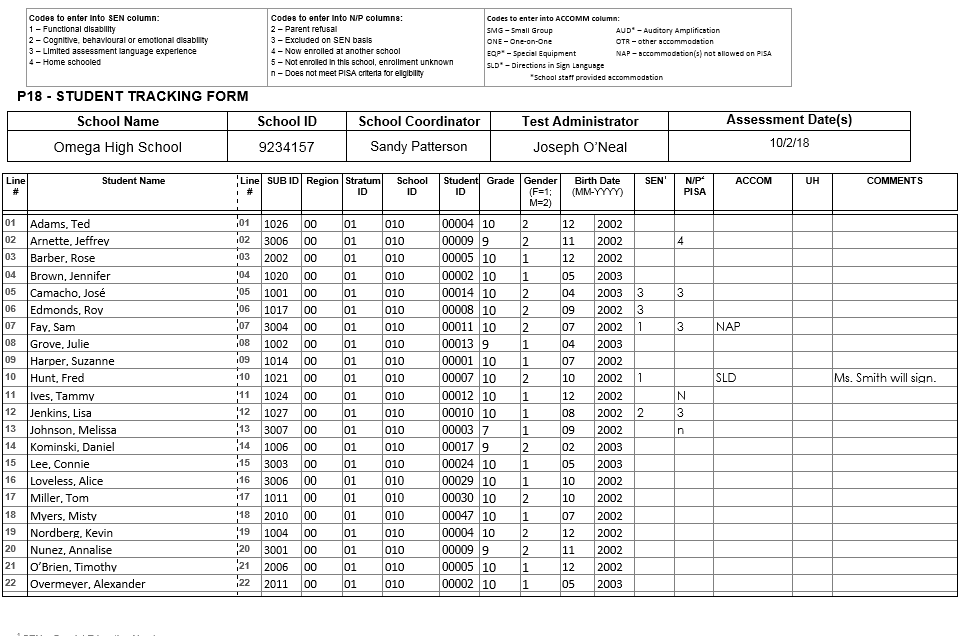
xhibit
3.2. Student Tracking Form (example after completion)
Step 3: Identify accommodations for students who require them
If any SEN students require accommodations to be tested, record those in the ACCOM column on the Student Tracking Form. Exhibit 3.3 lists the accommodations allowed on PISA along with the three-letter accommodation code. Record the three-letter code from the table in exhibit 3.3 in the ACCOM column on the Student Tracking Form.
Note on Including Students Many students with special education needs can be included in PISA without the accommodations they receive in the classroom or on high-stakes, individual tests used for grades, evaluations, or promotions. PISA is a large-scale assessment administered in a standardized way to all students. Individual scores are not reported but are aggregated across all students. |
Exhibit 3.3. PISA-allowed accommodations
Accommodation Name and Code |
Description |
Small group (SMG) |
Generally, a small group session includes no more than five students. |
One-on-one (ONE) |
This accommodation requires that a student is assessed individually in an area free of distractions. |
Special equipment (EQP)* |
Special equipment includes the following:
|
Directions in sign language (SLD)* |
This accommodation requires that a qualified sign language interpreter at the school sign the instructions included in the session script for the student. |
Auditory amplification (AUD)* |
This is an earpiece, microphone, speaker or other amplification that allows students with auditory impairments better access to the directions read aloud to students. This would be provided in a way that does not affect or distract other students. |
Other (OTR) |
If the student requires an accommodation that is not included in either the allowed list above or the non-allowed list below, please record OTR on the Student Tracking Form. The PISA test administrator will discuss these with you during the pre-assessment visit. |
*School staff must provide these accommodations.
As part of standard PISA procedure, all students receive the assessment directions read aloud in English and can record their answers directly in the computer. All students will also receive a calculator that can be used during the assessment. These do not need to be recorded as accommodations on the Student Tracking Form.
Accommodations that PISA cannot provide include the following:
Read aloud of the assessment items
Scribe
Extended time
Braille
Large-print assessment materials
Assessment materials in a language other than English
Bilingual dictionary
Magnification devices
Cueing to stay on task
If the student requires any of the accommodations listed above that PISA does not allow, record “NAP” (not allowed on PISA) in the ACCOM column on the Student Tracking Form and record the name of the accommodation that PISA does not allow in the Comments column.
Step 4: Identify students who CANNOT participate in PISA
Column “N/P PISA” on the Student Tracking Form is used to identify students who cannot participate in PISA. PISA is designed to be as inclusive as possible. However, some students may not be able to participate for various reasons. These reasons for non-participation have to be recorded in this column of the Student Tracking Form, using the codes as outlined in exhibit 3.4.
Exhibit 3.4. Non-participation (N/P) codes
Code 2 – Parent refusalA small number of parents/guardians may refuse to allow their child to participate in PISA. If you have received such notification from parents/guardians, record a code “2” for this student in column “N/P PISA.” |
Code 3 – Excluded on SEN (special education needs) basisThe guidelines in exhibit 3.5 will assist you in deciding whether a student identified in the SEN column can be excluded from PISA. If a student with a special education need is to be excluded from the assessment, record a code “3” for this student in column “N/P PISA.” |
Code 4 – Student now enrolled at another schoolIf it is known that a student has transferred to another school, record a code “4” for this student in column “N/P PISA.” |
Code 5 – Student not enrolled in this school, and enrolment is unknownIf a student has left school, but it is not known to which school, if any, the student has transferred, record a code “5” for this student in column “N/P PISA.” |
Code n – Does not meet PISA criteria for eligibility
|
Exhibit 3.5. Guidelines – Exclusion/inclusion of students with special education needs
Group |
Students who should be included |
Students who may be excluded |
Functional (physical or sensory) disability (SEN code 1) |
The student can respond to the assessment.
Code SEN as 1, leave N/P PISA blank. |
The student has a moderate to severe permanent physical disability such that she or he cannot participate in the PISA testing situation. Record Code 3 in column N/P PISA. |
Cognitive, behavioral, or emotional disability (SEN code 2) |
The student can respond to the assessment. He or she should NOT be excluded solely because of poor academic performance or disciplinary problems.
Code SEN as 2, leave N/P PISA blank.
|
The student has a cognitive, behavioral, or emotional disability such that in the opinion of qualified staff, she or he cannot participate in the PISA testing situation. This includes students who are cognitively, behaviorally, or emotionally unable to follow even the general instructions of the assessment. Record Code 3 in column N/P PISA. |
Limited assessment language experience (SEN code 3) |
The student meets ONLY one or two of the following criteria:
Code SEN as 3, leave N/P blank.
|
The student meets ALL of the three criteria.
|
Home schooled (SEN code 4) |
The student is home schooled and attends campus at any time. This student should be encouraged to participate. Do NOT assign an N/P code. Code SEN as 4, leave N/P PISA blank. |
The student is home schooled and never attends campus. Cade SEN as 4, Code n in column N/P PISA.
The student is home schooled because of cognitive or physical impairment and attends campus at any time: Code SEN as 4, code 3 in column N/P PISA if he/she cannot participate in the PISA testing situation. However, if this student does not attend campus: Code n in column N/P PISA.
|
3.3.2. Summary of non-participant codes
All codes to be used in column N/P PISA for non-participants are summarized in exhibit 3.6. If in doubt about which code to use, leave that column blank and insert a brief note in the Comments column.
Note About Column N/P PISA of the Student Tracking Form The purpose of column N/P PISA is to record the reasons for non-participation of students who have no possibility of participating in PISA under any circumstances. Therefore, you should NOT use a code 2 if a student is unable to attend the PISA assessment; for example, due to a competing activity in/outside the school or illness, the student might be able to attend a makeup session. |
Exhibit 3.6. Codes for non-participants
Reason for non-participation |
Code |
Parent refusal |
2 |
Excluded on SEN (special education needs) basis |
3 |
Now enrolled at another school |
4 |
Not enrolled in this school, and enrollment is unknown |
5 |
Does not meet PISA criteria for eligibility |
n |
Examples of using non-participant codes and accommodation codes
Refer to exhibit 3.2 (page 12), in which the following example codes have been applied:
Jeffrey Arnette has recently transferred to another school. Therefore, he is coded as “4” in column N/P PISA.
José Camacho is coded as “3” in column SEN. He has been taught in English for less than 1 year and his teachers believe that he will not be able to participate in the assessment. Therefore, he is coded as “3” in column N/P PISA.
While Roy Edmonds’s experience with English is limited, he has been taught in English for more than 1 year and therefore does not meet the PISA criteria for exclusion on the basis of insufficient language experience. Therefore, column N/P PISA is left blank, and Roy is considered to be able to participate in the assessment.
Sam Fay is blind and is coded as “1” in column SEN. He requires a Braille version of the test to be assessed. PISA is not offered in Braille. Therefore, he is unable to participate in the assessment and is coded as “3” in column N/P PISA. Additionally, “NAP” is recorded in the ACCOM column and a note about Sam’s Braille accommodation is recorded in the Comments column.
Even though Fred Hunt is deaf, it does not affect his ability to participate. So, although he is coded as “1” in column SEN, column N/P PISA is left blank. Fred requires someone to sign the directions to him, so “SLD” is recorded in the ACCOM column, and the name of Fred’s signer is recorded in the Comments column.
The following two students are ineligible according to the PISA eligibility criteria because incorrect demographic information was recorded in the student list originally submitted for sampling. These students were subsequently sampled. The school coordinator corrected the incorrect information on the Student Tracking Form.
Tammy Ives’s birth date does not fall in the eligible range for PISA participation. She is coded as “n” in column N/P PISA.
Melissa Johnson is in grade 6 and is coded as “n” in column N/P PISA.
Lisa Jenkins has been professionally assessed as cognitively delayed and is coded as “2” in column SEN. She does not participate in other testing programs. Therefore, she will not participate in the assessment and is coded as “3” in column N/P PISA.
Exhibit 3.7. Session Attendance Form
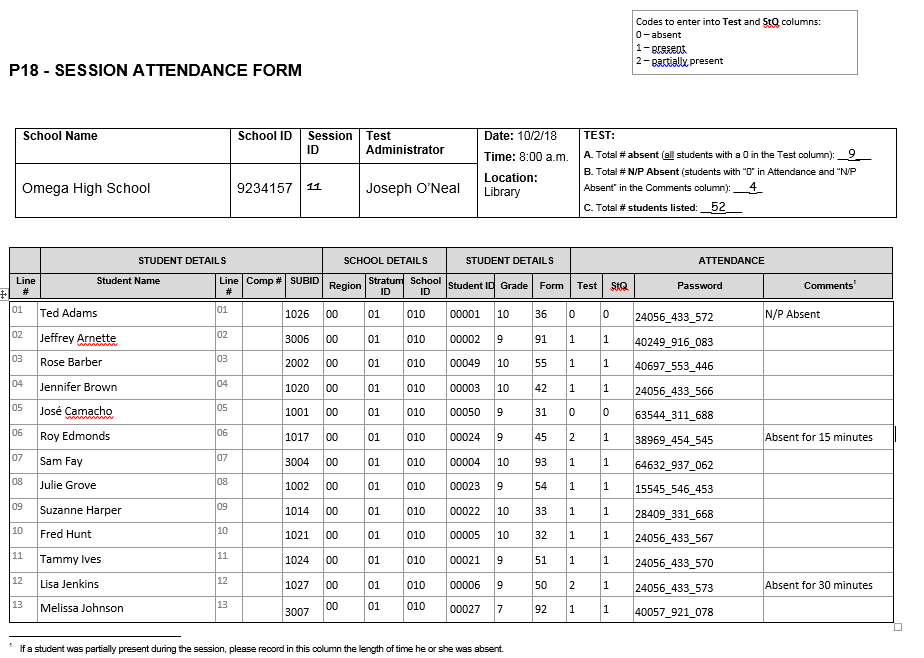
3.3.3. Students to be assessed in PISA
Only those students who do not have any codes placed in column N/P PISA can be assessed in PISA.
Important! Under no circumstances may a sampled student be replaced with another student who has not been selected to participate.
3.4. Organize and confirm assessment plans with school staff, students, parents, and test administrator
During the 2 to 3 weeks preceding the assessment, you will need to confirm these plans as follows:
confirm assessment plans with the test administrator;
confirm the date, time, and location for the assessment sessions and inform the test administrator, affected school staff, and students of any changes;
ensure that the assessment location(s) have been reserved;
ask participating students to bring a calculator to the assessment (PISA will provide a calculator to students who do not have one);
arrange for some books or magazines for students who finish the assessment ahead of time; and
arrange for school staff to assist during the assessment if necessary.
Hold Pre-assessment call and visit with the test administrator
The test administrator(s) assigned to your school will contact you 1 to 3 weeks before the assessment date to set up a pre-assessment visit at your school. During this visit, the test administrator will meet with you to discuss the following:
the date, time, and location of the assessment sessions;
any updates you have made to the Student Tracking Form regarding student demographic information, SEN codes, and exclusions;
details about accommodations for students with special education needs;
notification of school staff, students, and parents, including
verifying that the parents/guardians have been notified,
distributing Student Invitations and Student FAQs to sampled students, and
informing school staff of the date and time of the assessment;
details about school protocols, including
visitors arriving and checking in at the school,
students who arrive too late to the assessment and cannot be included,
students who become ill during the assessment and other urgent situations,
students who need to use the restroom or temporarily leave the session,
emergency drills or other activities that may interrupt the assessment session, and
dismissing students after the assessment;
time to meet with the test administrator the morning of the assessment; and
time to meet after the assessment to discuss any needed makeup sessions and review how the assessment went.
Hold Student meeting and presentation
During this visit the test administrator will also meet with the sampled students for about 20 minutes to show them a brief presentation and answer any questions. The meeting is designed to both inform and motivate students to participate and do their best. This is an important part of the PISA assessment.
3.5. Distribute School Questionnaire Logon Form to appropriate person at your school
The School Questionnaire should be completed online by the school principal or by someone to whom he or she delegates the task. The School Questionnaire provides valuable information about school policies and characteristics. It is important that these be completed in every school. To facilitate this task, appendix B provides nine questions that require looking up statistical information from your school that will be asked in the School Questionnaire (e.g., counts of student enrollment, staff counts, and percentage of students eligible for the National School Lunch Program).
Answers to these questions can be collected in advance to expedite completing the School Questionnaire. As mentioned in section 3.1, you will be notified by email when your school’s materials are available for download from the MyPISA website (www.MyPISA.US). This includes the School Questionnaire Logon Form. Print this form and distribute it to the principal or his/her designee.
3.6. Distribute Teacher Questionnaire Logon Forms to sampled teachers
Teacher Questionnaires should be completed only by teachers sampled to participate in PISA and listed on the Teacher Tracking Form. The Teacher Questionnaires provide valuable information about teaching experiences, educational backgrounds, and teaching methods. It is important that these be completed in every school.
The Teacher Questionnaire Logon Form and Teacher Tracking Form will be available when the rest of your school’s materials are ready for download from the MyPISA website (www.MyPISA.us). Print the Teacher Questionnaire Logon Forms and distribute them to the teacher whose name appears on the form. The Teacher Tracking Form may be updated online as described in section 3.7 below.
3.7. Confirm School and Teacher Questionnaire completion
Please confirm that the School Questionnaire and Teacher Questionnaires have been completed and, if necessary, remind the appropriate person to complete the questionnaire. The PISA test administrator will review with you which teachers have not started the questionnaire. You can update teacher status and monitor completion of the questionnaire by viewing the teacher tracking information in the “Provide School Information” section of the MyPISA website.
Column N/P on the Teacher Tracking Form is used to record sampled teachers who cannot (or who have informed you they will not) participate in PISA. The intention of PISA is to be as inclusive as possible. However, some teachers are not eligible or willing to participate for various reasons, including refusing to complete the questionnaire. These reasons for non-participation should be recorded in this column of the Teacher Tracking Form.
Teachers may inform you of their unwillingness to participate at different points in the process (e.g., when first informed or after reviewing the questionnaire contents). Enter a refusal code in the N/P column any time a teacher informs you he or she will not participate. Since email reminders are sent directly to the teachers, make sure to also record the N/P information online so they will stop receiving reminders.
All codes to be used in column N/P for non-participants are summarized in exhibit 3.8. If in doubt about which code to use, leave that column blank and insert a brief note in the Comments column.
Exhibit 3.8. Codes for teacher non-participants
-
Reason for non-participation
Code
Refusal (the teacher informs you that he or she will not complete the questionnaire at any time)
2
Technical difficulties in completing Teacher Questionnaire
4
Left school
5
Otherwise ineligible (e.g., not in target population)
7
Code 2 – Teacher refuses to participate in PISA
A small number of teachers may refuse to participate in PISA. If you have received such notification from a teacher, record a code “2” for this teacher in column N/P.
Code 4 – Teacher encounters technical difficulties while completing Teacher Questionnaire
If a teacher has let you know that he/she has experienced technical difficulties in completing the Teacher Questionnaire, record a code “4” for this teacher in column N/P. Refer the teacher to the PISA help desk at 1-888-638-2597 for technical assistance.
Codes 5 – Teacher left school
If a teacher has left the school, record a code “5” for this teacher in column N/P.
Code 7 – Teacher is otherwise ineligible for PISA
If a teacher is not eligible to teach grade 10 students, he or she is not eligible to participate in PISA. Record a code “7” for this teacher in column N/P.
If a teacher does not fit the definition of a teacher, he or she is not eligible to participate in PISA. Record a code “7” for this teacher in column N/P. A teacher is one whose primary or major activity in the school is student instruction, involving the delivery of lessons to students. Teachers may work with students as a whole class in a classroom, in small groups in a resource room, or one-to-one inside or outside regular classrooms.
Examples of using teacher non-participant codes
Refer to exhibit 3.9, in which the following example codes have been applied:
Kenneth Dowling is ineligible to participate in PISA because he’s not eligible to teach the 10th grade. Therefore, he is coded as “7” in column N/P.
Sherry Ingemann is no longer teaching at the school. Therefore, she is coded as “5” in column N/P.
Russel Joslin refused to complete the Teacher Questionnaire. Therefore, he is coded as “2” in column N/P.
Melissa Valdez was unable to complete the Teacher Questionnaire due to technical difficulties. Therefore, she is coded as “4” in column N/P.
Important! Under no circumstances may a sampled teacher be replaced with any other teacher who was not selected to participate.
Exhibit 3.9. Teacher Tracking Form
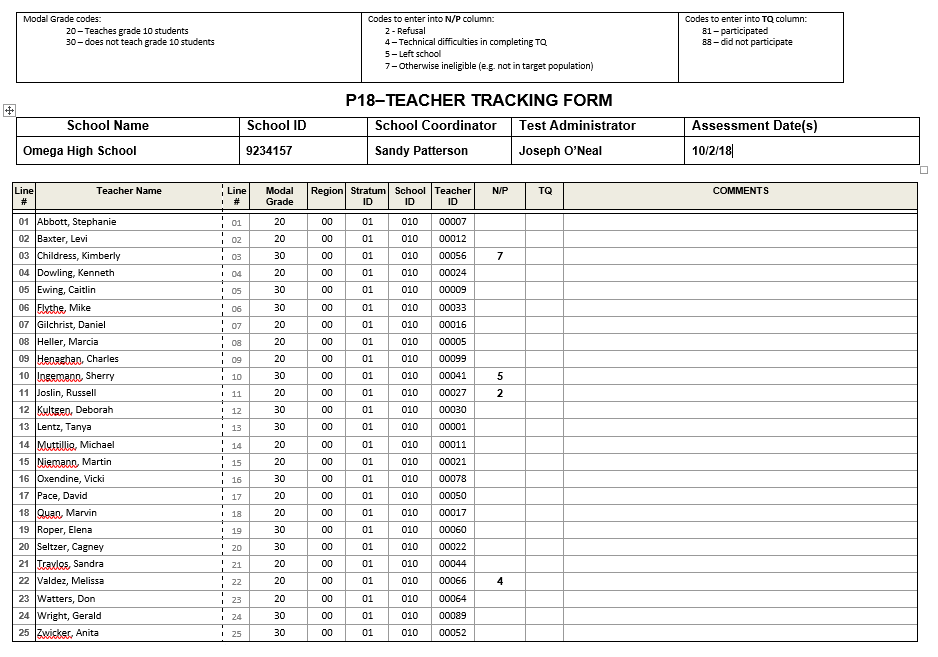
CHAPTER 4: ASSESSMENT DAY
4.1. Meet with the test administrator before the assessment
The test administrator(s) will arrive 1 to 1½ hours before the assessment is scheduled to begin and will need to meet with you immediately to review assessment day logistics. Give the test administrator(s) the updated Student Tracking Form and discuss any changes to the Student Tracking Form. Make sure that you have updated the forms before the meeting. Do not record anything in the “N/P PISA” column for students who are absent on assessment day but are eligible to participate in the assessment. The test administrator will record student attendance on the Session Attendance Form after the assessment.
4.2. Arrange for support staff to be present throughout each session (if possible)
If it is not possible for you or other school staff to be present throughout the assessment, you or they should be present at least at the beginning of the assessment session. This will help set the tone of the session and demonstrate the importance of the assessment.
School staff, however, are not permitted to administer the assessment or respond to students’ questions related to test or Student Questionnaire items. Only the test administrator should respond to such questions.
Maintaining Security and Confidentiality of Assessment Materials Because PISA materials will be used in the future, their security is very important and must be maintained at all times.
|
4.3. Meet with the test administrator after the assessment
After the assessment is completed, the test administrator will need to meet with you briefly to discuss the session. He or she will also need to make copies of the assessment forms and give these to you to store should there be any questions about the assessment or if the original documents are lost or damaged.
4.4. Arrange for a makeup session, if needed
PISA requires a high level of participation of the sampled students. The test administrator will calculate the absence rate after the assessment and inform you if a make-up session is needed.
If a make-up session needs to be arranged, please select a mutually agreed upon date and time that will maximize the number of students attending the session. It is preferred that makeup session(s) be held in the same week as the assessment, if possible.
Note on Makeup Sessions Only one makeup assessment is held for a session. Please make every attempt to ensure that absent students attend the makeup session. |
4.5. Store PISA forms
After the assessment, the test administrator will give you an envelope with copies of the completed forms. We ask that you store this envelope securely until the end of the school year.
Your help with PISA is very important to its success in ensuring that the data collected for United States is of the highest quality.
The U.S. PISA and the International Project Team appreciate your time and effort.
Thank you!
|
Appendix A
PISA Forms
Student List and E-File format

Teacher List and E-File format
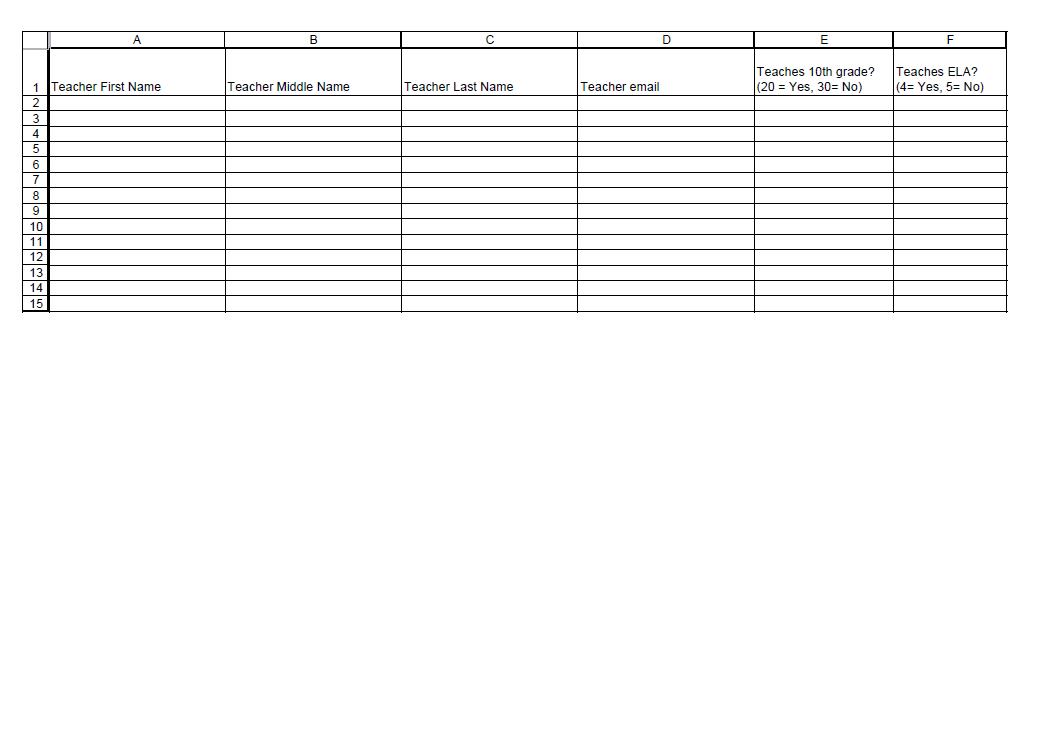
![]()


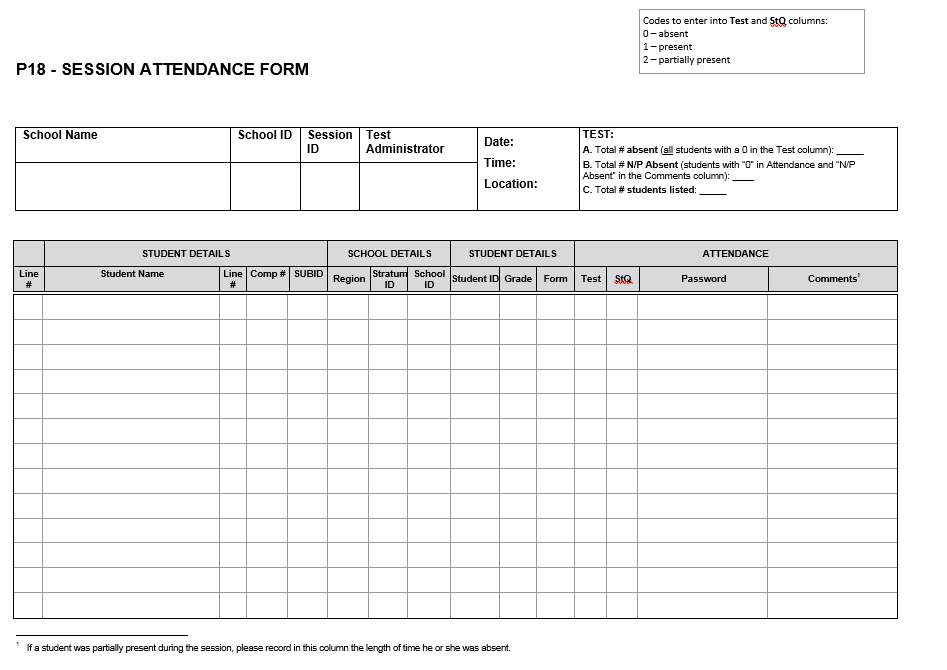
PISA 2018 – Teacher Questionnaire Invitation
Dear «teacherFirstLast»:
Your school is one of 200 schools across the United States that has accepted an invitation from NCES to participate in PISA 2018. You’ve been sampled to participate by completing an online teacher questionnaire about the courses you teach, your teacher training and education, and your views on teaching. If you have any questions about how you were selected for this survey, please contact your PISA school coordinator, «SC_FNAME» «SC_LNAME».
The questionnaire takes about 30 minutes to complete. This information, combined with responses from school principals and students, helps to provide a more complete understanding of student achievement and contexts for learning.
You will receive $25 for completing the questionnaire, if allowed by your school’s policy. Use the provided link and unique account information below to complete your questionnaire.

Link:
https://portal.mypisa.us/TeacherQuestionnaire
Username:
«KQID»
Password:
«TEACHPWD»
PISA is conducted in the United States by the National Center for Education Statistics (NCES), within the U.S. Department of Education, and is administered by Westat, a firm in Rockville, Maryland. The U.S. Office of Management and Budget has approved the data collection under OMB #1850-0755.
If you have any questions, please do not hesitate to call 1-888-638-2597 or send an email to [email protected]
You may also get more information about this study by visiting the PISA website at http://nces.ed.gov/surveys/pisa
Thank you for your time and for supporting this important international study.
Sincerely,
The PISA USA Team
The National Center for Education Statistics (NCES), within the U.S. Department of Education, conducts the Program for International Student Assessment (PISA) in the United States as authorized by the Education Sciences Reform Act of 2002 (ESRA 2002, 20 U.S.C. §9543). All of the information you provide may be used only for statistical purposes and may not be disclosed, or used, in identifiable form for any other purpose except as required by law (20 U.S.C. §9573 and 6 U.S.C. §151).
PISA2018– Principal Questionnaire Invitation
Dear «principal»:
The United States is participating in an important international study: the Program for International Student Assessment (PISA). PISA is the largest international assessment of education in the world, with more than 80 countries and education systems participating in each cycle. It provides comparative information on the performance of U.S. 15-year-old students in science, reading, and mathematics with 15-year-old students in other countries.
Your school is one of 200 schools across the United States that are taking part in PISA 2018. Part of the study is an online school questionnaire that the principals of the selected schools complete. The questionnaire takes about 45 minutes to complete. This information, combined with responses from teachers and students, helps to provide a more complete understanding of student achievement and contexts for learning.
Use the provided link and unique account information below to complete your questionnaire.
 Link:
https://portal.mypisa.us/SchoolQuestionnaire
Link:
https://portal.mypisa.us/SchoolQuestionnaire
Username:840-00-99-001
Password:
1234567
PISA is conducted in the United States by the National Center for Education Statistics (NCES), within the U.S. Department of Education, and is administered by Westat, a firm in Rockville, Maryland. The U.S. Office of Management and Budget has approved the data collection under OMB #1850-0755.
If you have any questions, please do not hesitate to call 1-888-638-2597 or send an email to [email protected]
You may also get more information about this study by visiting the PISA website at http://nces.ed.gov/surveys/pisa
Thank you for your time and for supporting this important international study.
Sincerely,
The PISA USA Team
The National Center for Education Statistics (NCES), within the U.S. Department of Education, conducts the Program for International Student Assessment (PISA) in the United States as authorized by the Education Sciences Reform Act of 2002 (ESRA 2002, 20 U.S.C. §9543). All of the information you provide may be used only for statistical purposes and may not be disclosed, or used, in identifiable form for any other purpose except as required by law (20 U.S.C. §9573 and 6 U.S.C. §151).
Appendix B
School Questionnaire Questions
preparation for the pisa 2018 school questionnaire
This document contains nine questions on the School Questionnaire that involve statistical information from your school.
Answers to these questions can be collected in advance by the school principal, or other staff involved in filling out the School Questionnaire.
The information collected in this document will then be entered into the electronic questionnaire by the principal/the person filling out the questionnaire. You will find the question number in the lower left corner of the electronic questionnaire screen.
SC016 |
About what percentage of your total funding for a typical school year comes from the following sources? |
|
|
(Please enter a number for each response. Enter “0” (zero) if there are none.) |
|
|
|
% |
SC016Q01TA |
Government (includes, local, , state and federal) |
___________ |
SC016Q02TA |
Tuition, student fees or school charges paid by parents |
___________ |
SC016Q03TA |
Benefactors, donations, bequests, sponsorships, parent fundraising |
___________ |
SC016Q04TA |
Other |
___________ |
|
Total |
100% |
SC002 |
As of February 1, 2018, what was the total school enrollment (number of students)? |
|
|
(Please enter a number for each response. Enter “0” (zero) if there are none.) |
|
SC002Q01TA |
Number of boys: |
____________ |
SC002Q02TA |
Number of girls: |
____________ |
Please estimate the percentage of students in 10th grade at your school who have the following characteristics. |
||
|
(Please consider that students may fall into multiple categories.) (Please write the appropriate percentage in each line.) |
|
SC048Q01NA |
Students whose heritage language is different from English |
_________ |
SC048Q02NA |
Students with special needs |
_________ |
SC048Q03NA |
Students from socioeconomically disadvantaged homes |
_________ |
SC004 |
The goal of the following set of questions is to gather information about the student-computer ratio for students in the 10th grade at your school. |
|||||
|
(Please enter a number for each response. Enter “0” (zero) if there are none.) |
|||||
|
|
Number |
||||
SC004Q01TA |
At your school, what is the total number of students in the 10th grade |
____________ |
||||
SC004Q02TA |
Approximately, how many computers are available for these students for educational purposes? |
____________ |
||||
SC004Q03TA |
Approximately, how many of these computers are connected to the Internet? |
____________ |
||||
SC004Q04NA |
Approximately, how many of these computers are portable (e.g., laptop, tablet)? |
____________ |
||||
SC004Q05NA |
Approximately how many interactive whiteboards are available in the school altogether? |
____________ |
||||
SC004Q06NA |
Approximately how many data projectors are available in the school altogether? |
____________ |
||||
SC004Q07NA |
Approximately how many computers with Internet connection are available for teachers in your school? |
____________ |
||||
|
|
|
||||
SC018 |
How many of the following teachers are on the staff of your school? |
|||||
|
Include both full-time and part-time teachers. A full-time teacher is employed at least 90% of the time as a teacher for the full school year. All other teachers should be considered part-time. Regarding the qualification level, please refer only to the teacher’s highest qualification level. |
|||||
|
(Please enter a number in each space provided. Enter “0” (zero) if there are none.) |
|||||
|
|
Full-time |
Part-time |
|||
SC018Q01TA |
Teachers in TOTAL |
__________01 |
__________02 |
|||
SC018Q02TA |
Teachers fully certified by the state in their main assignment field |
__________01 |
__________02 |
|||
SC018Q05NA |
Teachers with a bachelor’s degree qualification |
__________01 |
__________02 |
|||
SC018Q06NA |
Teachers with a master’s degree qualification |
__________01 |
__________02 |
|||
SC018Q07NA |
Teachers with a doctoral degree or professional degree (e.g., J.D. or M.D.) |
__________01 |
__________02 |
|||
SC025 |
During the last three months, what percentage of teaching staff in your school has attended a program of professional development? |
|||||
|
A program of professional development here is a formal program designed to enhance teaching skills or pedagogical practices. It may or may not lead to a recognized qualification. The program must last for at least one day in total and have a focus on teaching and education. (Please move the slider to the appropriate percentage. If none of your teachers participated in any professional development activities select “0” (zero).) |
|||||
SC025Q01NA |
Of all teaching staff at your school |
______________ % 01 |
||||
SC003 SC003Q01TA |
What is the average size of English/Language arts classes in 10th grade in your school? |
|
|
(Please select one response.) |
|
|
15 students or fewer |
1 |
|
16-20 students |
2 |
|
21-25 students |
3 |
|
26-30 students |
4 |
|
31-35 students |
5 |
|
36-40 students |
6 |
|
41-45 students |
7 |
|
46-50 students |
8 |
|
More than 50 students |
9 |
SC164 |
In the last full academic year, what proportion of students in your school’s final grade left school without a diploma or alternative credential (e.g., a GED)? |
|
(A diploma or alternative certificate allows students to enter post-school destinations such as university, technical, further, or vocational education, apprenticeships or employment.) |
|
(Please move the slider to the appropriate percentage. Select “0” (zero) if no students left without such a certificate.) |
SC164Q01HA |
_________________% 01 |
Thank you for collecting this information. Please keep this document and enter the respective numbers into the online school questionnaire. You will receive an email from [email protected] when the online questionnaire is available.
Appendix C
PISA 2018 E-Filing Instructions
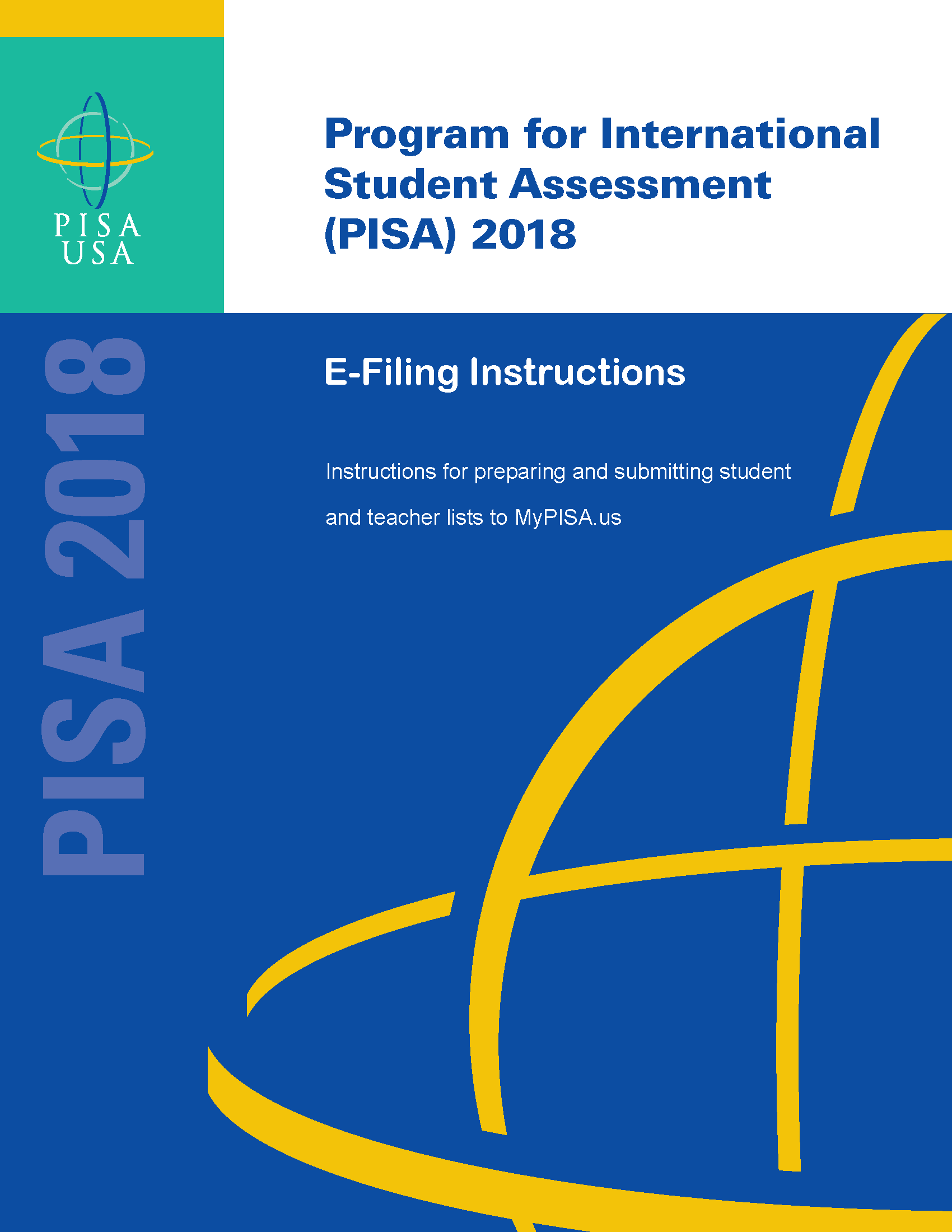
1. PREPARE ELECTRONIC STUDENT FILE (E-FILE)........................................................ 1
Steps for preparing an Electronic Student File (E-File)........................................................................ 1
Step 1: Identify ALL students at your school who meet the eligibility criteria...................................... 1
Step 2: List each of the eligible students................................................................................................ 1
Submitting your Electronic Student File............................................................................................ 2
Student E-File Step 1: Upload your file..................................................................................................... 3
Student E-File Step 2: Identify your column contents.............................................................................. 4
Student E-File Step 3: Match your values to PISA codes.......................................................................... 5
Student E-File Step 4: Verify your E-File............................................................................................... 6
E-File Complete!.................................................................................................................................... 7
2. PREPARE ELECTRONIC TEACHER FILE (E-FILE) ....................................................... 8
Steps for preparing an Electronic Teacher File (E-File)...................................................................... 8
Step 1: Identify ALL teachers at your school who are eligible to teach 10th grade.................................. 8
Step 2: List each of the eligible teachers................................................................................................. 8
Submitting your Electronic Teacher File............................................................................................ 9
Teacher E-File Step 1: Upload your file................................................................................................. 10
Teacher E-File Step 2: Identify your column contents................................................................................ 11
Teacher E-File Step 3: Match your values to PISA codes............................................................................ 12
Teacher E-File Step 4: Verify your E-File.................................................................................................... 13
E-File Complete!................................................................................................................................... 14
The National Center for Education Statistics (NCES), within the U.S. Department of Education, conducts the Program for International Student Assessment (PISA) in the United States as authorized by the Education Sciences Reform Act of 2002 (ESRA 2002, 20 U.S.C. §9543). All of the information provided by school staff and students may be used only for statistical purposes and may not be disclosed, or used, in identifiable form for any other purpose except as required by law (20 U.S.C. §9573 and 6 U.S.C. §151).
According to the Paperwork Reduction Act of 1995, no persons are required to respond to a collection of information unless such collection displays a valid OMB control number. The valid OMB control number for this voluntary survey is 1850-0755. The time required to complete this information collection is estimated to average no more than 60 minutes per response, including the time to review instructions, search existing data resources, gather the data needed, and complete and review this information collection. If you have any comments concerning the accuracy of the time estimate, suggestions for improving this information collection, or any comments or concerns regarding the status of your individual submission of this information collection, please write to: Program for International Student Assessment (PISA), National Center for Education Statistics (NCES), Potomac Center Plaza, 550 12th Street, SW, Washington, DC 20202.
OMB No. 1850-0755, Approval Expires xx/xx/2021.
Preparing the PISA Electronic Student File (E-File)
Step 1: Identify ALL students at your school who meet the eligibility criteria
Criteria for PISA student eligibility are:
Enrolled in Grade 7 or higher, AND
Born on or between July 1, 2002, and June 30, 2003.
PISA needs accurate information about all students at your school who meet the above criteria for student eligibility. Include all eligible students, even those who typically may be excluded from other testing programs, such as students with IEPs or 504 plans (SD), English language learners (ELL), or students with limited English proficiency (LEP). If selected, their participation will be determined with the Test Administrator. Do not include on your list students who are known to be withdrawn. All other eligible students must be added to your list of students.
Step 2: List each of the eligible students along with their demographic information (see Figure 1 below for an example)
Using the Excel template provided on the MyPISA.us website (www.MyPISA.us), list students in your school who are eligible for PISA along with their demographic information.
Student first name
Student middle name (not required)
Student last name
Grade in school (Grade 7 – Grade 12 as applicable)
Month of birth (M or MM; must be submitted in numeric format, not text (7 or 07 for July; 6 or 06 for June))
Year of birth (YYYY: 2002, 2003)
Sex (numeric or text (1=Female, 2=Male))
Figure 1: Example of Electronic Student File
Student First Name |
Student Last Name |
Grade |
Month of Birth |
Year of Birth |
Sex |
Ted |
Brooks |
10 |
12 |
2002 |
2 |
Jeffrey |
Jenkins |
9 |
11 |
2002 |
2 |
Rose |
Matthews |
10 |
12 |
2002 |
1 |
Jennifer |
Trader |
12 |
5 |
2003 |
1 |
Jose’ |
Rodriguez |
10 |
5 |
2003 |
2 |
Roy |
Zastrow |
9 |
11 |
2002 |
2 |
Sam |
Walker |
10 |
7 |
2002 |
2 |
Submitting the PISA Electronic Student File (E-File)
Step 1: Upload file.
After you have created and saved your student E-File, proceed to www.MyPISA.us. Once you have logged in, click the ‘Submit Student List’ link on the left side of the page (Box 1 below). Then click the “Browse” button to locate your file (box 2 below). Once you’ve located the file and clicked ok, click “Upload” (box 3 below).
Exhibit 1. Submit Student List – initial screen – How to Submit Your Student List


Step 2: Map Columns. The column headings in your file are shown in rows on the left side of the page. In each row, for each heading on the left, click on the down arrow next to the words in the table that read "Column Contains..." on the right. If there is no appropriate description in the drop-down list for your column heading, select N/A.
Exhibit 2. Submit Student List – Identify Your Columns




Step 3: Match Values to PISA Codes. The next step is matching the values on your file to PISA codes. The values in your columns will again be displayed on the left. Select the corresponding PISA code from the drop down list on the right (see exhibit 3). If there is no appropriate description in the drop-down list for your column heading, select N/A. When you are finished matching your values to PISA codes, click next. Repeat the above instructions to assign male/female codes and click next (see exhibit 4).
Exhibit 3. Submit Student List - Match your Values to PISA Codes (grade mapping)

Exhibit 4. Submit Student List - Match your Values to PISA Codes
(sex mapping)
Step 4: Verify your E-file. The final step is to verify that the information is correct and submit your file. Check that the distribution of students by grade and sex match the total number of students you submitted. Indicate whether this information is correct and click “Submit.” If the information is incorrect click “Incorrect” and then click on the “Submit Student List” link on the left side of the screen. This will save your progress and exit the current e-file. You can access this file again or upload a new corrected file and start over using the same file upload process described in Step 1.
Exhibit 5. Submit Student List –Verify your E-file

Online Student Data Checks - After you click “Submit” a number of online data validation checks are performed by our programs. These checks include checking the number of listed students against statistical estimates, making sure there is an accurate distribution of students by grade based on statistical estimates, checking that all students included are birth-year eligible (born on or between July 1, 2002 and June 30, 2003), and checking for any missing data. If the data fail these online checks, you will be presented with a screen that describes the issue, the location of the row(s) in your file that contains the errant data, and will need to correct the file and upload a new version. Exhibit 6 (below) provides an example of a file with missing data. Notice that the affected row is provided for each instance where the check failed. This is designed to help you efficiently locate and ameliorate any issues. Exhibit 7 provides an example of a file where ineligible students were included.
Exhibit 6. Online data check – missing data

Exhibit 7. Online data check – ineligible birth year

Along with the file validation checks, the total number of students is compared to the statistical estimate of eligible students. If there is a 10% or more difference in enrollment, which is typical for most every school, international standards for data collection require that we ask school coordinators for a possible reason. Typical reasons include redistricting, the schools being located within a growing or shrinking community, or near an army base. Exhibit 8 provides a screen shot of the enrollment verification check and comment box. This check does not prohibit you from completing your e-file. Simply provide a comment in the box and continue.
Exhibit 8. Online data check – enrollment verification – Verify Your E-File

If at any time you realize that every eligible student was not listed, you can exit e-filing, correct the file, and upload a new one. If you have any questions or would like to talk with someone about e-filing, please reach out to the PISA help desk by phone between 8 a.m. and 8 p.m. Eastern Time at 1-888-638-2597 or email [email protected].
Note that neither students nor teachers can be sampled until your student and teacher lists are both submitted.
Preparing the PISA Electronic Teacher File (E-File)
Step 1: Identify ALL teachers at your school who are eligible to teach 10th grade students whether or not they currently do.
Criteria for PISA teacher eligibility are:
All teachers qualified to teach 10th grade students whether or not they currently do, regardless of content specialty.
Teacher-aides, assistants, and other school staff who are not certified to autonomously teach 10th grade students are not eligible.
PISA needs accurate information about all teachers at your school who are eligible to teach 10th grade students. In addition to listing all teachers who are eligible to teach 10th grade students, PISA needs you to identify which ones are currently teaching 10th grade students and which ones are currently teaching English/language arts.
Teachers who currently teach any 10th grade students should be indicated as “Yes, teaches 10th grade” (see exhibit 10 below).
Teachers who currently teach any level of English/language arts (e.g., writing, composition, language and literature, AP English) should be indicated as “Yes, teaches ELA.”
Step 2: List each of the eligible teachers.
Using the electronic listing form template provided on the MyPISA.us website (www.MyPISA.us), list teachers in your school who are eligible for PISA along with their other necessary information.
Teacher first name
Teacher middle name (not required)
Teacher last name
Whether or not they currently teach 10th grade (20 indicates yes, they teach 10th grade; 30 indicates they do not)
Whether or not they currently teach an English/language arts course (4 indicates yes, they currently teach English/language arts; 5 indicates they do not)
Email address (this is needed to deliver their log in credentials electronically)
Exhibit 10. Example Teacher listing Form

Submitting the PISA Electronic Teacher File (E-File)
Step 1: Upload file.
After you have created and saved your teacher E-File, proceed to www.MyPISA.us. Once you have logged in, click the ‘Submit Teacher List’ link on the left side of the page (box 1 below) underneath the “Submit Student Link.” Then click the “Browse” button to locate your file (box 2 below). Once you’ve located the file and clicked ok, click “Upload” (box 3 below).
Exhibit 11. Submit Teacher List – initial screen – How to Submit Your Teacher List
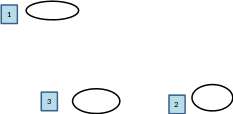

Step 2: Map Columns. The column headings in your file are shown in rows on the left side of the page. In each row, for each heading on the left, click on the down arrow next to the words in the table that read "Column Contains..." on the right. If there is no appropriate description in the drop-down list for your column heading, select N/A.



Exhibit 12. Submit Teacher List – Identify Your Columns

Step 3: Match Values to PISA Codes. The next step is matching the values on your file to PISA codes. The values in your column will again be displayed on the left. Select the corresponding PISA code from the drop down list (see exhibit 13). If there is no appropriate description in the drop-down list for your column heading, select N/A. When you are finished matching your values to PISA codes, click next. Repeat the above instructions to assign ELA codes and click next (see exhibit 14).
Exhibit 13. Submit Teacher List - Match your Values to PISA Codes (Teaches grade 10? mapping)

Exhibit 14. Submit Teacher List - Match your Values to PISA Codes (ELA mapping)

Step 4: Verify your E-file. The final step is to verify that the information is correct and submit your file. Check that the distribution of teachers by “ELA” status and “Teaches grade 10?” status match the total number of teachers you submitted. Indicate whether this information is correct and click “Submit.” If the information is incorrect click “Incorrect” and then click on the “Submit Teacher List” link on the left side of the screen. This will save your progress and exit the current e-file. You can access this file again or upload a new corrected file and start over using the same file upload process described in Step 1.
Exhibit 15. Submit Teacher List –Verify your E-File

Online Teacher Data Checks. Similar to the student data, validation checks are run on the teacher data and the screens are almost identical to the student data check screens. Refer to Exhibits 6 and 7 for pictures of how the checks are displayed on the screen. If there is a difference of 20% or more between the number of teachers provided and the number of teachers expected, international standards for data collection require that we ask school coordinators for a possible reason. Typical reasons include redistricting, the schools being located within a growing or shrinking community or near an army base, budgetary reasons, or school reorganization. Exhibit 15 (above) provides a screen shot of the teacher verification check and comment box. This check does not prohibit you from completing your e-file. Simply provide a comment in the box and continue by indicating that the information is correct and clicking “Submit.”
If at any time you realize that every eligible teacher was not listed, you can exit e-filing, correct the file, and upload a new one by clicking on the “Submit Teacher List” link and uploading a new file. If you have any questions or would like to talk with someone about e-filing, please reach out to the PISA help desk by phone between 8 a.m. and 8 p.m. Eastern Time at 1-888-638-2597 or email [email protected].
MyPISA project website for School Coordinators and schools
The following screens shots show the web content of MyPISA.us for schools and school coordinators. MyPISA.us is described in Part B of the main study package.
MyPISA.us – Home – Welcome to PISA
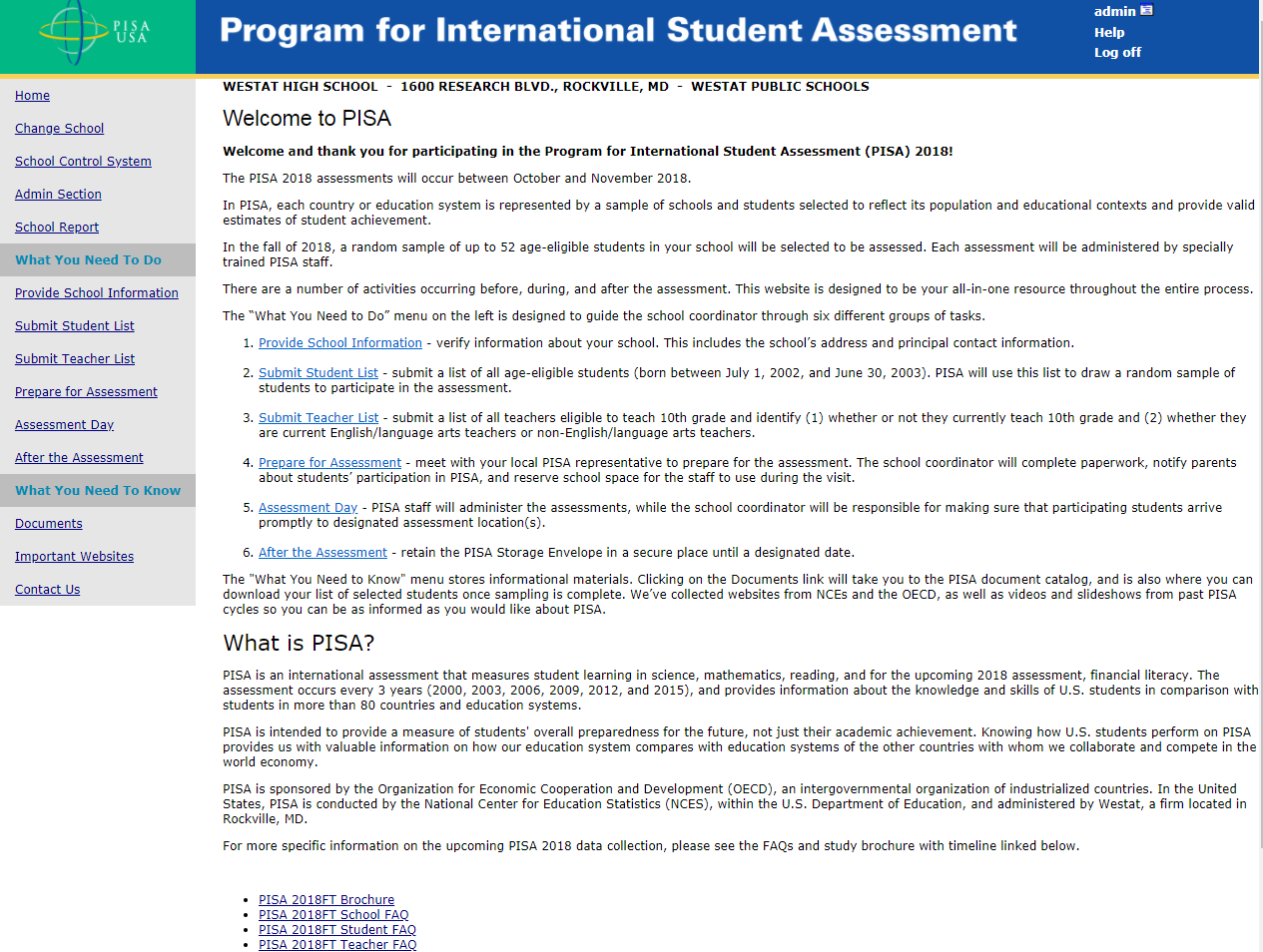
This screen is the Welcome page for the MyPISA.us site. It provides overview information about the survey and navigation to specific areas of the site.
MyPISA.us – Provide School Information




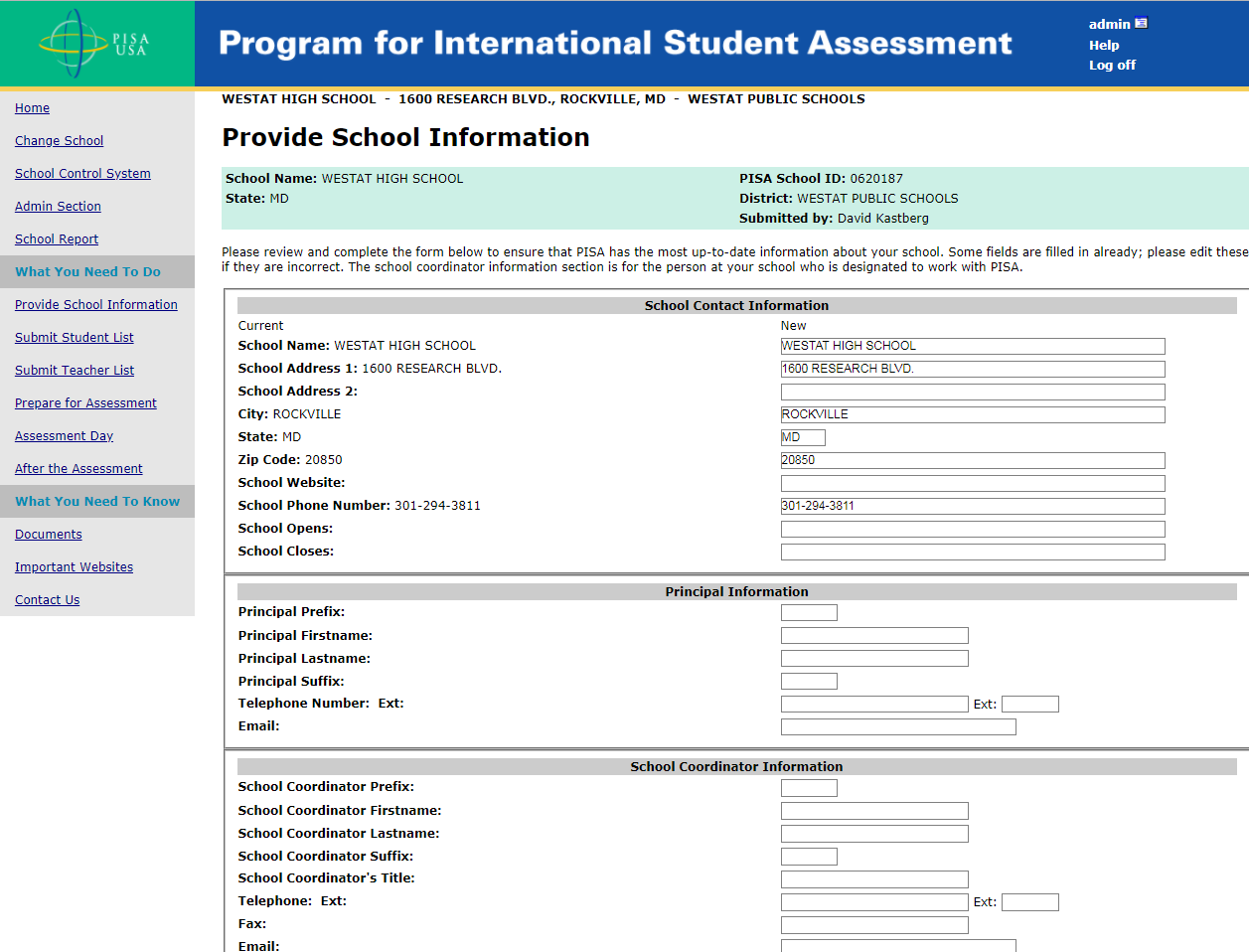
This screen provides information about the school. This information is already populated first from the sampling information and then updated by the NAEP State Coordinators or PISA Recruiters.
MyPISA.us – Submit Student List – How to Submit Your Student List
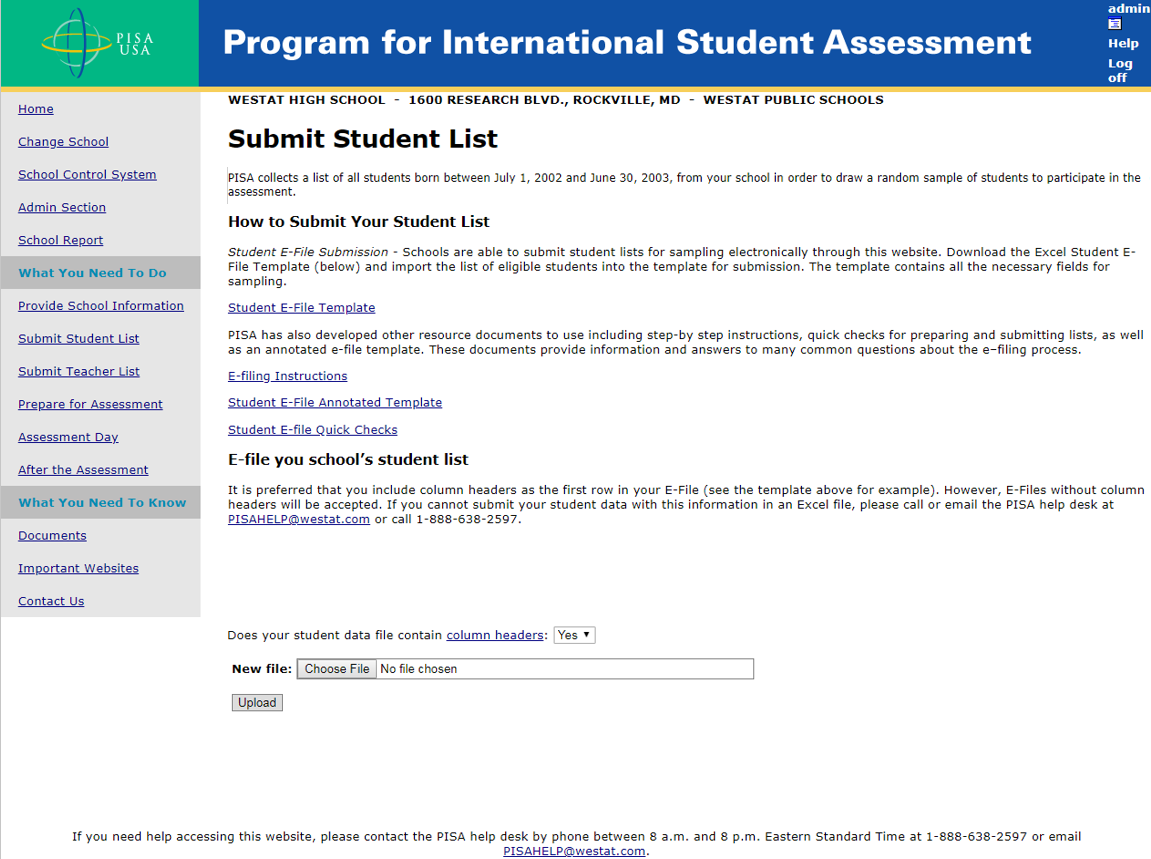
This screen provides the E-file instructions and template and is where the school coordinator will securely upload the completed student list.
The following statement will be added to the screen above to state the estimated time to complete and submit the student list.
According to the Paperwork Reduction Act of 1995, no persons are required to respond to a collection of information unless such collection displays a valid OMB control number. The valid OMB control number for this voluntary information collection is 1850-0755. The time required to complete this information collection is estimated to average 45 minutes per school coordinator, including the time to review instructions, gather the data needed, and complete and review the information collection. If you have any comments or concerns regarding the accuracy of the time estimate(s), suggestions for improving the form, or questions about the status of your individual submission of this form, write directly to: Program for International Student Assessment (PISA), National Center for Education Statistics (NCES), Potomac Center Plaza, 550 12th Street, SW, 4th floor, Washington, DC 20202.
MyPISA.us – Submit Teacher List – How to Submit Your Teacher List
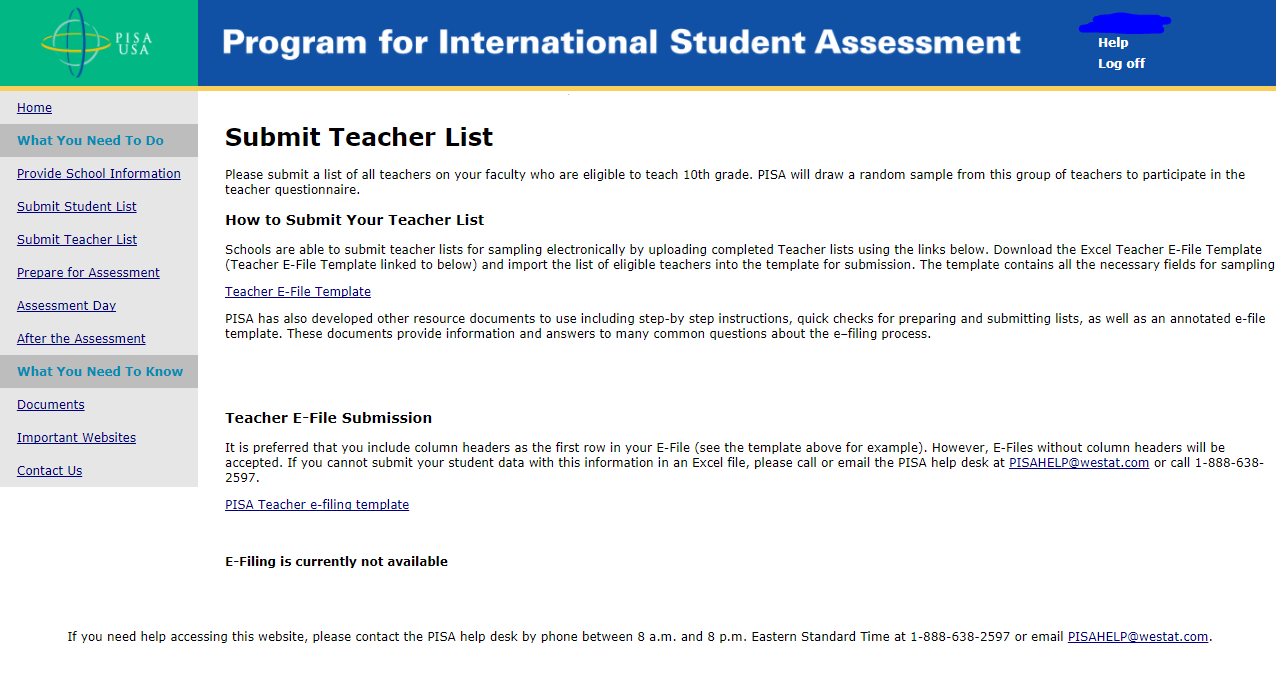
This screen provides the E-file instructions and template and is where the school coordinator will securely upload the completed teacher list.
The following statement will be added to the screen above to state the estimated time to complete and submit the teacher list.
According to the Paperwork Reduction Act of 1995, no persons are required to respond to a collection of information unless such collection displays a valid OMB control number. The valid OMB control number for this voluntary information collection is 1850-0755. The time required to complete this information collection is estimated to average 45 minutes per school coordinator, including the time to review instructions, gather the data needed, and complete and review the information collection. If you have any comments or concerns regarding the accuracy of the time estimate(s), suggestions for improving the form, or questions about the status of your individual submission of this form, write directly to: Program for International Student Assessment (PISA), National Center for Education Statistics (NCES), Potomac Center Plaza, 550 12th Street, SW, 4th floor, Washington, DC 20202.
MyPISA.us – Prepare for Assessment

This screen provides information and suggestions for preparing for the survey including discussing the survey with school staff, providing materials, and notifying teachers of their selection to participate.
MyPISA.us –Assessment Day
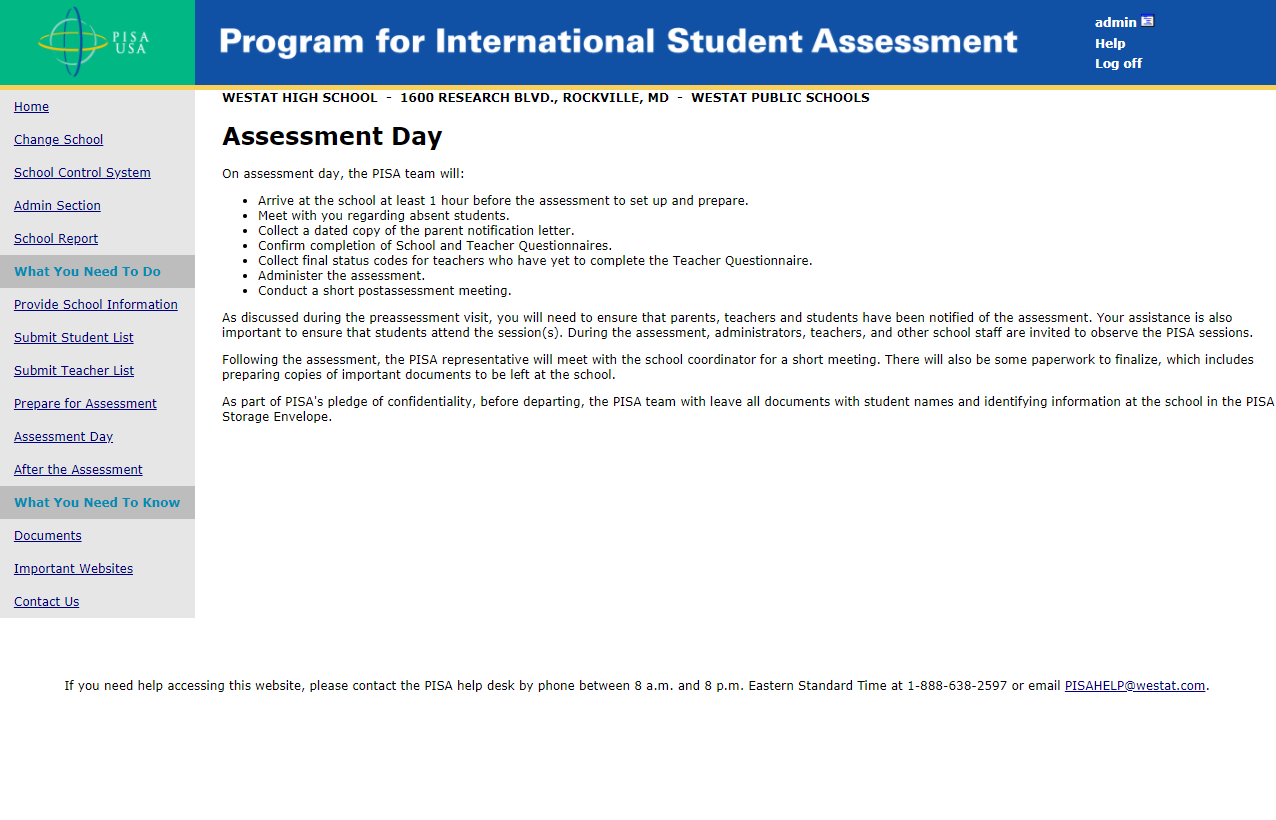
MyPISA.us – After the Assessment
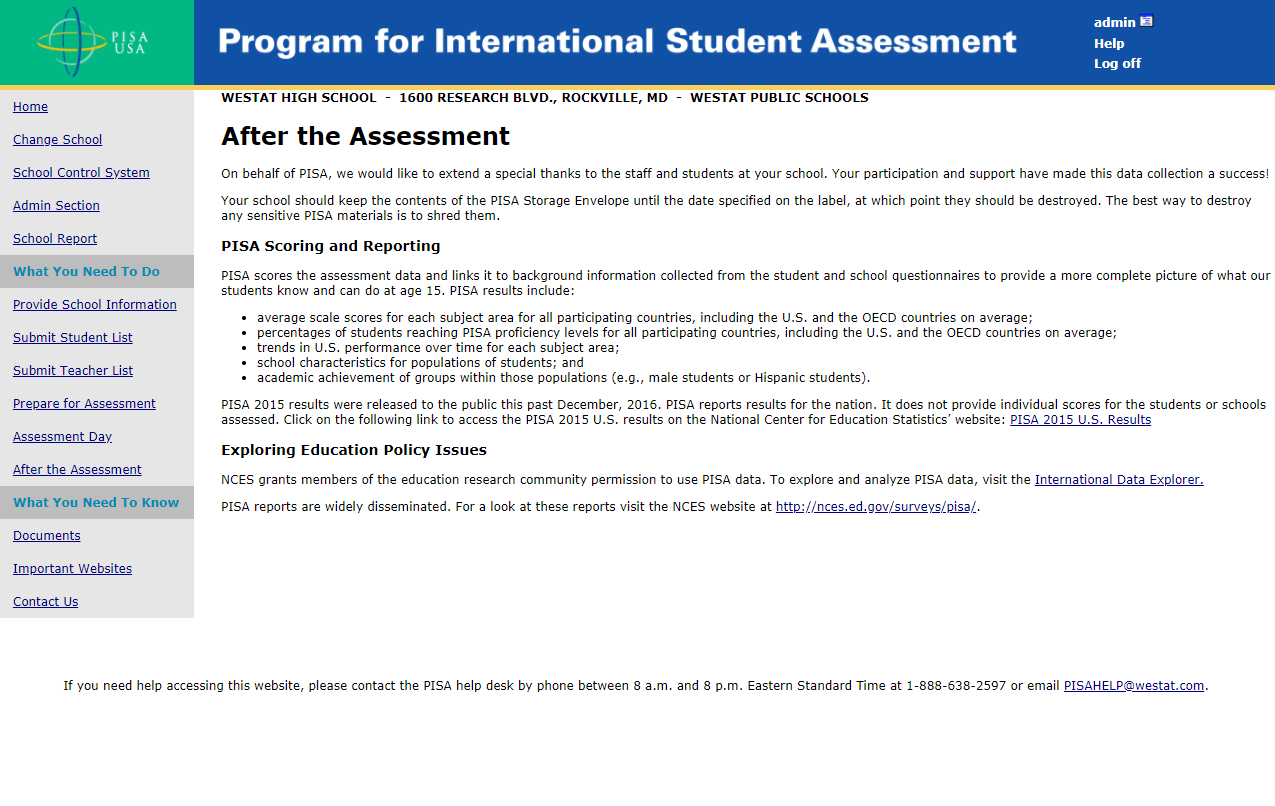
This screen provides information about post-assessment activities such as scoring of assessment data and reporting plans.
MyPISA.us – Documents
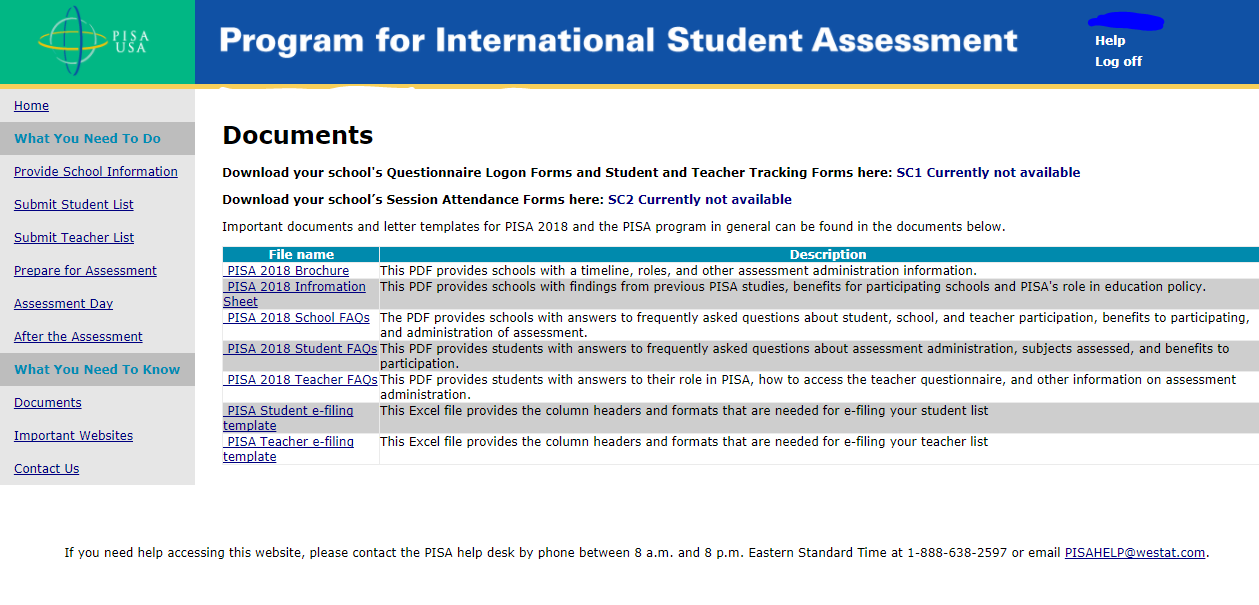
This screen provides links to documents for PISA.
MyPISA.us – Important Websites
`
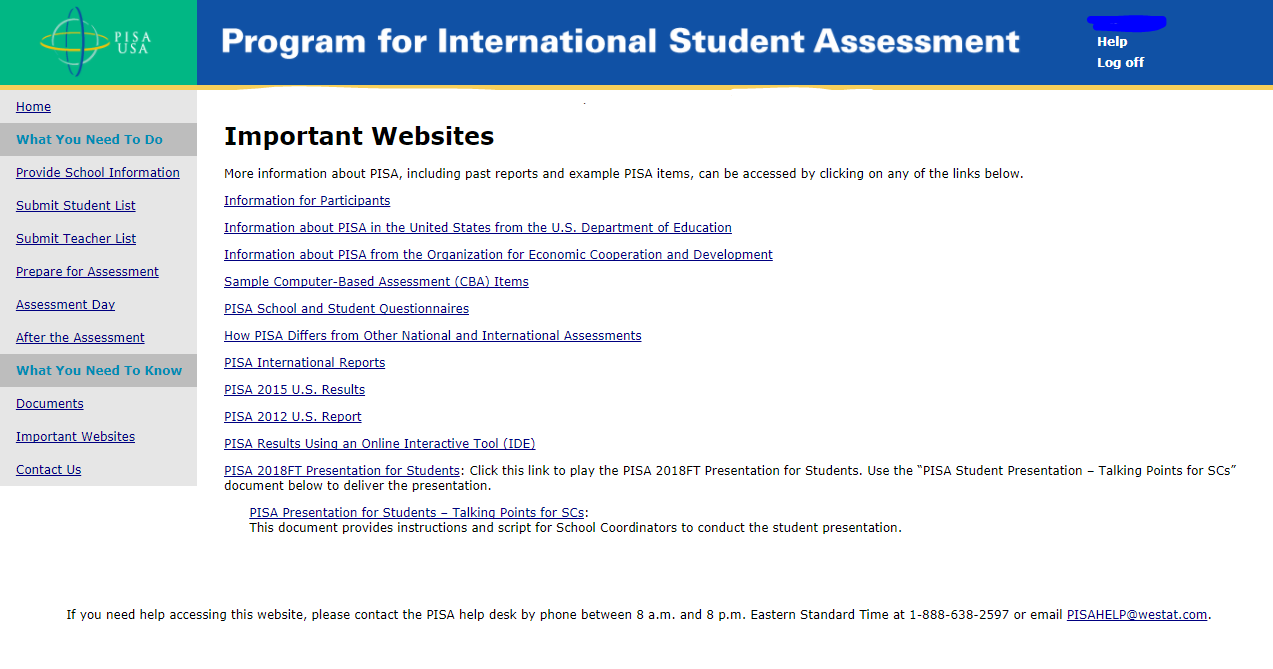
MyPISA.us – Contact Us
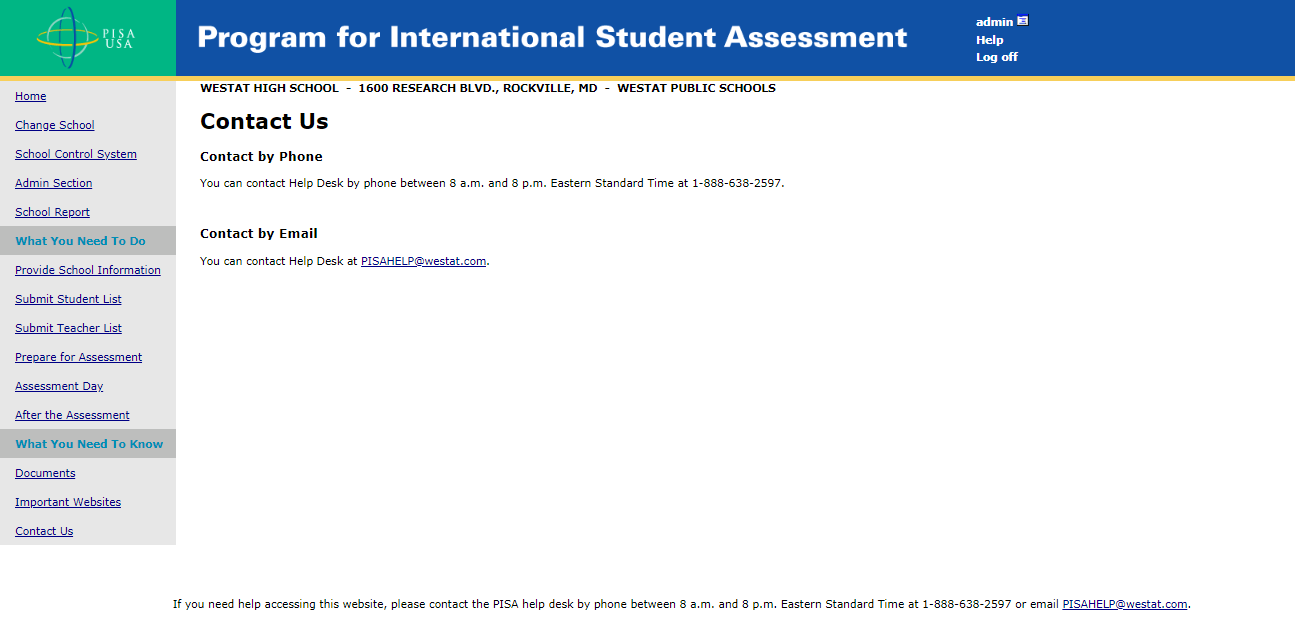
PISA 2018 Student Presentation Video
This presentation video is designed to both inform students of the details and importance of the study and to motivate them to participate and do their best. The presentation video is planned to be approximately 12 minutes in length. The video provides an overview of what PISA is and its goals internationally. It also will describe what students need to do, and will show demonstrations of how to work with PISA computer-based items. By April 2018, we will submit a change request to OMB to augment this page with a link to the video and its script. The final video will be captioned.
| File Type | application/vnd.openxmlformats-officedocument.wordprocessingml.document |
| Author | Bill DeBaun |
| File Modified | 0000-00-00 |
| File Created | 2021-01-21 |
© 2025 OMB.report | Privacy Policy